ISBN: 5-85255-395-6. Azef Letters (Rus).
-
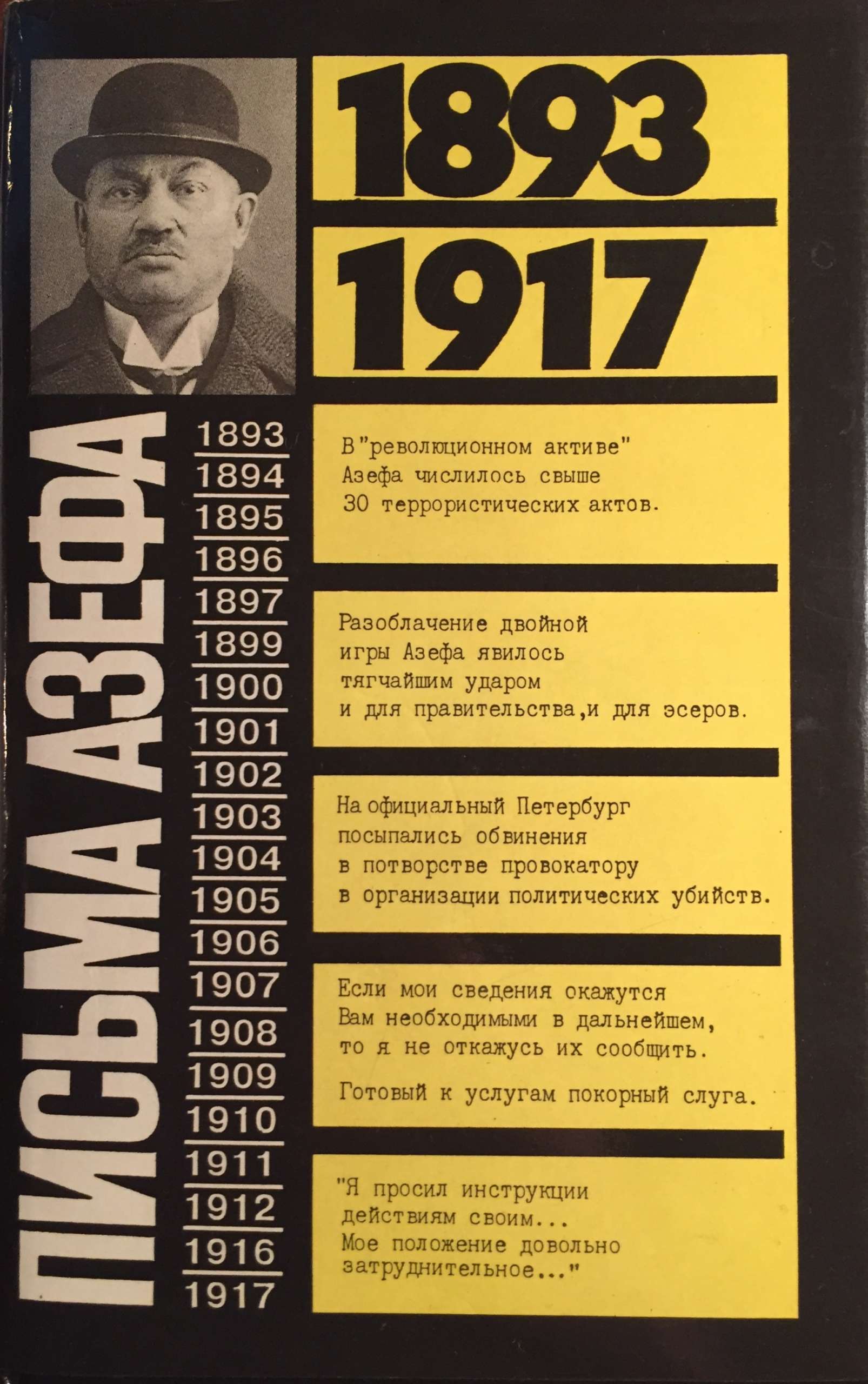 Hardcover volume 20.7 x 13.4 cm, bound in black buckram with blind and grey lettering to front and grey lettering to spine, in a pictorial dust jacket, yellow pictorial endpapers, pp.: [2] 3-287 [1], collated in 16mo, 1-916, 144 leaves, 288 pages. Title-page: ПИСЬМА АЗЕФА | — | 1893 – 1917 | — | [blank] | {publisher’s device} | МОСКВА | «ТЕРРА» — «TERRA» | 1994 || Print run: 10,000 copies. Азеф, Евгений Филиппович [Евно Фишелевич], [Azef, Yevno] (Jewish-Russian-German, 1869 – 1918) Павлов, Дмитрий Борисович (Russian, b. 1954) Перегудова, Зинаида Ивановна (Russian, b. 1934)
Hardcover volume 20.7 x 13.4 cm, bound in black buckram with blind and grey lettering to front and grey lettering to spine, in a pictorial dust jacket, yellow pictorial endpapers, pp.: [2] 3-287 [1], collated in 16mo, 1-916, 144 leaves, 288 pages. Title-page: ПИСЬМА АЗЕФА | — | 1893 – 1917 | — | [blank] | {publisher’s device} | МОСКВА | «ТЕРРА» — «TERRA» | 1994 || Print run: 10,000 copies. Азеф, Евгений Филиппович [Евно Фишелевич], [Azef, Yevno] (Jewish-Russian-German, 1869 – 1918) Павлов, Дмитрий Борисович (Russian, b. 1954) Перегудова, Зинаида Ивановна (Russian, b. 1934) -
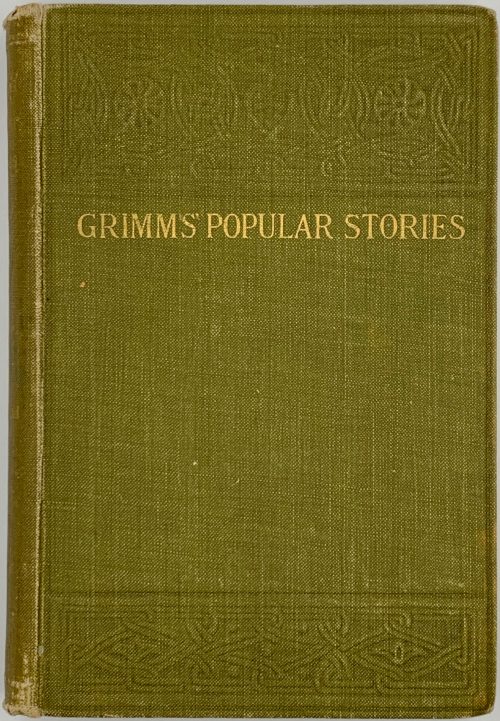 Title: OXFORD EDITION | POPULAR STORIES | COLLECTED BY | THE BROTHERS GRIMM | A REPRINT OF THE FIRST ENGLISH EDITION | WITH TWENTY-TWO ILLUSTRATIONS | BY GEORGE CRUIKSHANK | {publisher’s device} | HENRY FROWDE | LONDON, EDINBURGH, GLASGOW | NEW YORK AND TORONTO | 1905 || Pagination: [i, ii] – frontis., [iii-iv]– t.p. / imprint. [v] – preface, vi-xvii [xviii blank], [2] [1] 2-403 [404], plates included in pagination, pp. 379-403 – notes. Collation: a8 b2 B-Z8 Aa-Cc8 Dd2. Binding:1 9 x 13 cm, olive green cloth blind-stamped in art nouveau style and lettered in gilt to cover and spine: GRIMMS’ POPULAR STORIES. Aubergine pencil inscription to front pastedown: C. Grant Robertson | All Souls | 1905: Provenance: Sir Charles Grant Robertson CVO (British, 1869 – 1948) who was a British academic historian, a Fellow of All Souls College, Oxford, and Vice-chancellor of the University of Birmingham.
Title: OXFORD EDITION | POPULAR STORIES | COLLECTED BY | THE BROTHERS GRIMM | A REPRINT OF THE FIRST ENGLISH EDITION | WITH TWENTY-TWO ILLUSTRATIONS | BY GEORGE CRUIKSHANK | {publisher’s device} | HENRY FROWDE | LONDON, EDINBURGH, GLASGOW | NEW YORK AND TORONTO | 1905 || Pagination: [i, ii] – frontis., [iii-iv]– t.p. / imprint. [v] – preface, vi-xvii [xviii blank], [2] [1] 2-403 [404], plates included in pagination, pp. 379-403 – notes. Collation: a8 b2 B-Z8 Aa-Cc8 Dd2. Binding:1 9 x 13 cm, olive green cloth blind-stamped in art nouveau style and lettered in gilt to cover and spine: GRIMMS’ POPULAR STORIES. Aubergine pencil inscription to front pastedown: C. Grant Robertson | All Souls | 1905: Provenance: Sir Charles Grant Robertson CVO (British, 1869 – 1948) who was a British academic historian, a Fellow of All Souls College, Oxford, and Vice-chancellor of the University of Birmingham. -
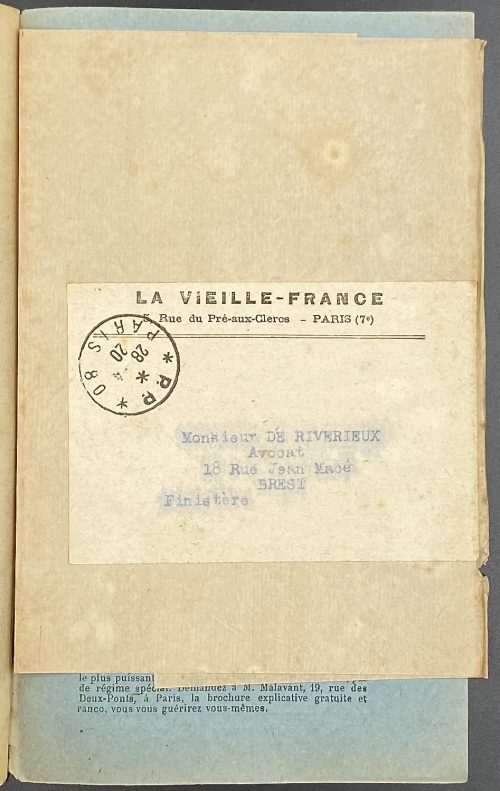 50 issues (full 1920 year) of the French anti-Semitic journal La Vieille France published by Urbain Gohier in Paris from 1916 to 1924. LIB-LIB-2731-1.2021 to LIB-2731-50.2021.
50 issues (full 1920 year) of the French anti-Semitic journal La Vieille France published by Urbain Gohier in Paris from 1916 to 1924. LIB-LIB-2731-1.2021 to LIB-2731-50.2021. -
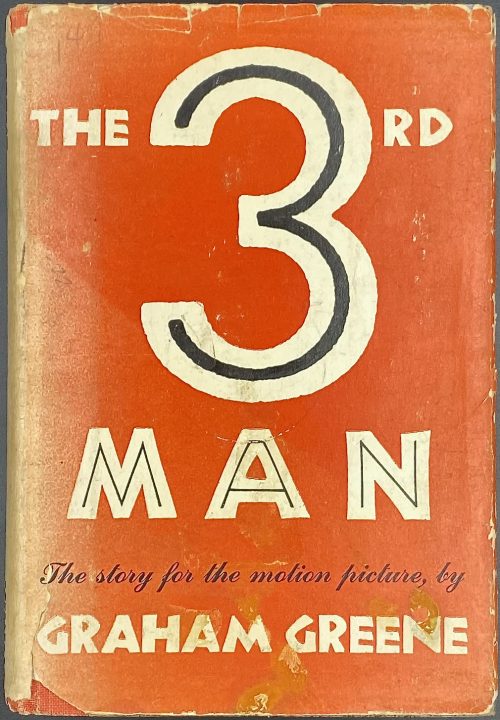 Title page: GRAHAM | GREENE | {vignette} | THE | THIRD MAN | NEW YORK • THE VIKING PRESS • 1950 || Title verso: COPYRIGHT 1949, 1950 BY GRAHAM GREENE | PUBLISHED BY THE VIKING PRESS IN MARCH 1950 | PUBLISHED ON THE SAME DAY IN THE DOMINION OF CANADA | BY THE MACMILLAN COMPANY OF CANADA LIMITED | A condensed version appeared | in The American Magazine, | {publisher’s device} | PRINTED IN U.S.A. BY THE COLONIAL PRESS INC. || Pagination: [1-6] 7-157 [158] [2] blank. Binding: quarter red cloth over grey cloth boards with black lettering to spine, pictorial dust jacket with lettering to front, back and spine, unclipped, $2.00 in the upper-right corner of the front flap. Size:19.5 x 13.5 cm. Edition: 1st American edition. Contributors: Henry Graham Greene (British, 1904 – 1991) – author. The Viking Press, NY (1925 – 1975) – publisher. The Colonial Press, Inc – printer.
Title page: GRAHAM | GREENE | {vignette} | THE | THIRD MAN | NEW YORK • THE VIKING PRESS • 1950 || Title verso: COPYRIGHT 1949, 1950 BY GRAHAM GREENE | PUBLISHED BY THE VIKING PRESS IN MARCH 1950 | PUBLISHED ON THE SAME DAY IN THE DOMINION OF CANADA | BY THE MACMILLAN COMPANY OF CANADA LIMITED | A condensed version appeared | in The American Magazine, | {publisher’s device} | PRINTED IN U.S.A. BY THE COLONIAL PRESS INC. || Pagination: [1-6] 7-157 [158] [2] blank. Binding: quarter red cloth over grey cloth boards with black lettering to spine, pictorial dust jacket with lettering to front, back and spine, unclipped, $2.00 in the upper-right corner of the front flap. Size:19.5 x 13.5 cm. Edition: 1st American edition. Contributors: Henry Graham Greene (British, 1904 – 1991) – author. The Viking Press, NY (1925 – 1975) – publisher. The Colonial Press, Inc – printer. -
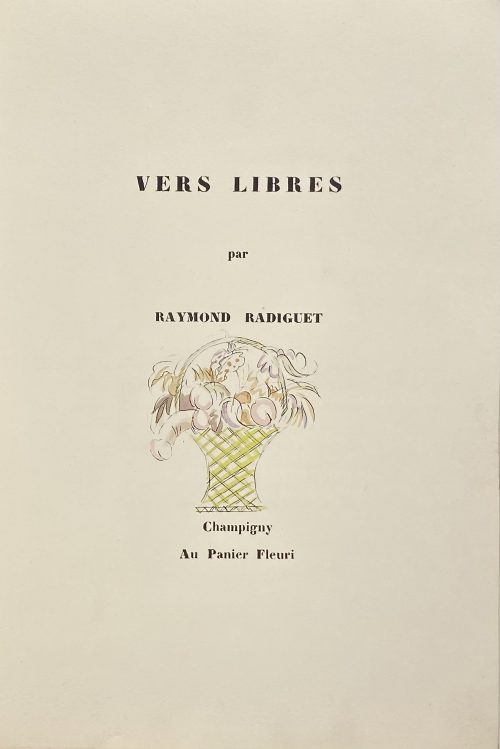 Unbound, unpaginated album (28.5 x 19.5 cm) with 22 leaves (11 folded sheets 28 x 38 cm each), printed on thick wove paper watermarked Arches with text and 27 vignettes, in a 29 x 20 cm slightly beige slipcase. Publisher’s original flapped cream wrappers, lettering to front over the vignette: VERS LIBRES | par | RAYMOND RADIGUET | Champigny | Au Panier Fleuri || Half-title: VERS LIBRES over a ribbon covering a stick, garland, and flute. Title: VERS LIBRES | par | RAYMOND RADIGUET || {vignette} | Champigny | Au Panier Fleuri || Section title: VERS LIBRES over a vignette of a girl in a hat and with an umbrella on a beach. Illustrations: Cover vignette, frontispiece, tail- and a headpiece for the Note, and vignettes (total 27 illustrations) attributed Rojan (Feodor Rojankovsky). Poems: Chat perché; Champigny, Usée, Les fiancés de treize ans, Saison, Le petit journal, Ébauches, II Cinématographe. Edition: 1st; Limitation on the last page: the total print run of 125 copies, this copy is № 18. Illustrations printed in black and stencil-coloured (au pochoir). Catalogue raisonné: Dutel 2592; Nordmann (2): 450. Dutel counts vignettes as 27, Christie's (Nordmann) as 28. Dutel writes it is printed on vergé de Hollande (laid paper), our copy is as per Nordmann, on wove Arches. No one mentions the slipcase. The number of leaves: 20 per Dutel, 22 per Nordmann. Why Cinématographe numbered II is unclear. Contributors: Raymond Radiguet (French, 1903 – 1923) – author. Feodor Rojankovsky [Rojan; Рожанковский, Фёдор Степанович] (Russian-American, 1891 – 1970) – artist. Comparison of 1935 and 1937 editions reveals that, as usual, the earlier the better.
Unbound, unpaginated album (28.5 x 19.5 cm) with 22 leaves (11 folded sheets 28 x 38 cm each), printed on thick wove paper watermarked Arches with text and 27 vignettes, in a 29 x 20 cm slightly beige slipcase. Publisher’s original flapped cream wrappers, lettering to front over the vignette: VERS LIBRES | par | RAYMOND RADIGUET | Champigny | Au Panier Fleuri || Half-title: VERS LIBRES over a ribbon covering a stick, garland, and flute. Title: VERS LIBRES | par | RAYMOND RADIGUET || {vignette} | Champigny | Au Panier Fleuri || Section title: VERS LIBRES over a vignette of a girl in a hat and with an umbrella on a beach. Illustrations: Cover vignette, frontispiece, tail- and a headpiece for the Note, and vignettes (total 27 illustrations) attributed Rojan (Feodor Rojankovsky). Poems: Chat perché; Champigny, Usée, Les fiancés de treize ans, Saison, Le petit journal, Ébauches, II Cinématographe. Edition: 1st; Limitation on the last page: the total print run of 125 copies, this copy is № 18. Illustrations printed in black and stencil-coloured (au pochoir). Catalogue raisonné: Dutel 2592; Nordmann (2): 450. Dutel counts vignettes as 27, Christie's (Nordmann) as 28. Dutel writes it is printed on vergé de Hollande (laid paper), our copy is as per Nordmann, on wove Arches. No one mentions the slipcase. The number of leaves: 20 per Dutel, 22 per Nordmann. Why Cinématographe numbered II is unclear. Contributors: Raymond Radiguet (French, 1903 – 1923) – author. Feodor Rojankovsky [Rojan; Рожанковский, Фёдор Степанович] (Russian-American, 1891 – 1970) – artist. Comparison of 1935 and 1937 editions reveals that, as usual, the earlier the better.1935 1937 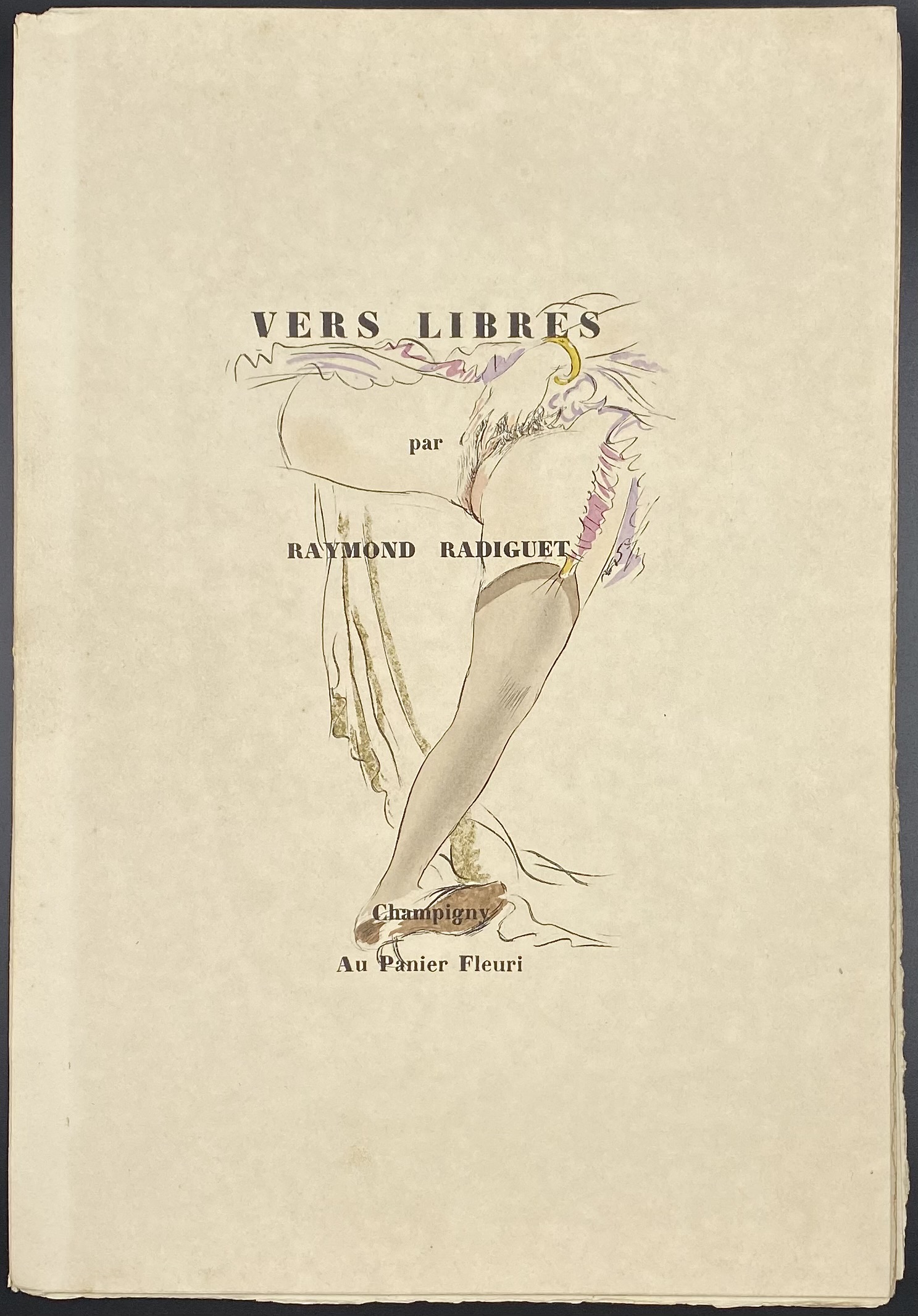
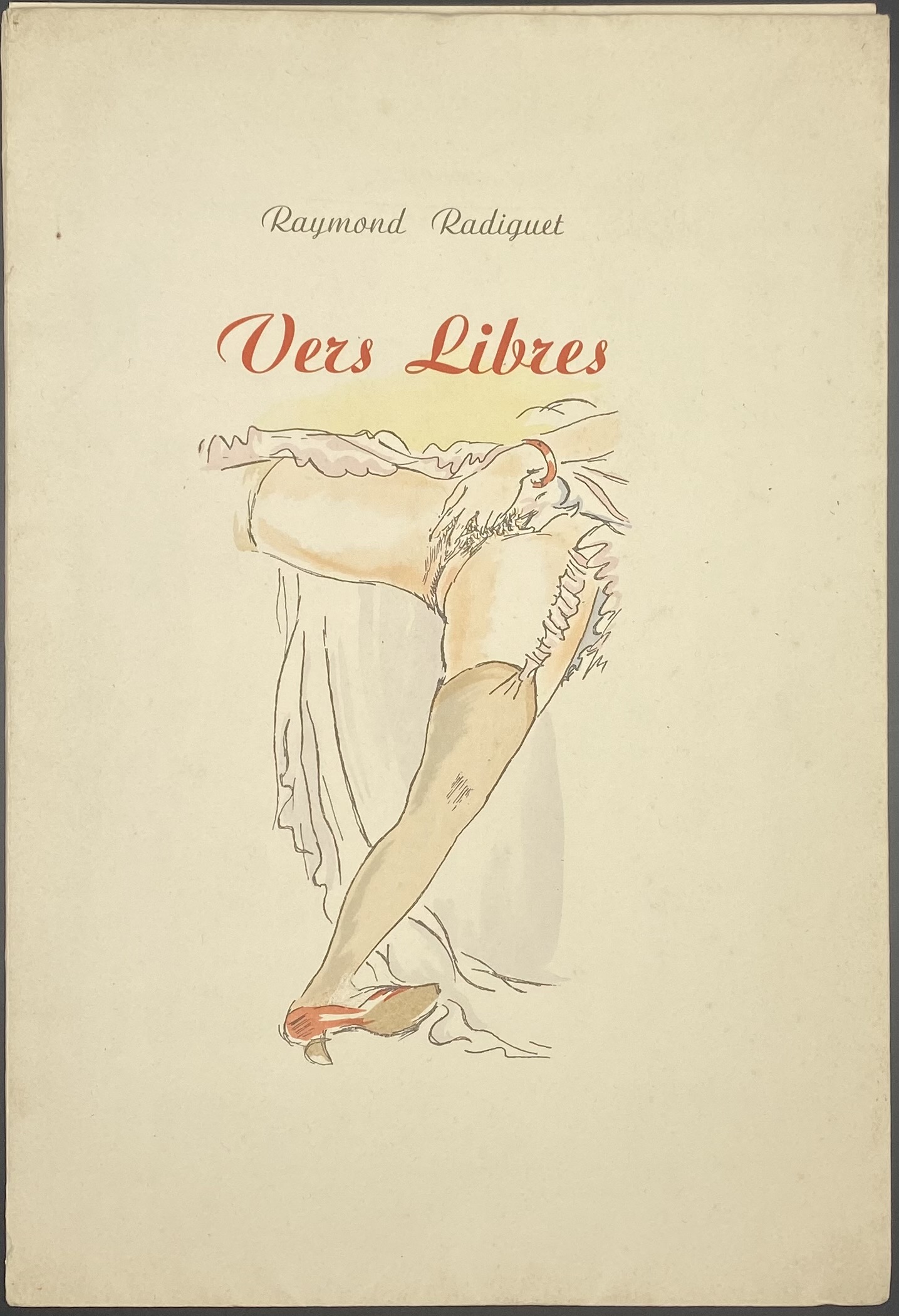
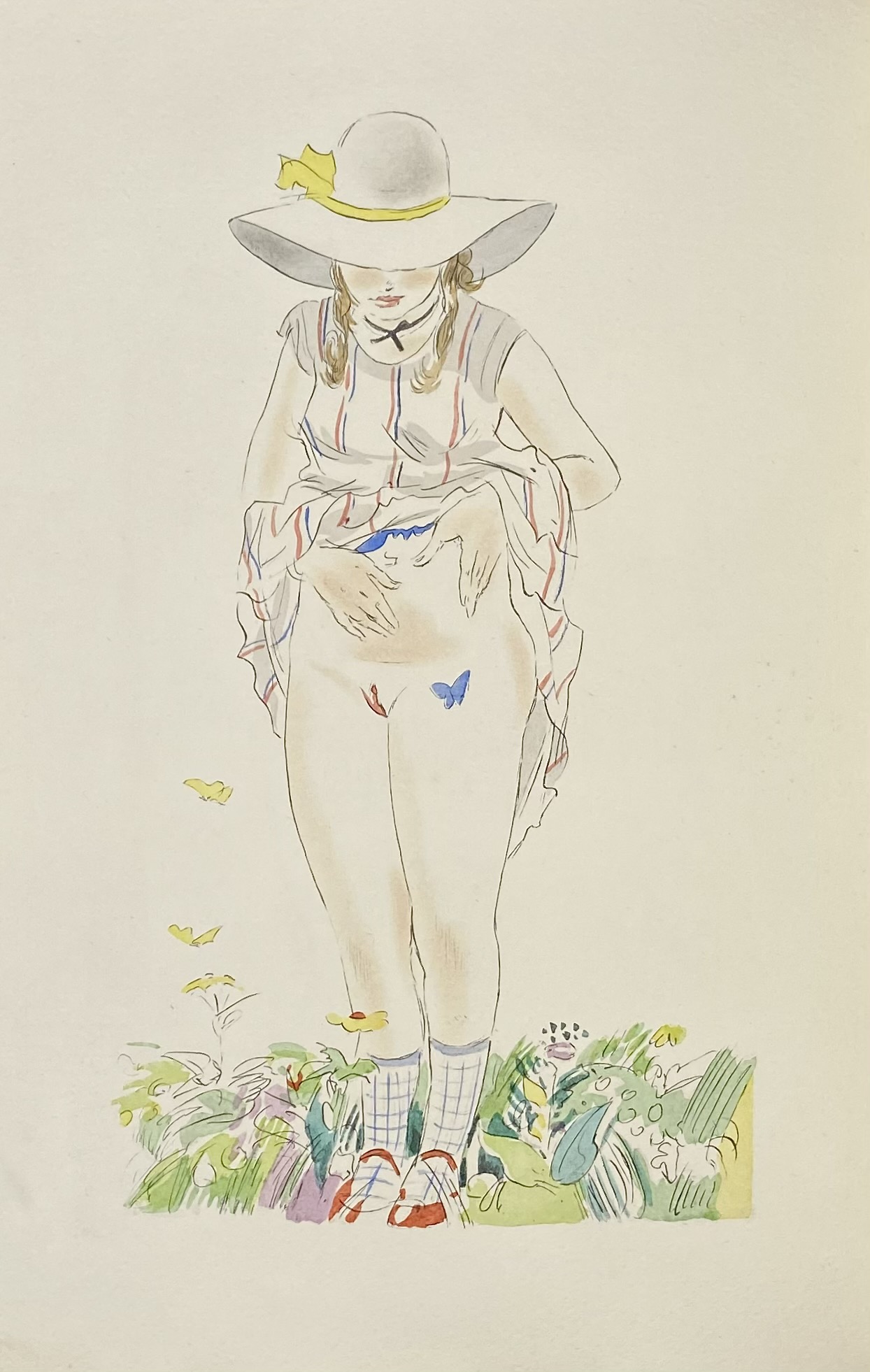
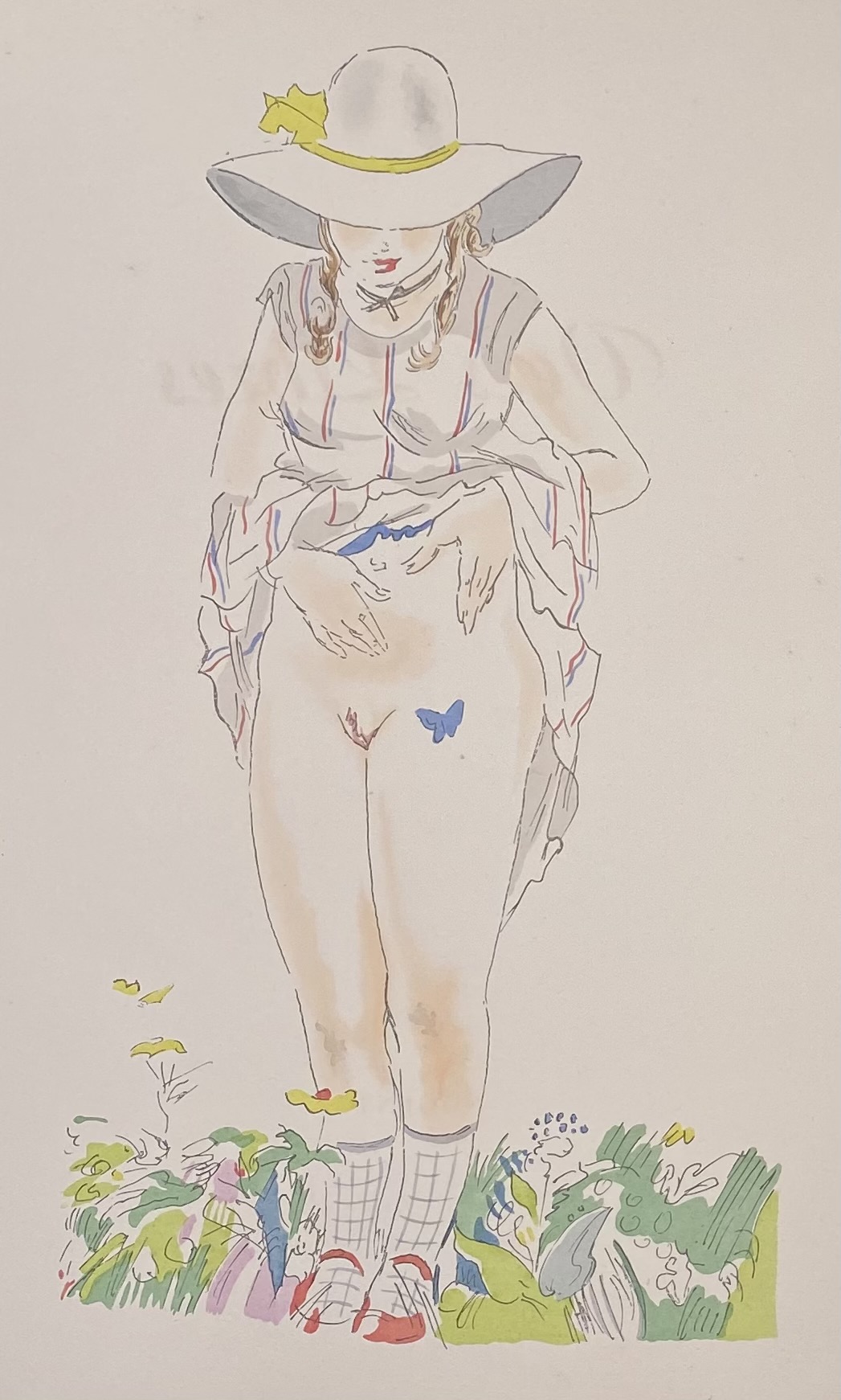
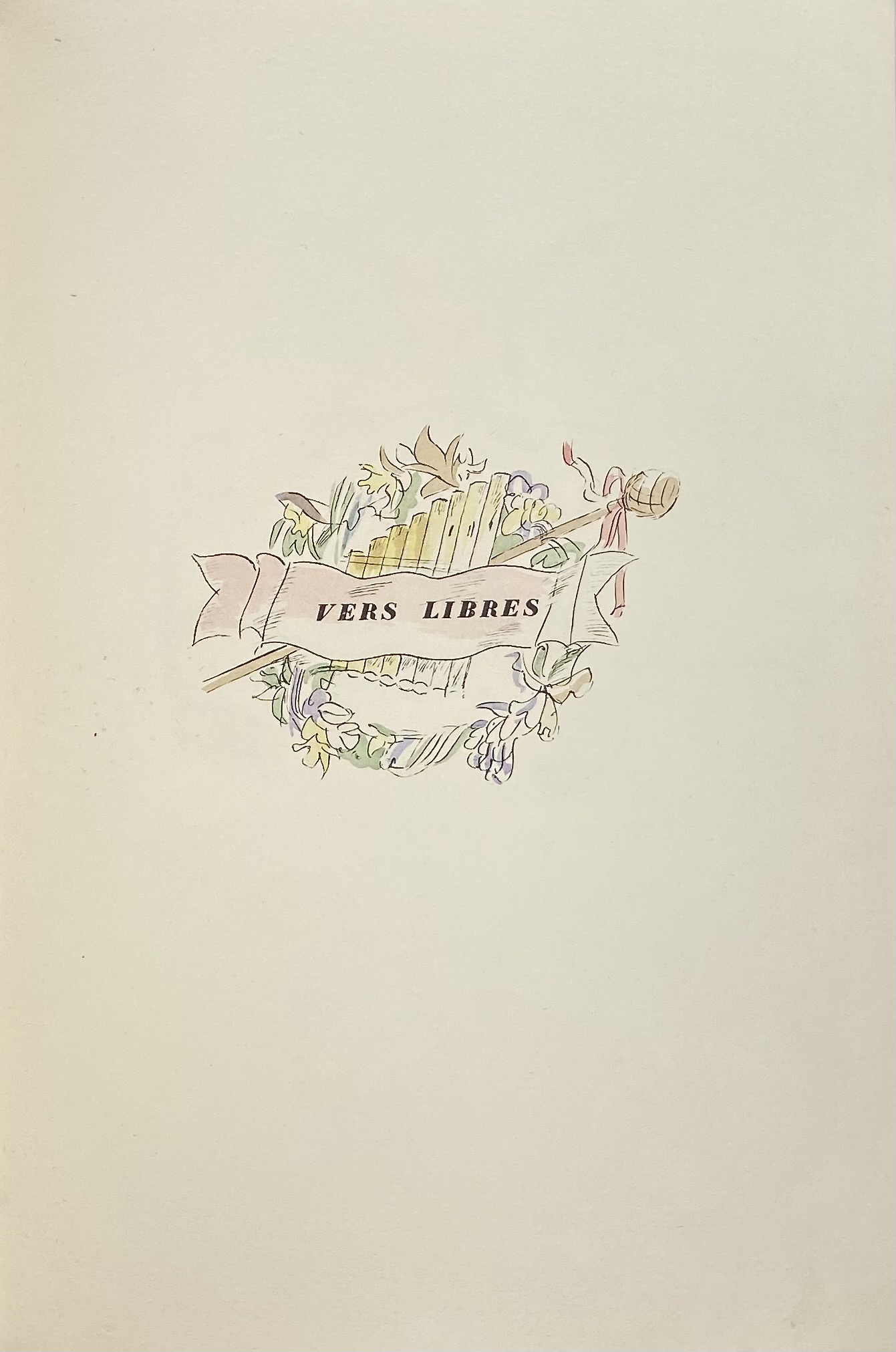
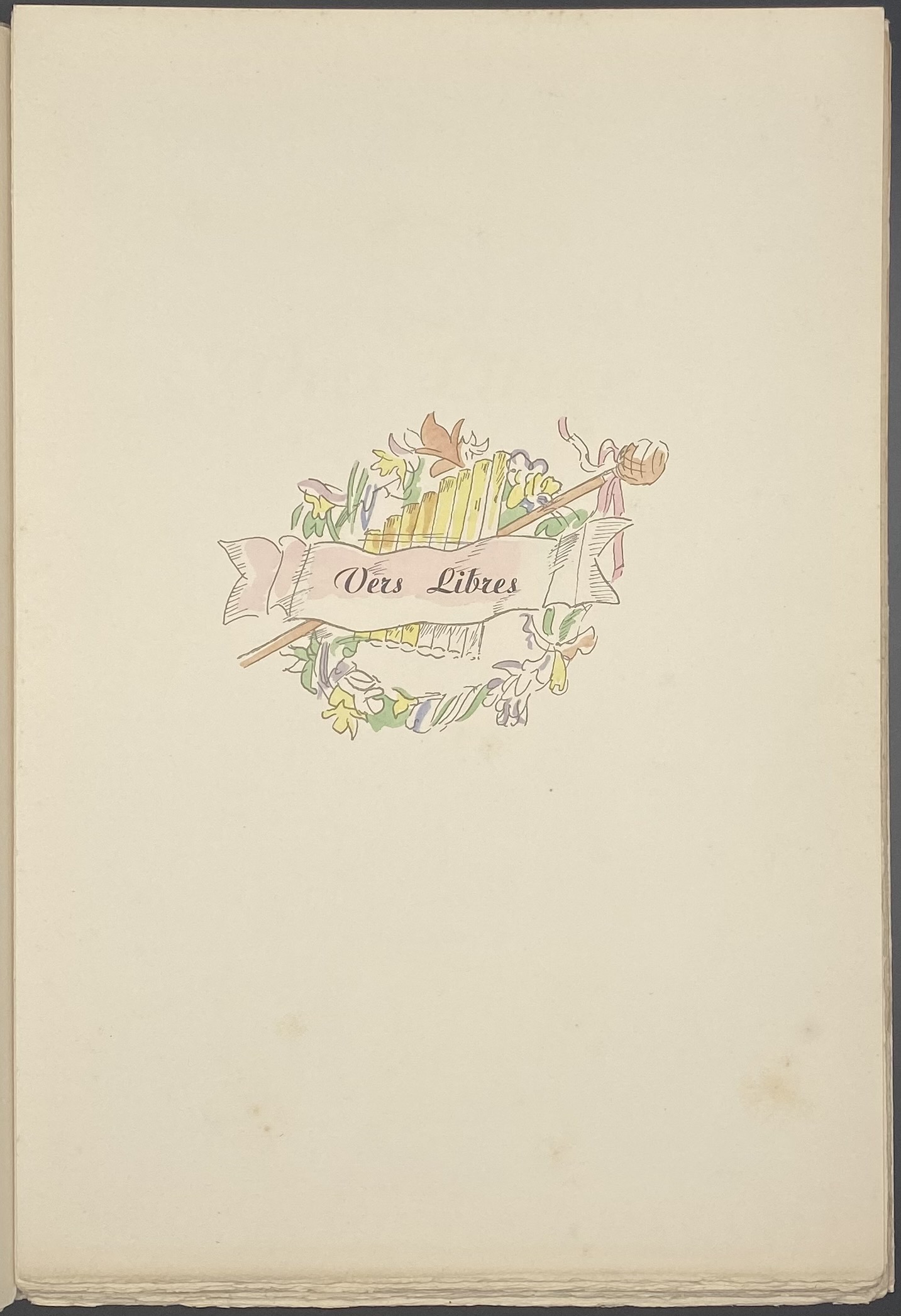
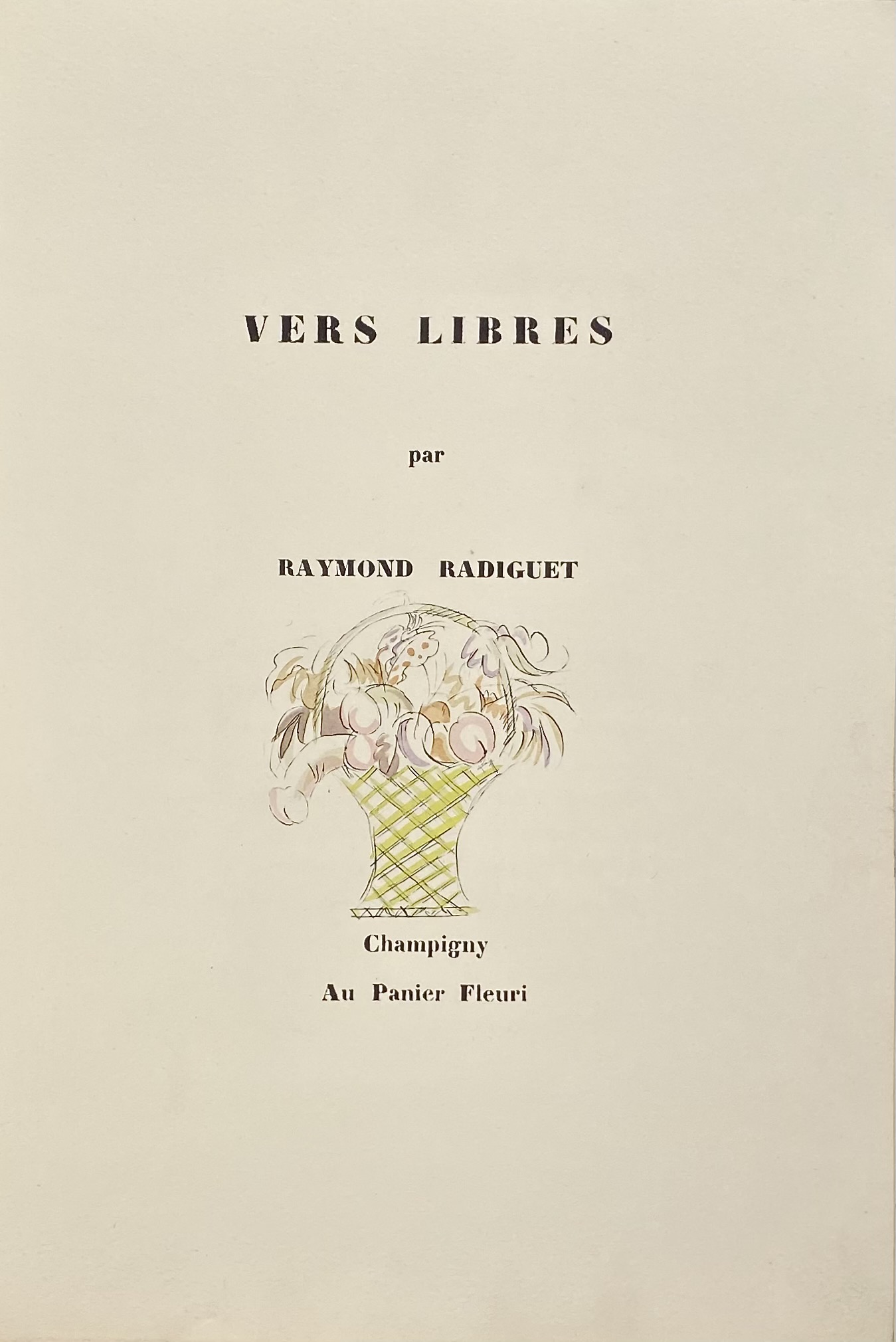
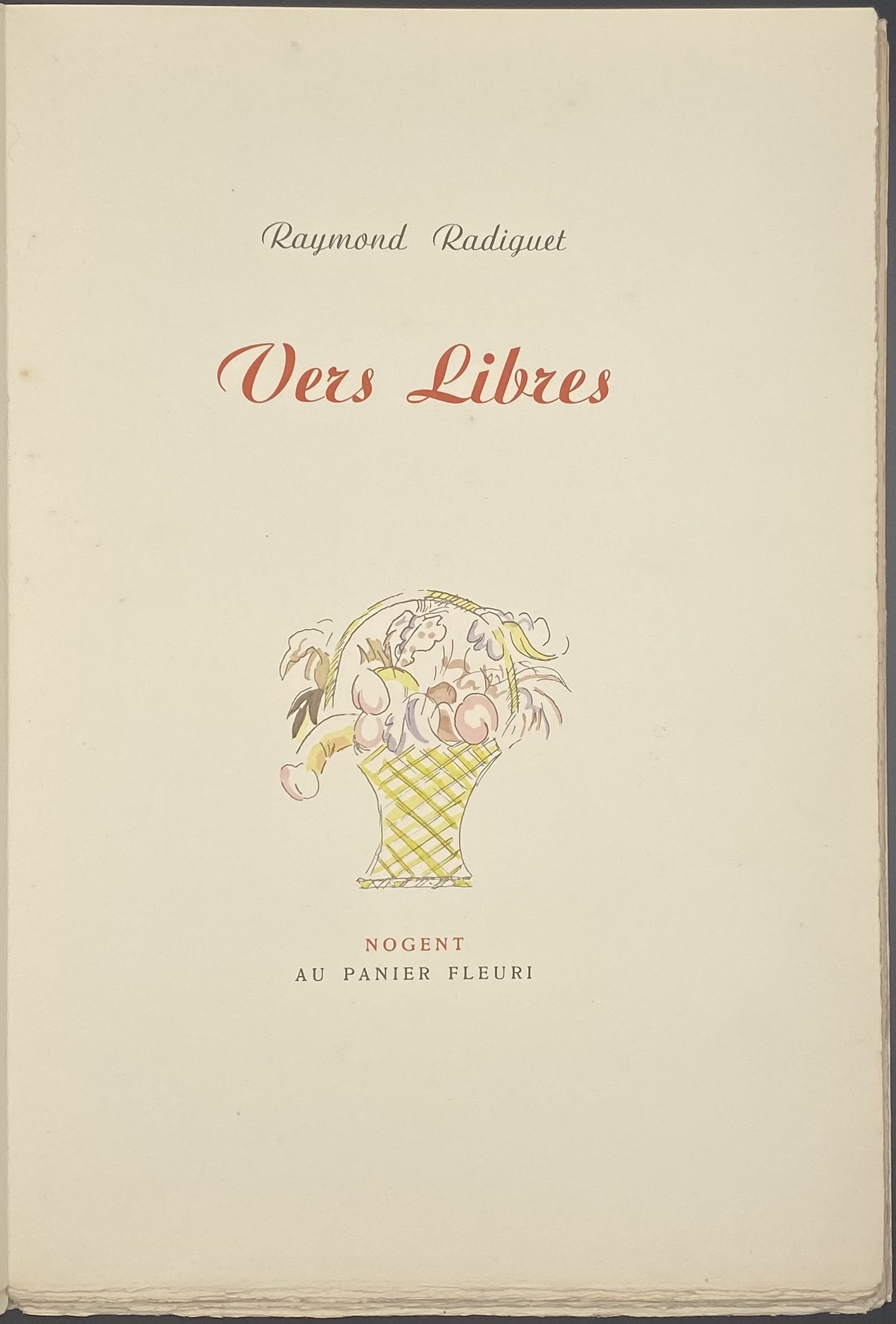
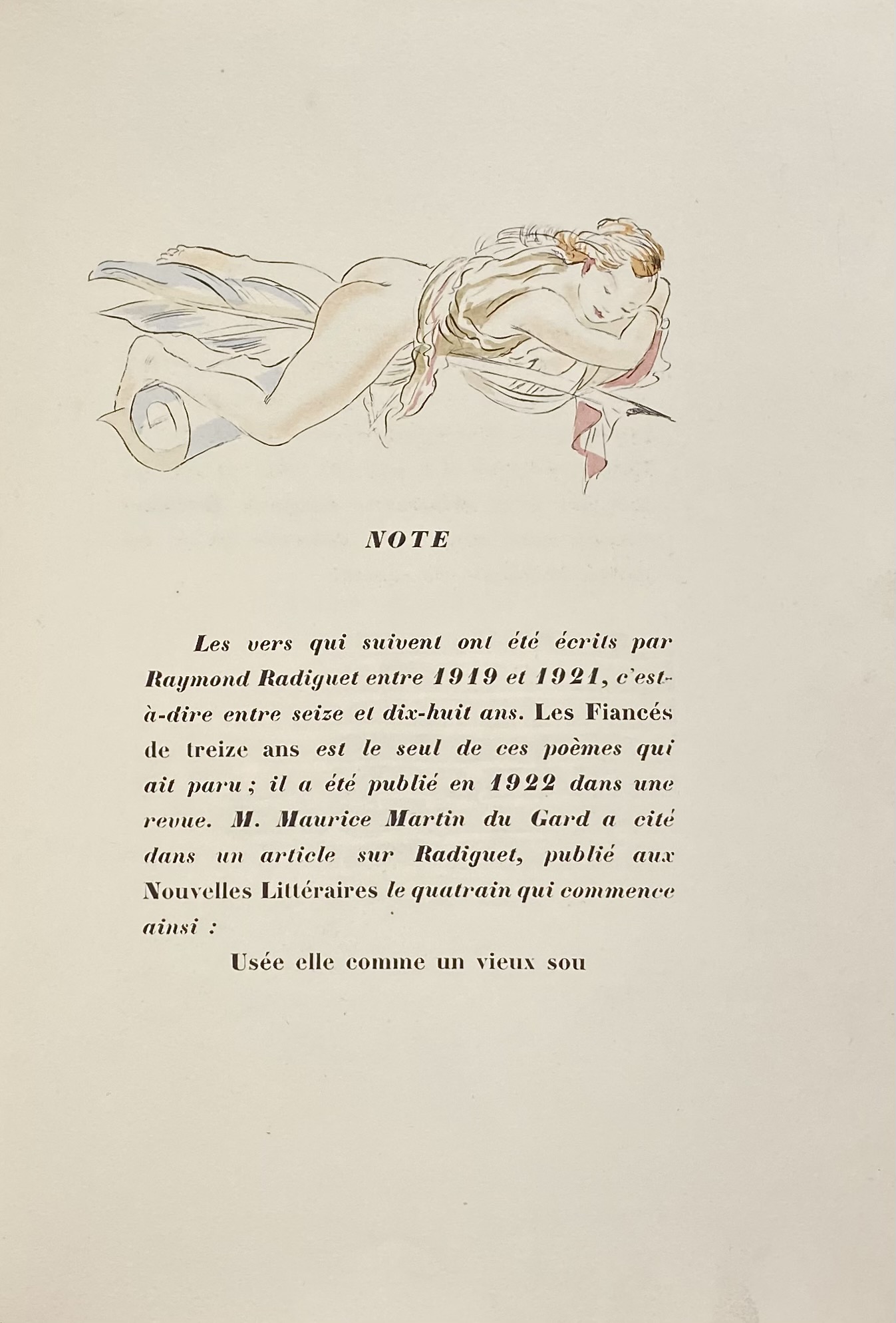
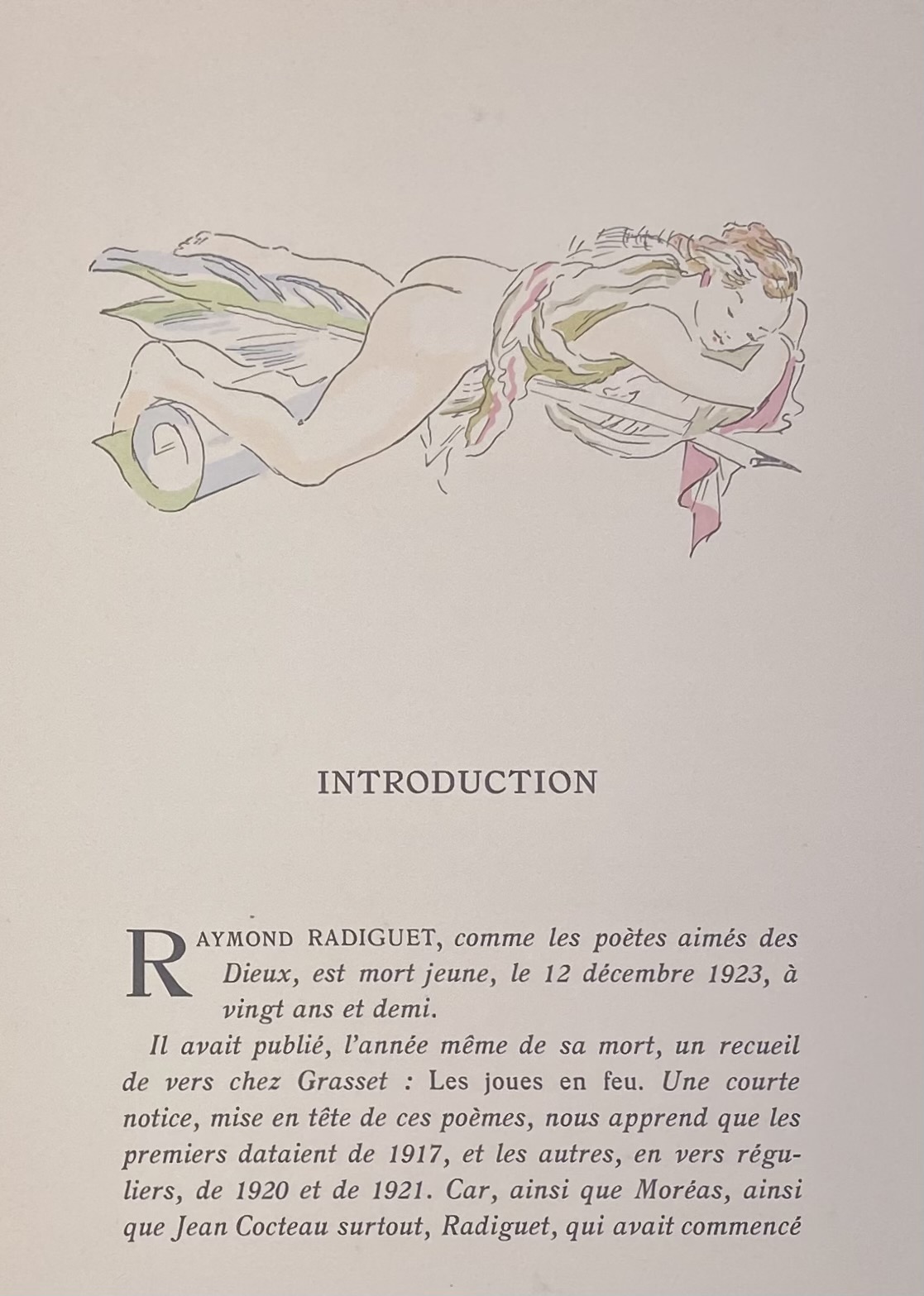
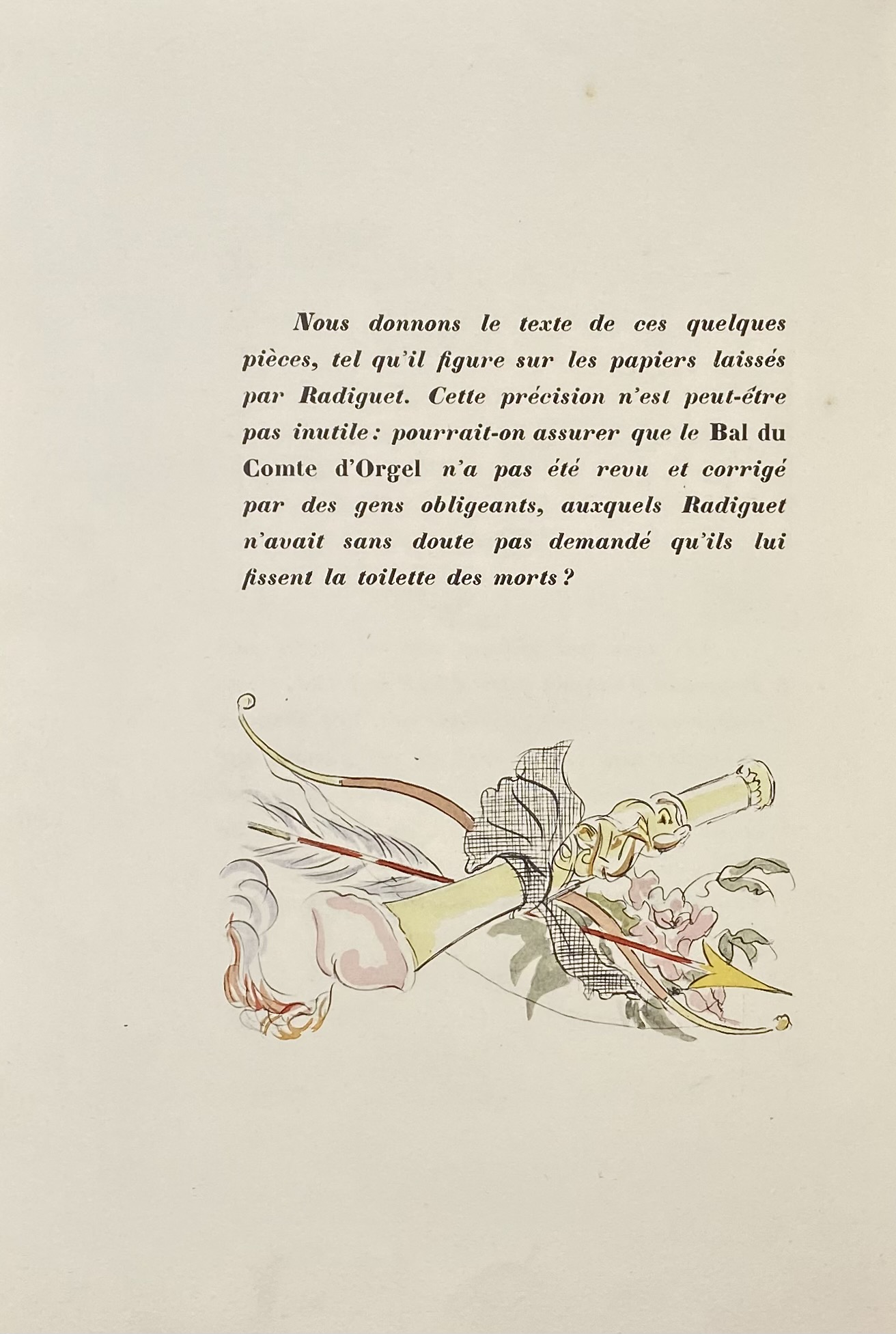
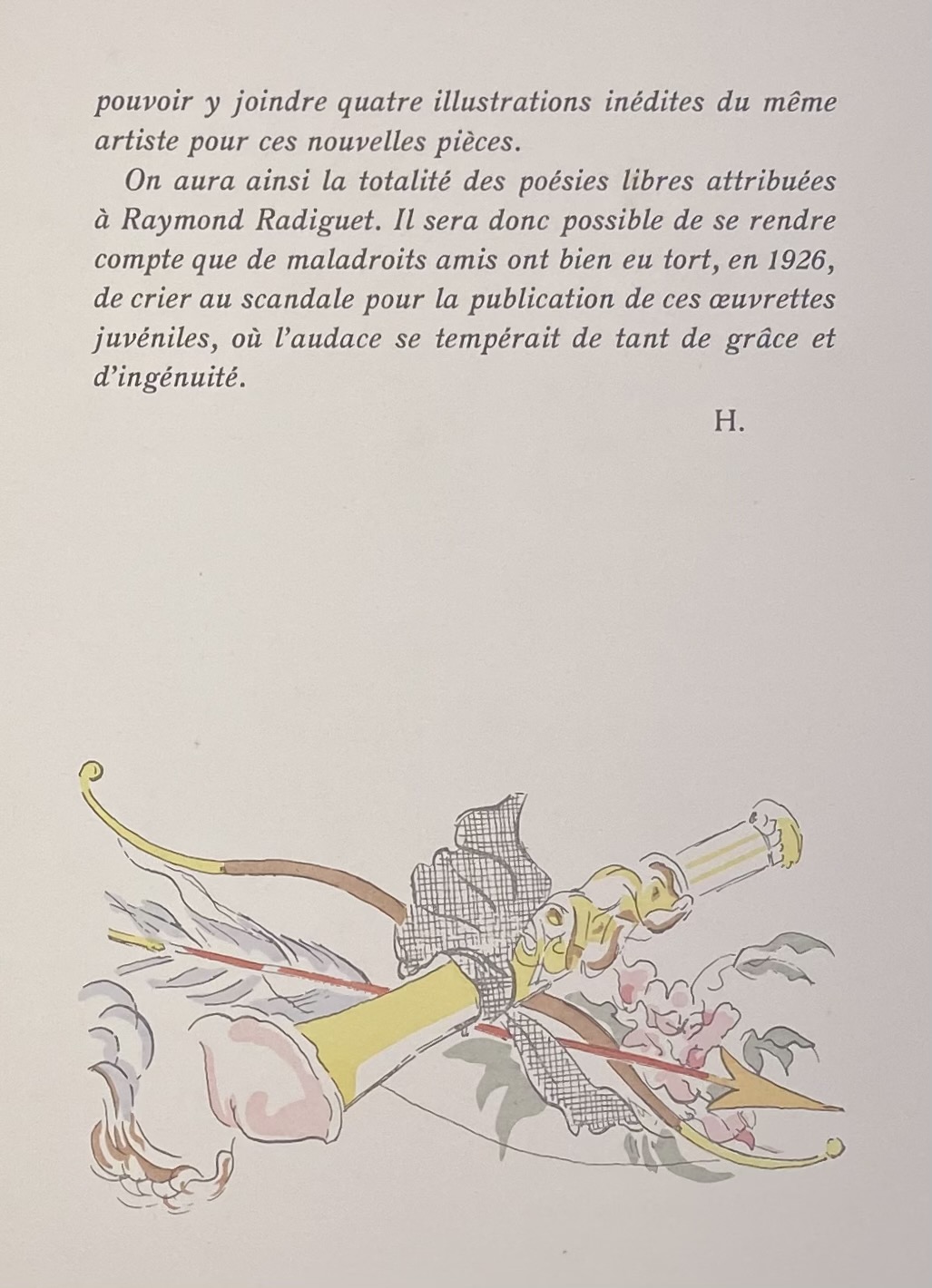
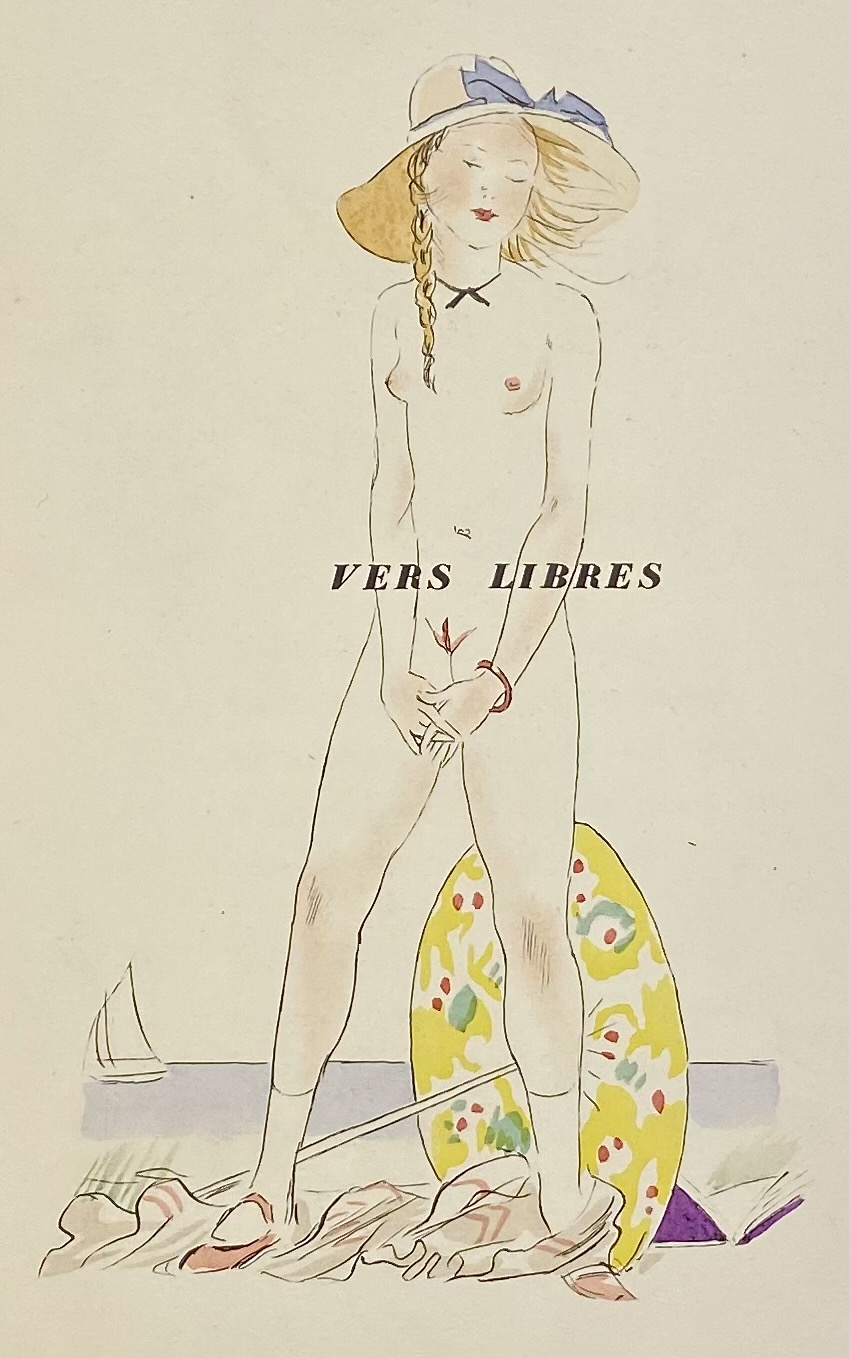
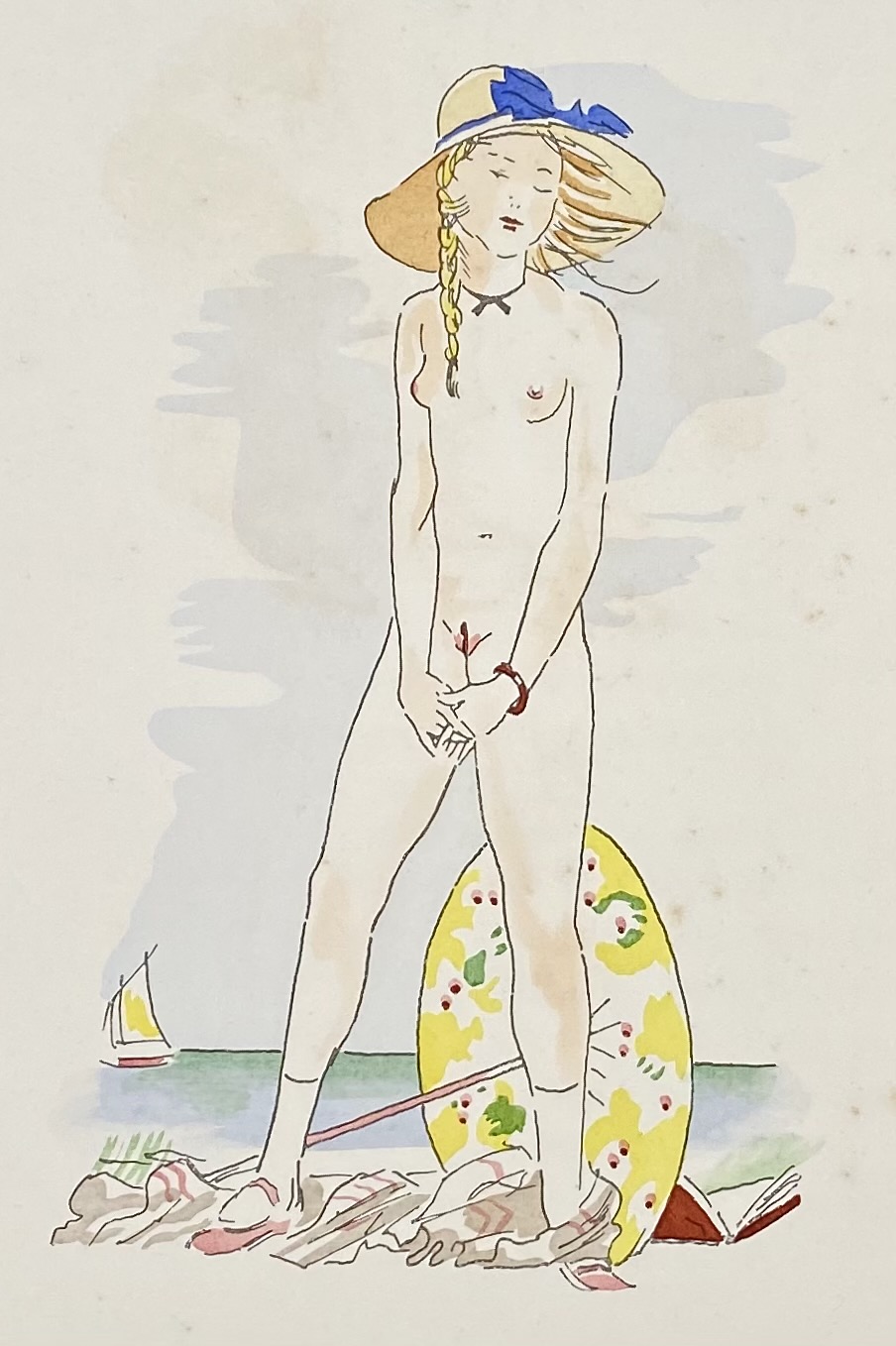
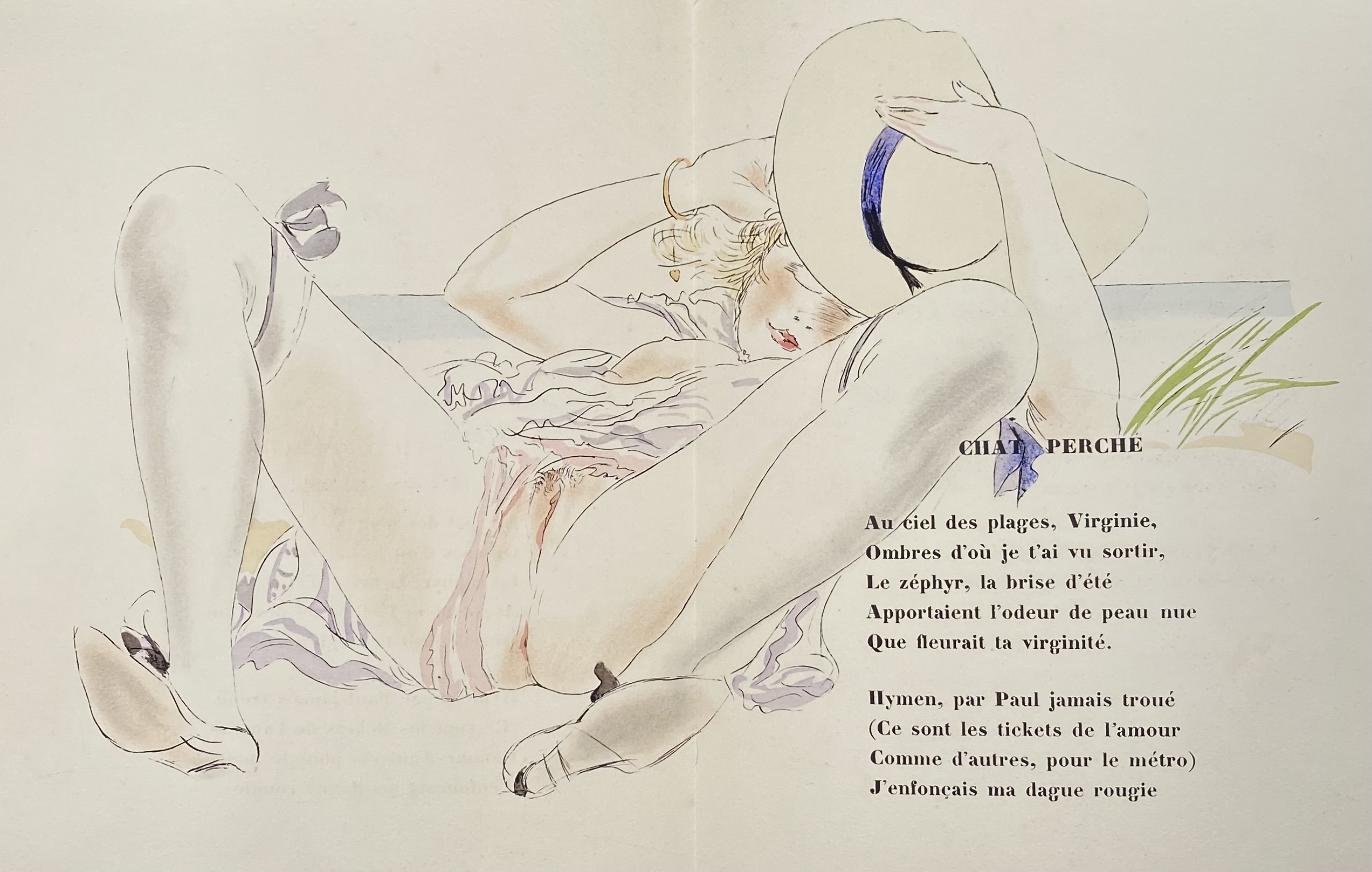
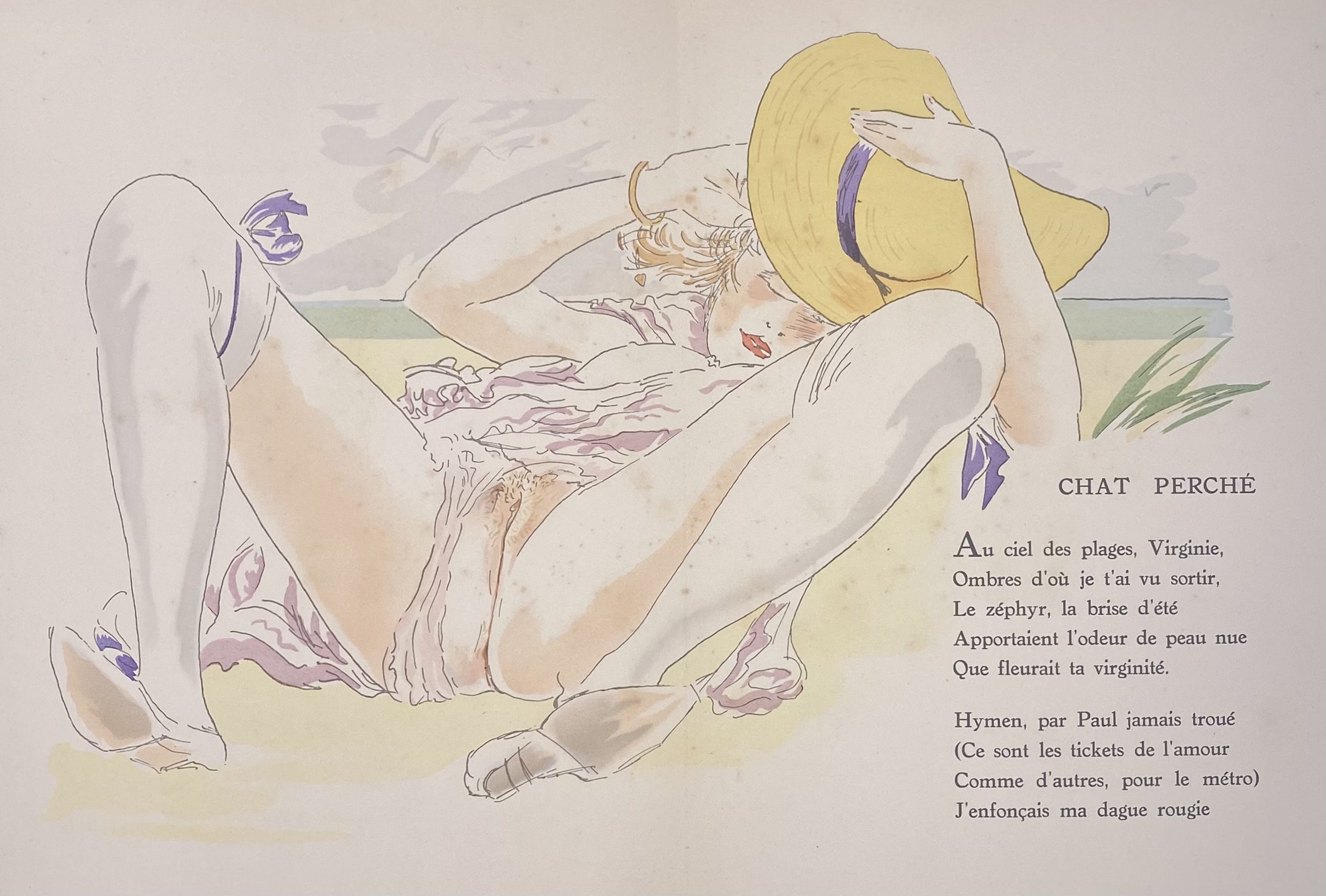
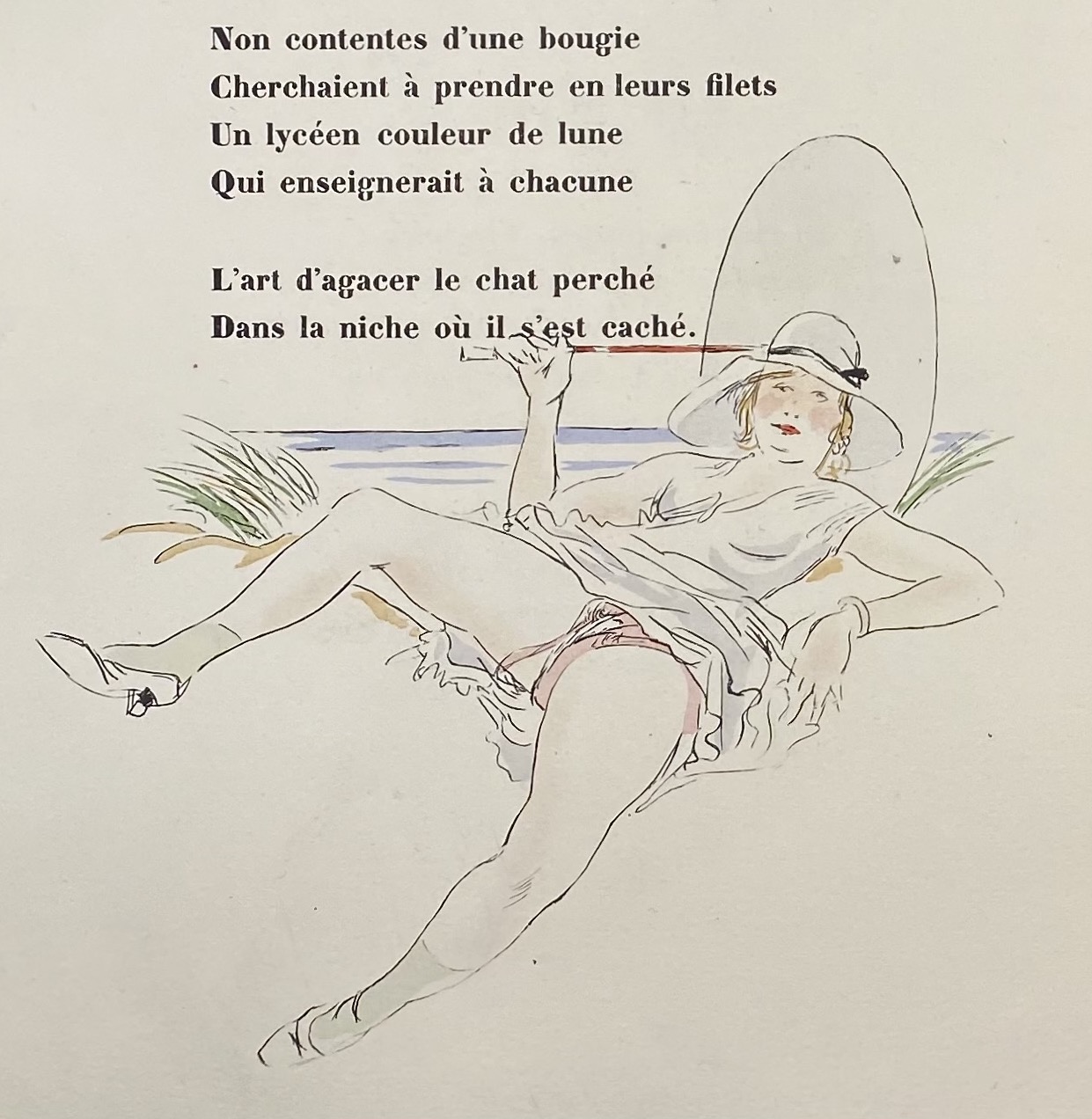
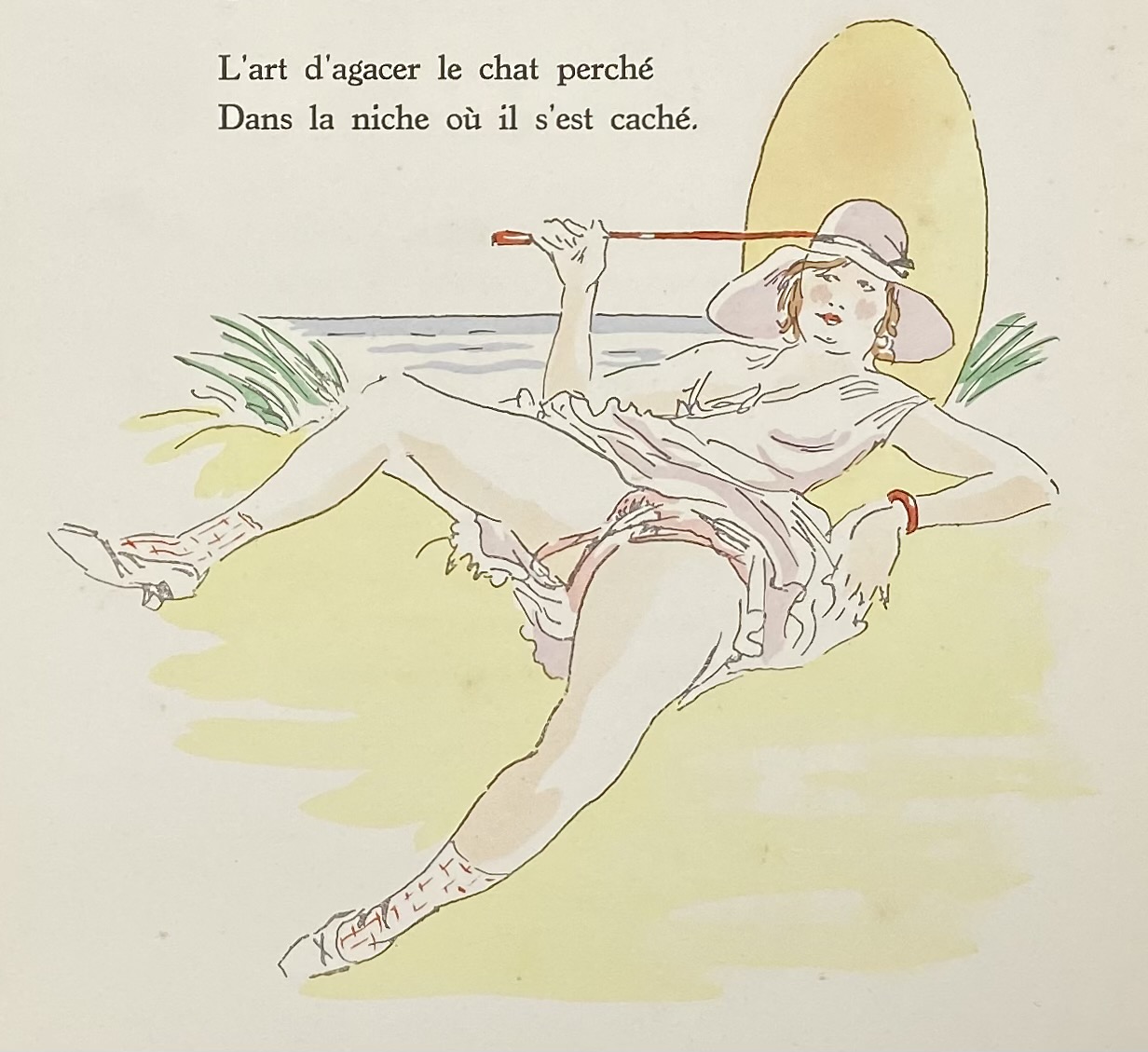
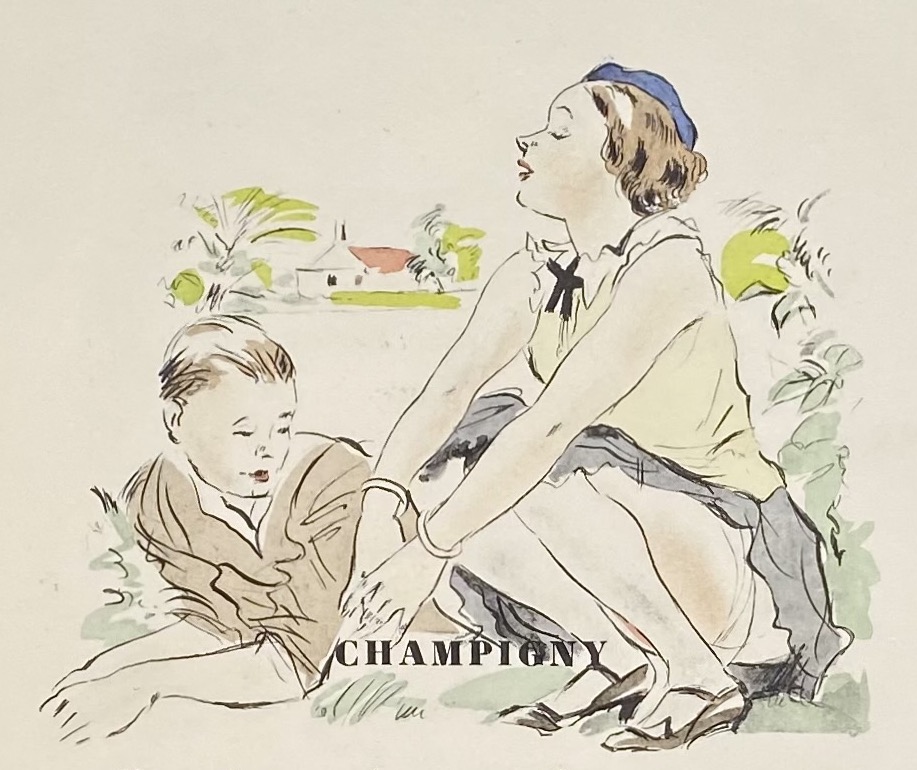
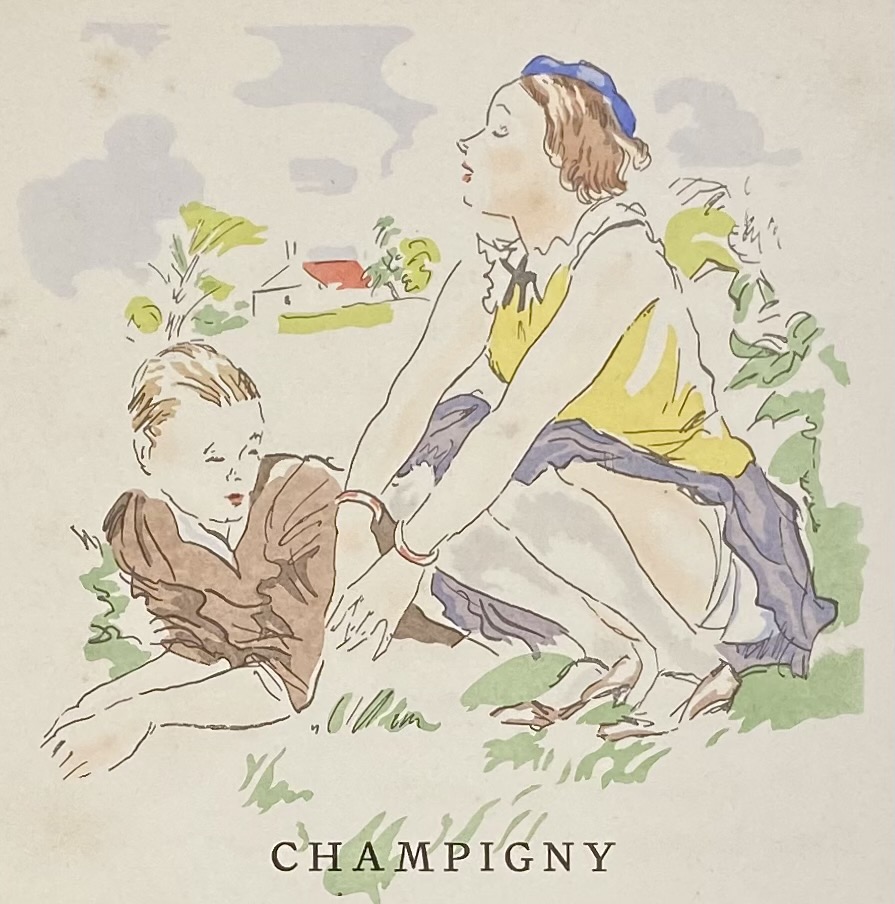
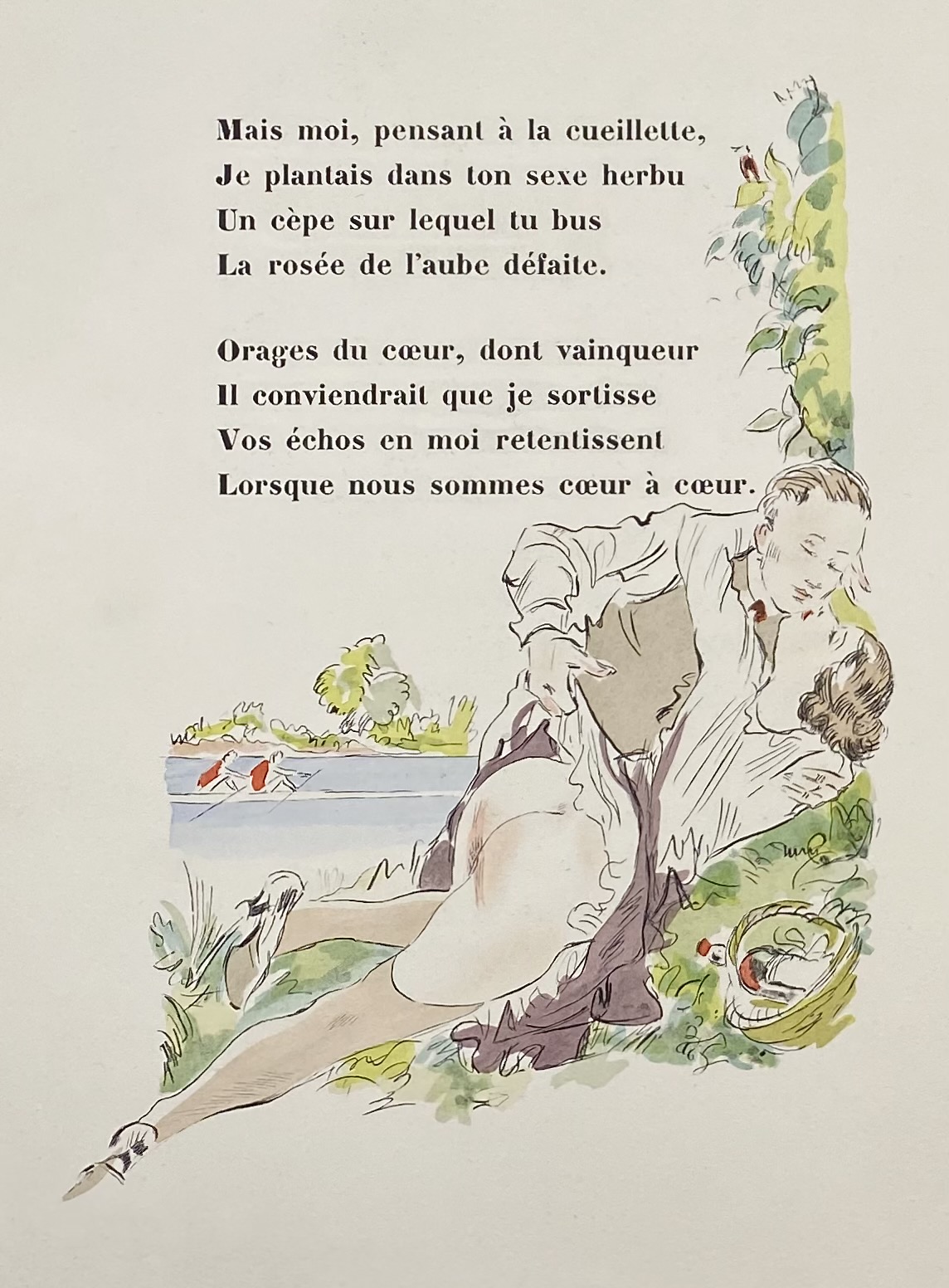
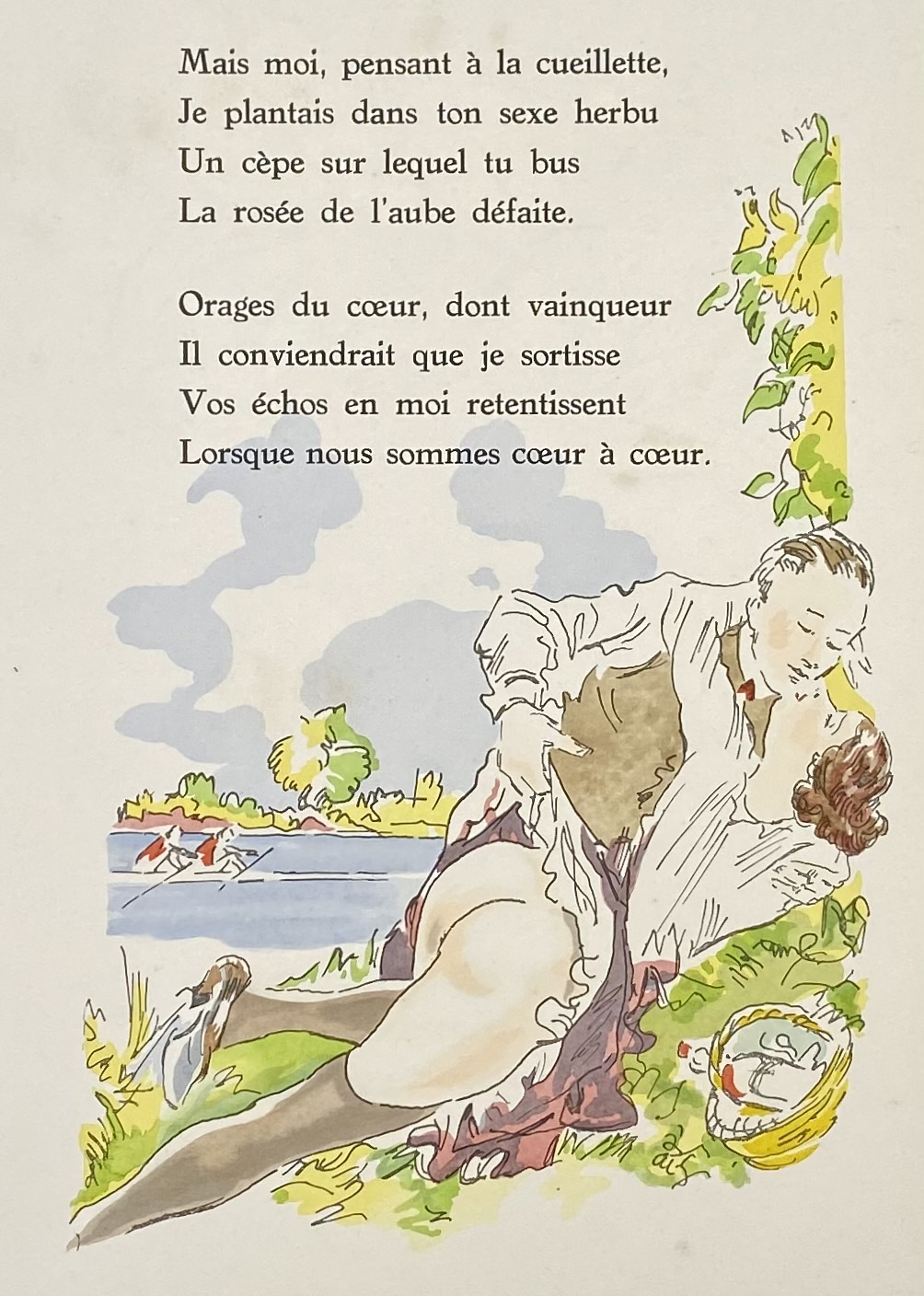
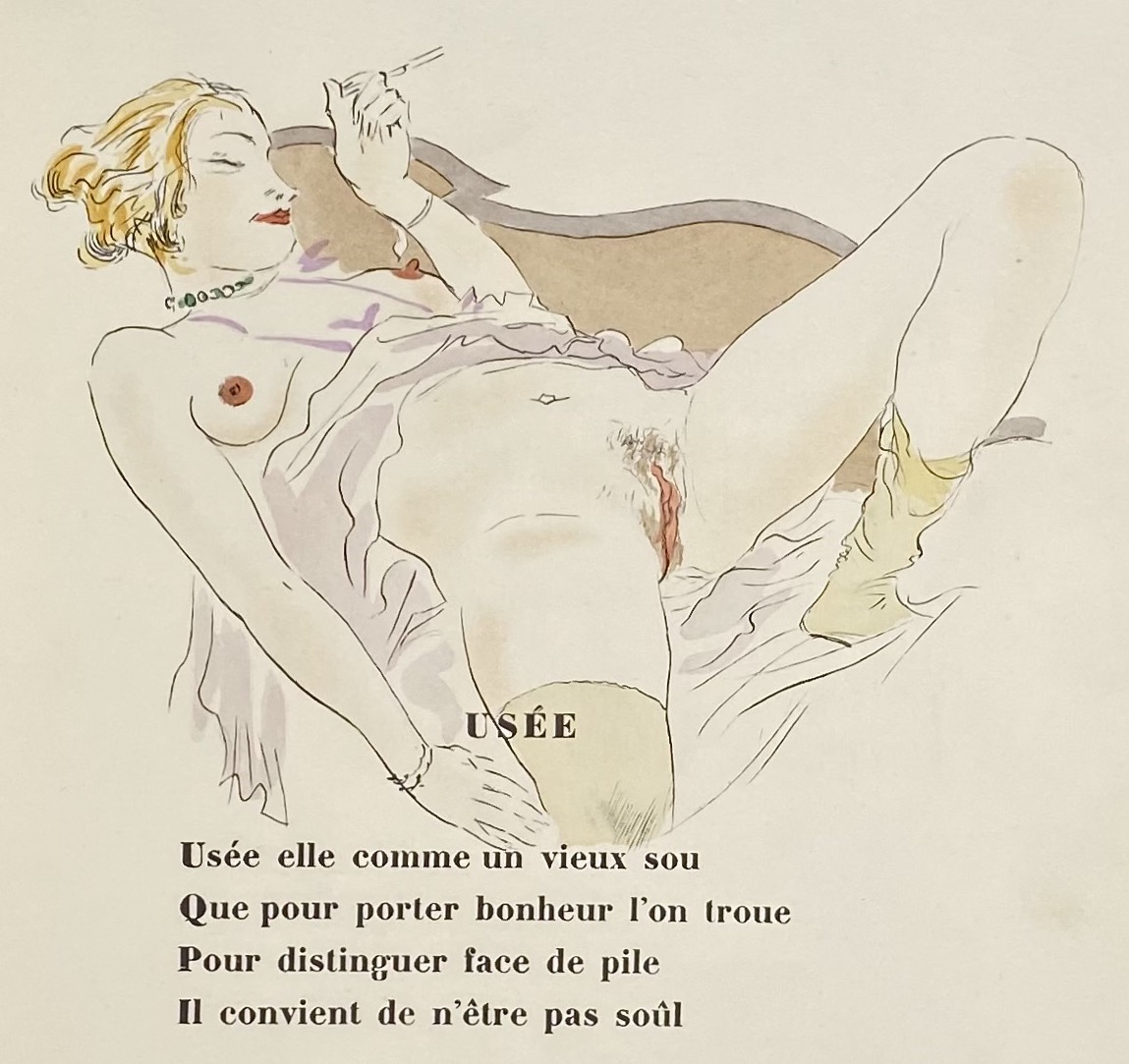
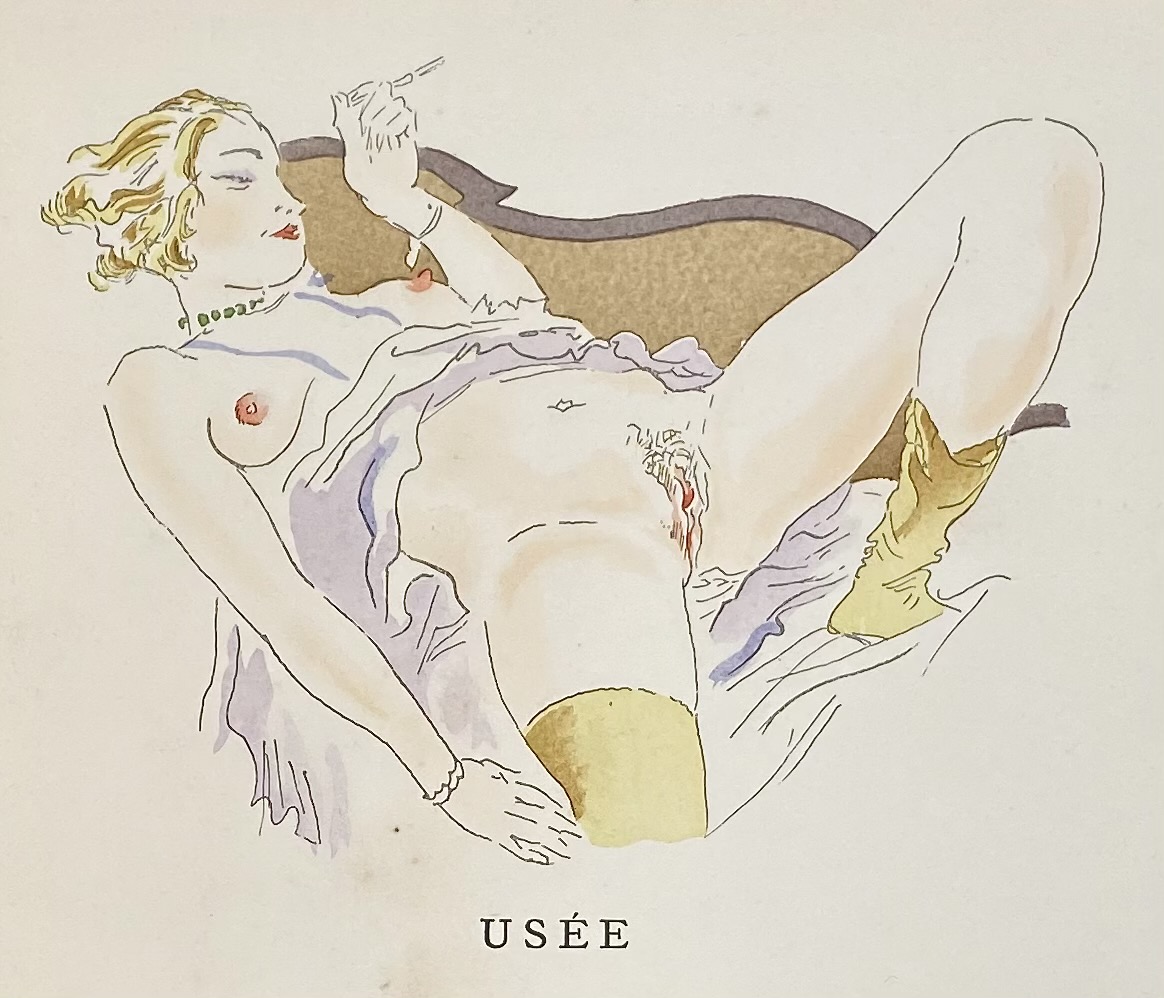
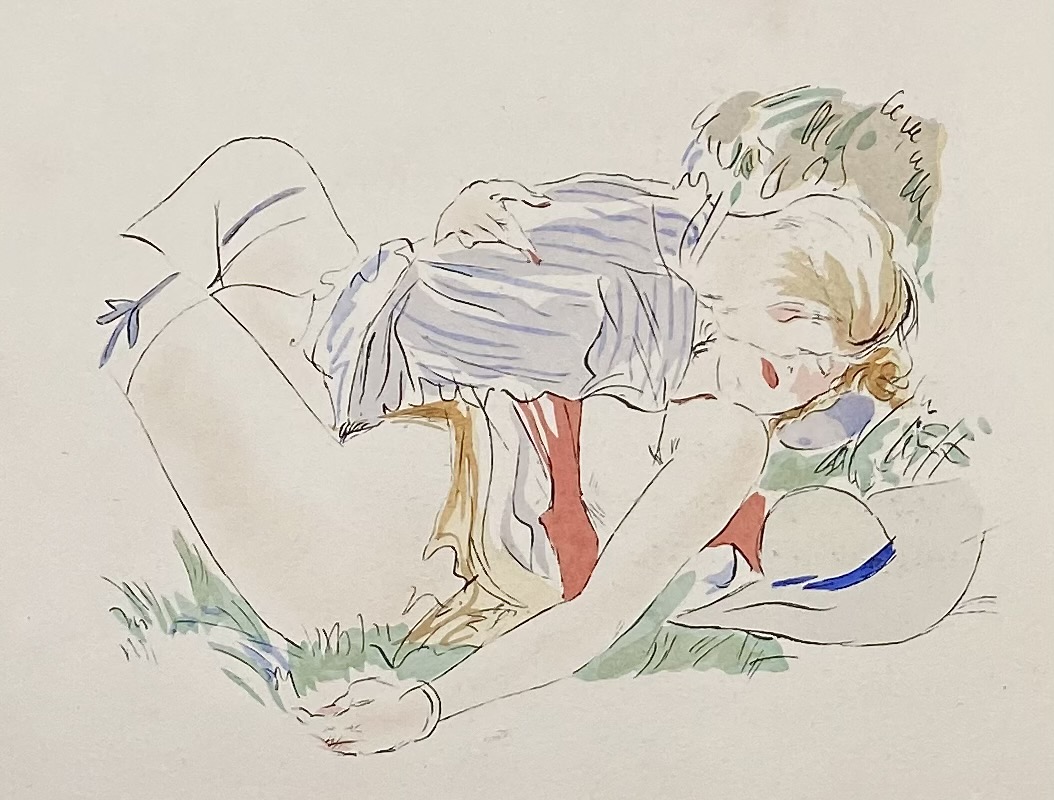
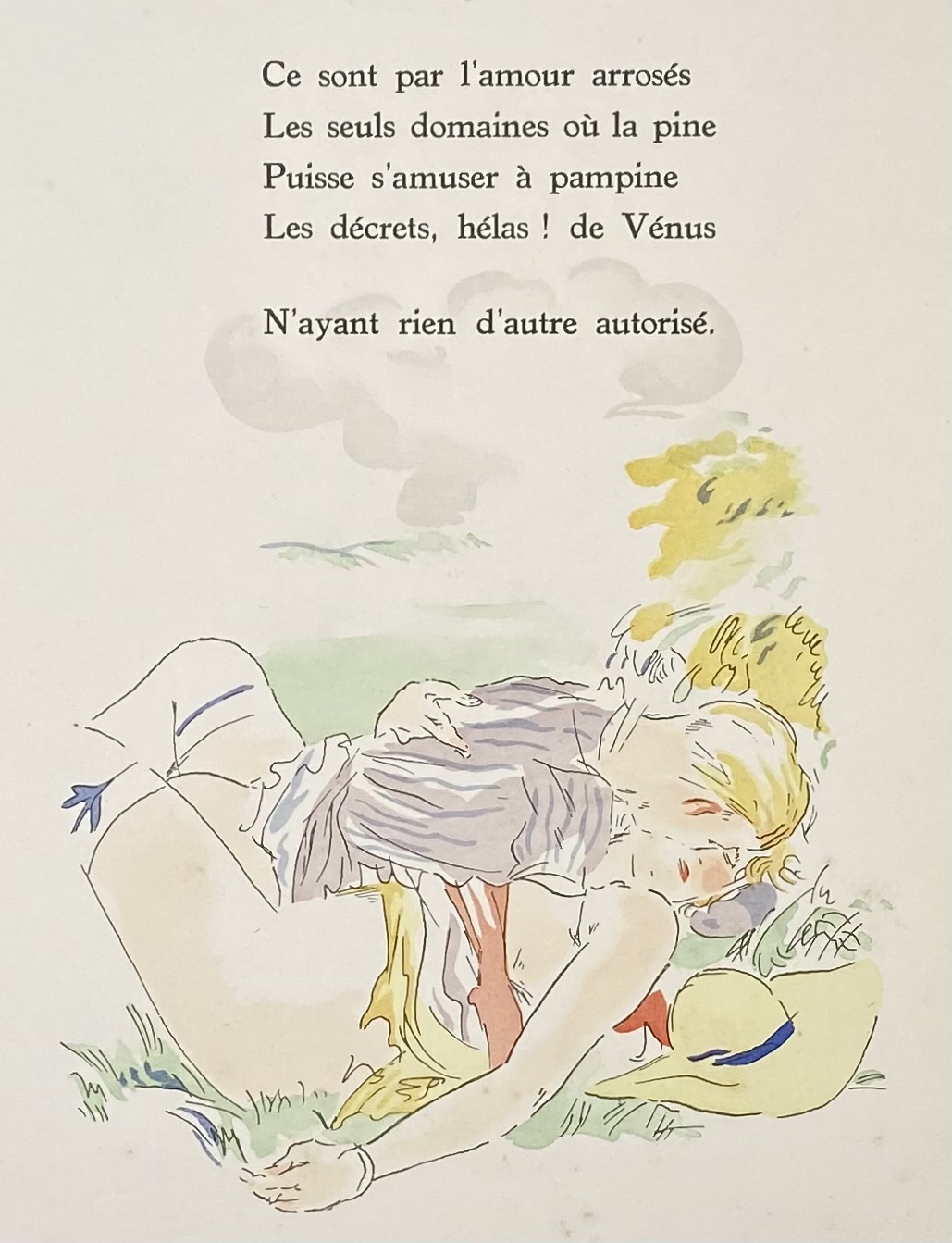
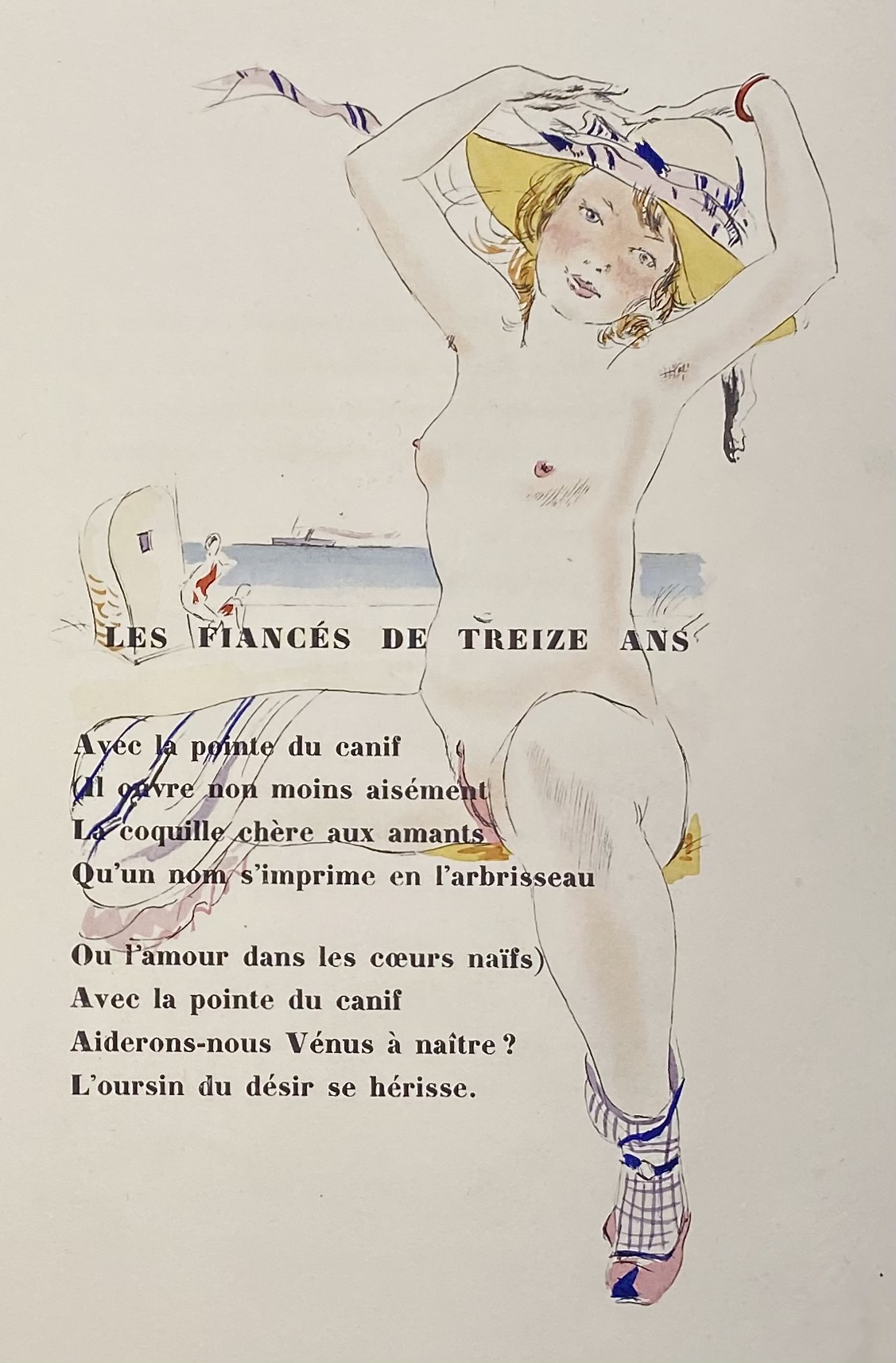
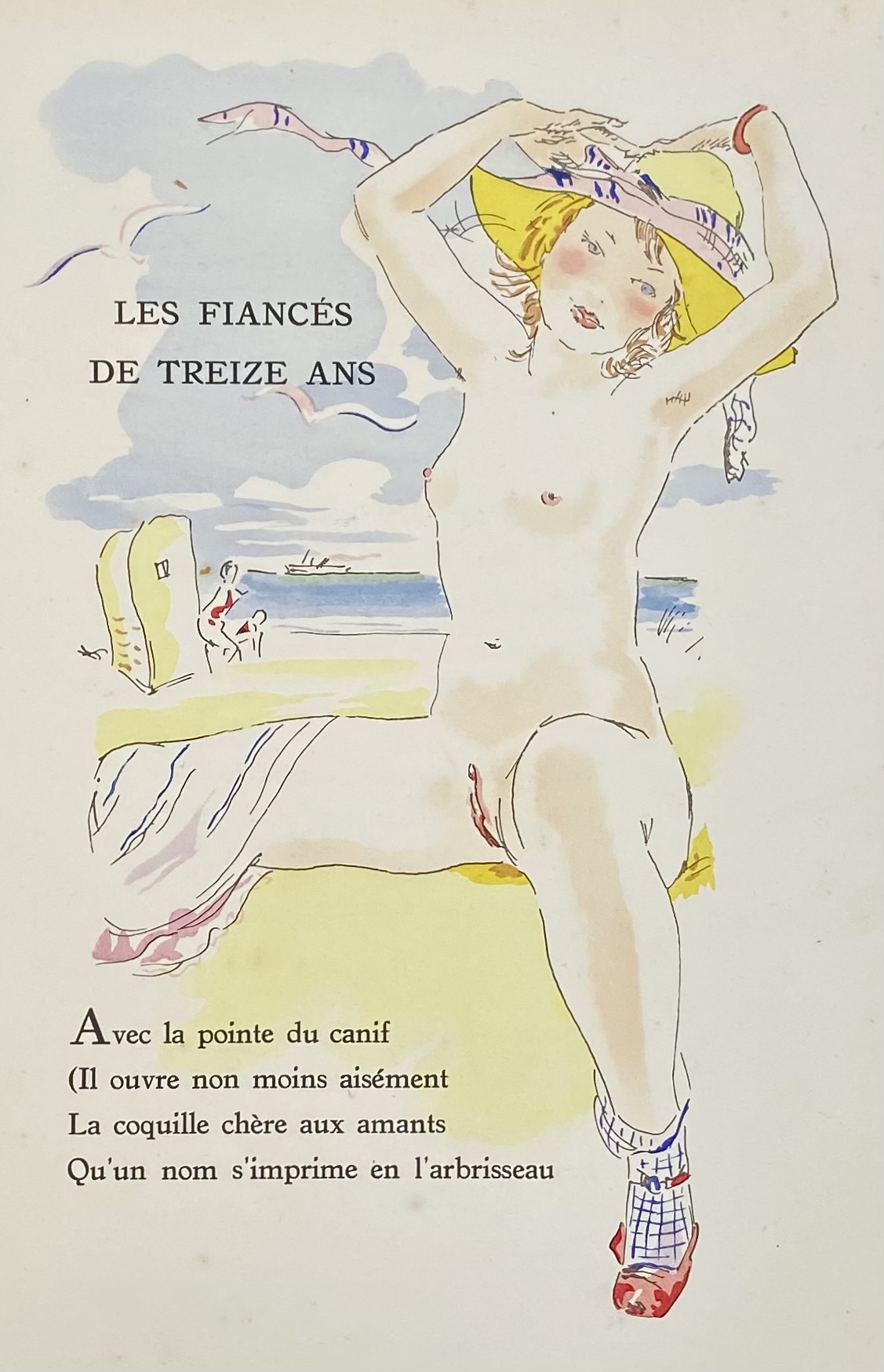
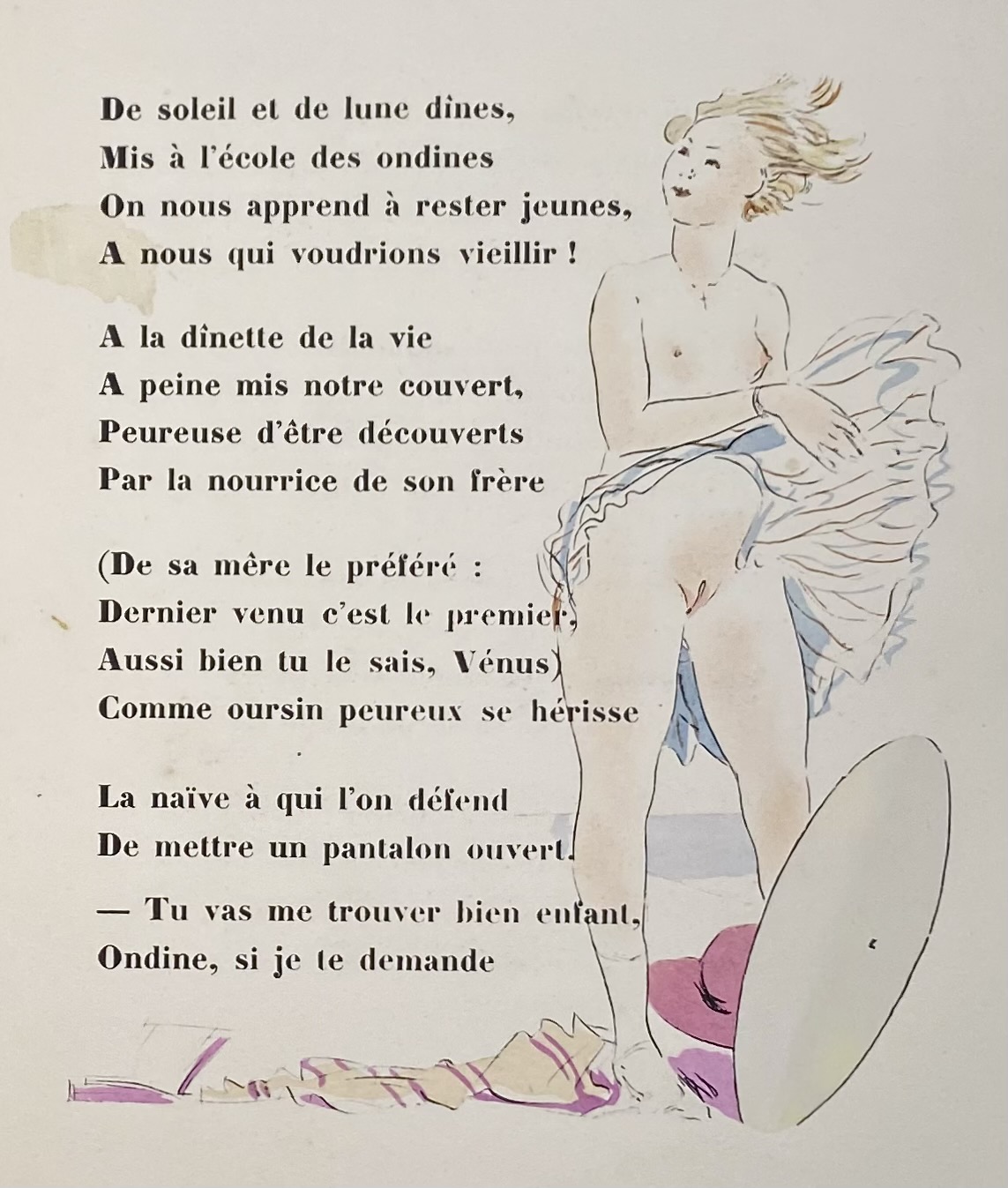
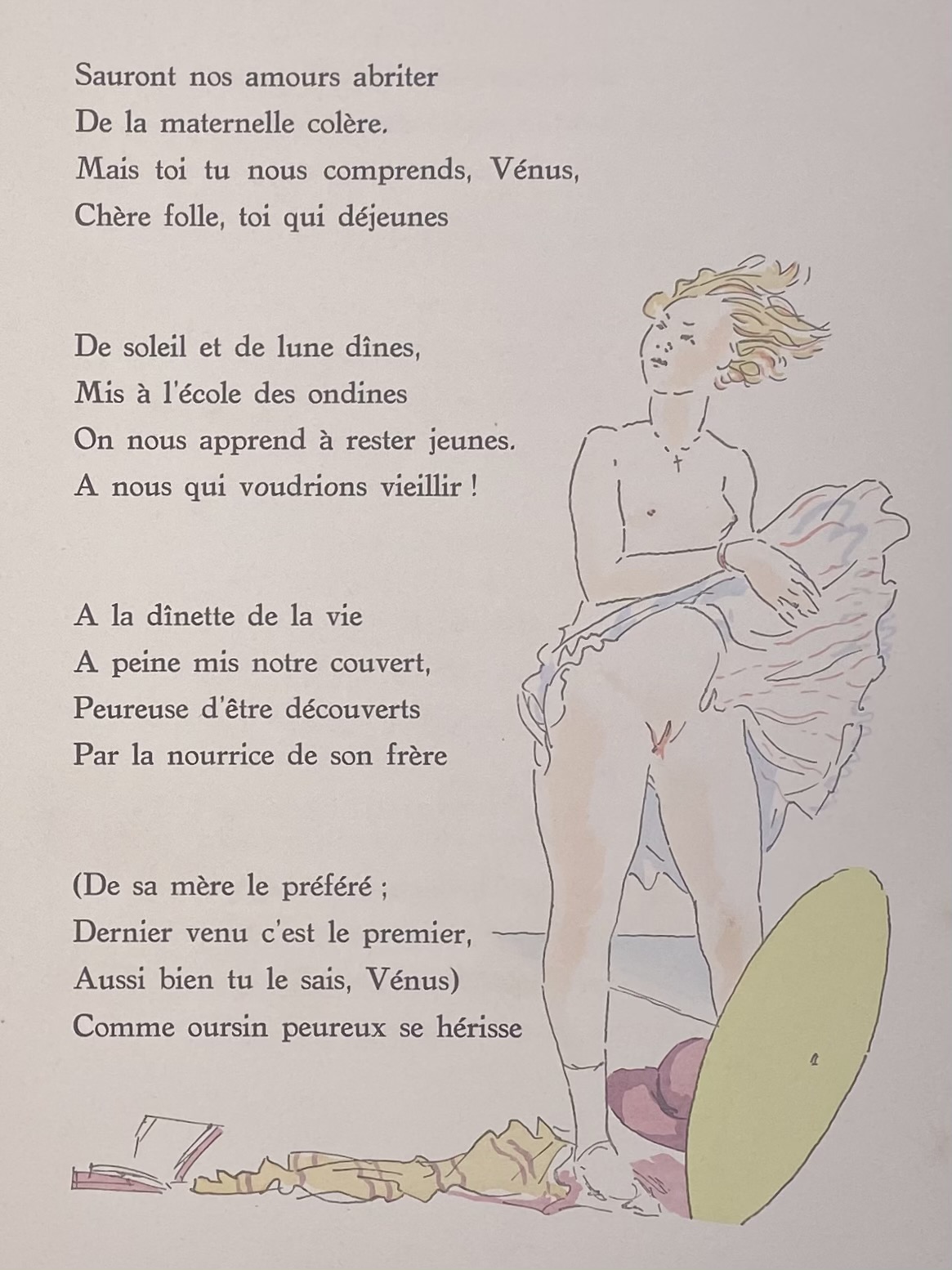
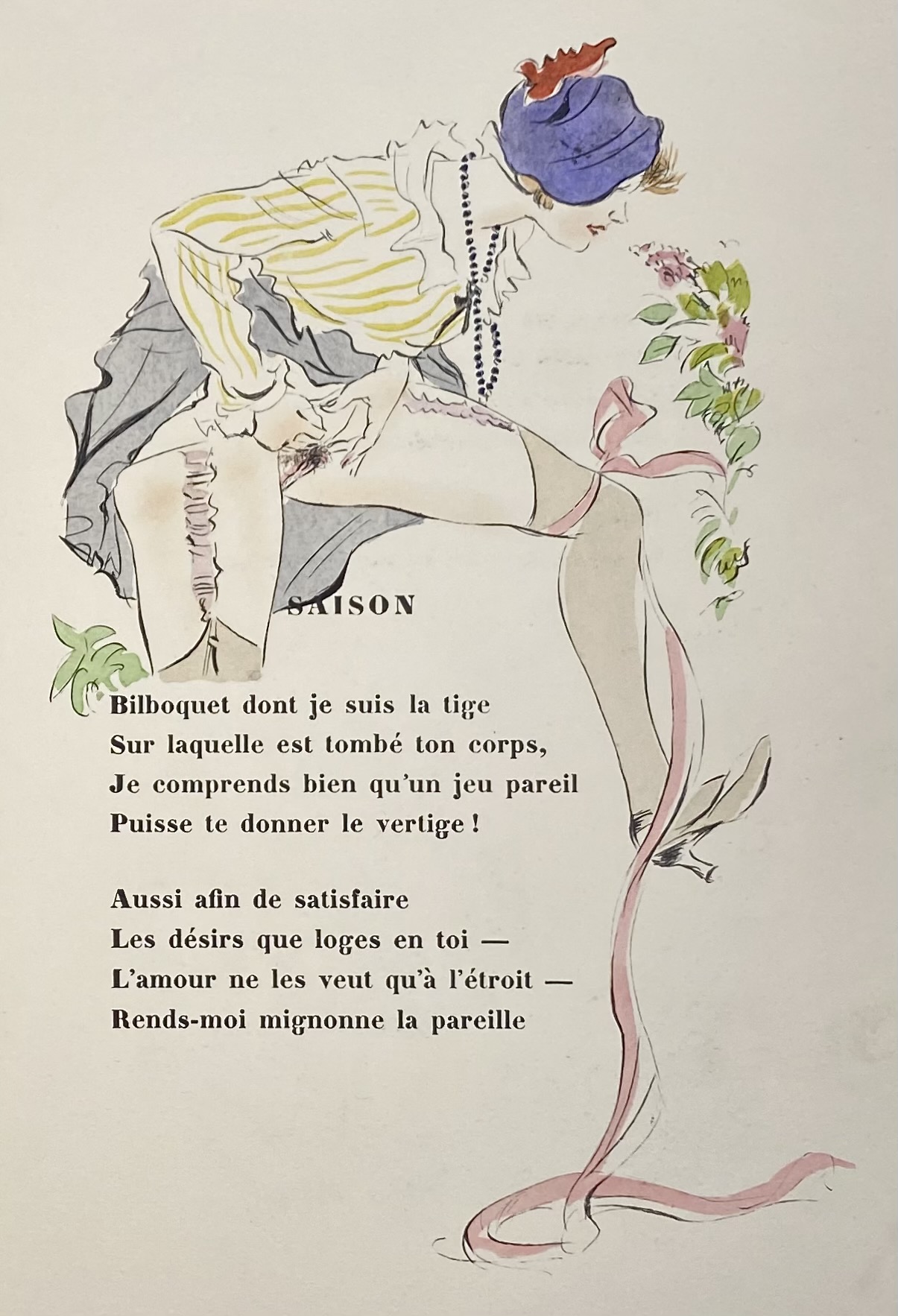
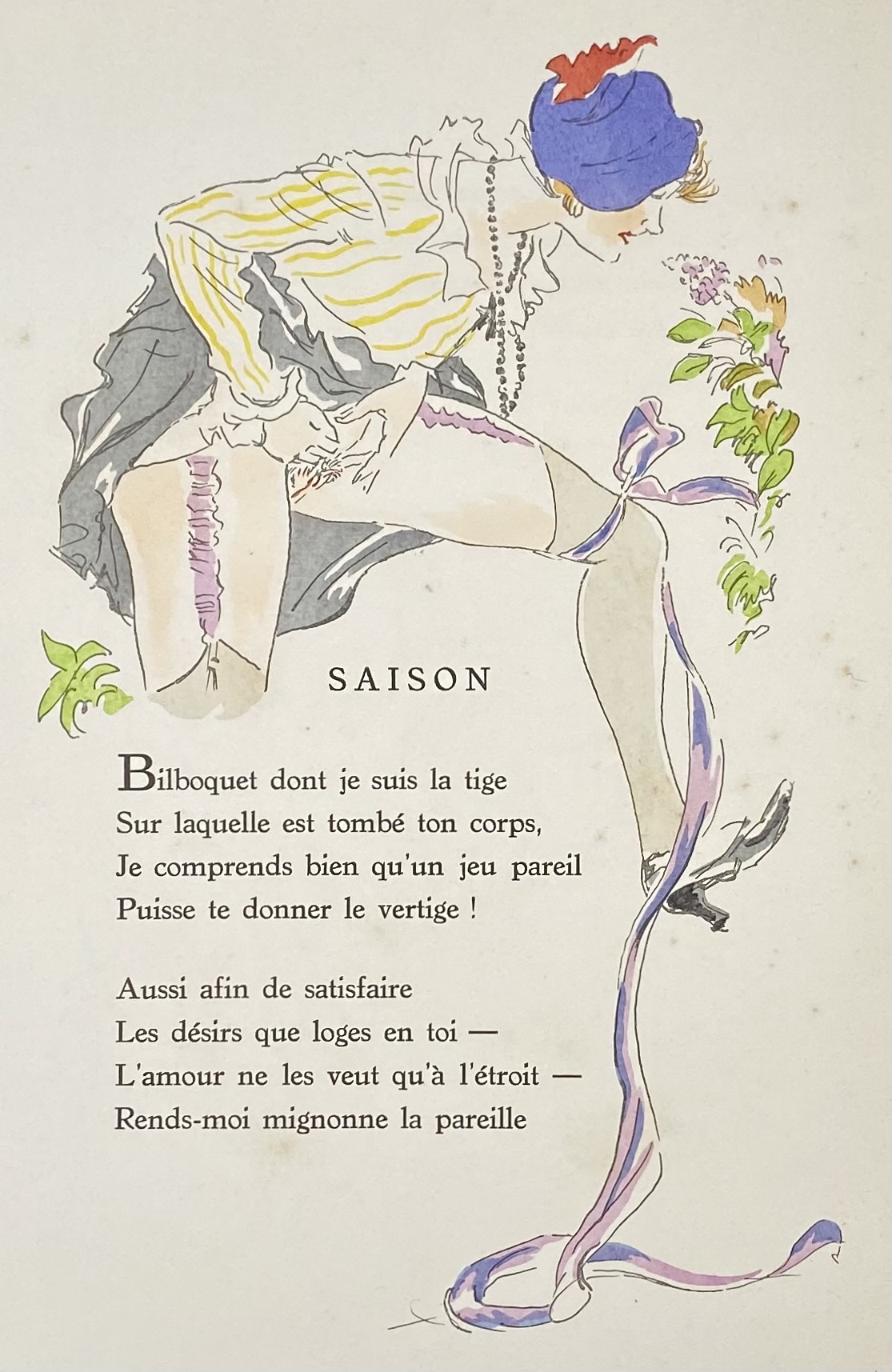

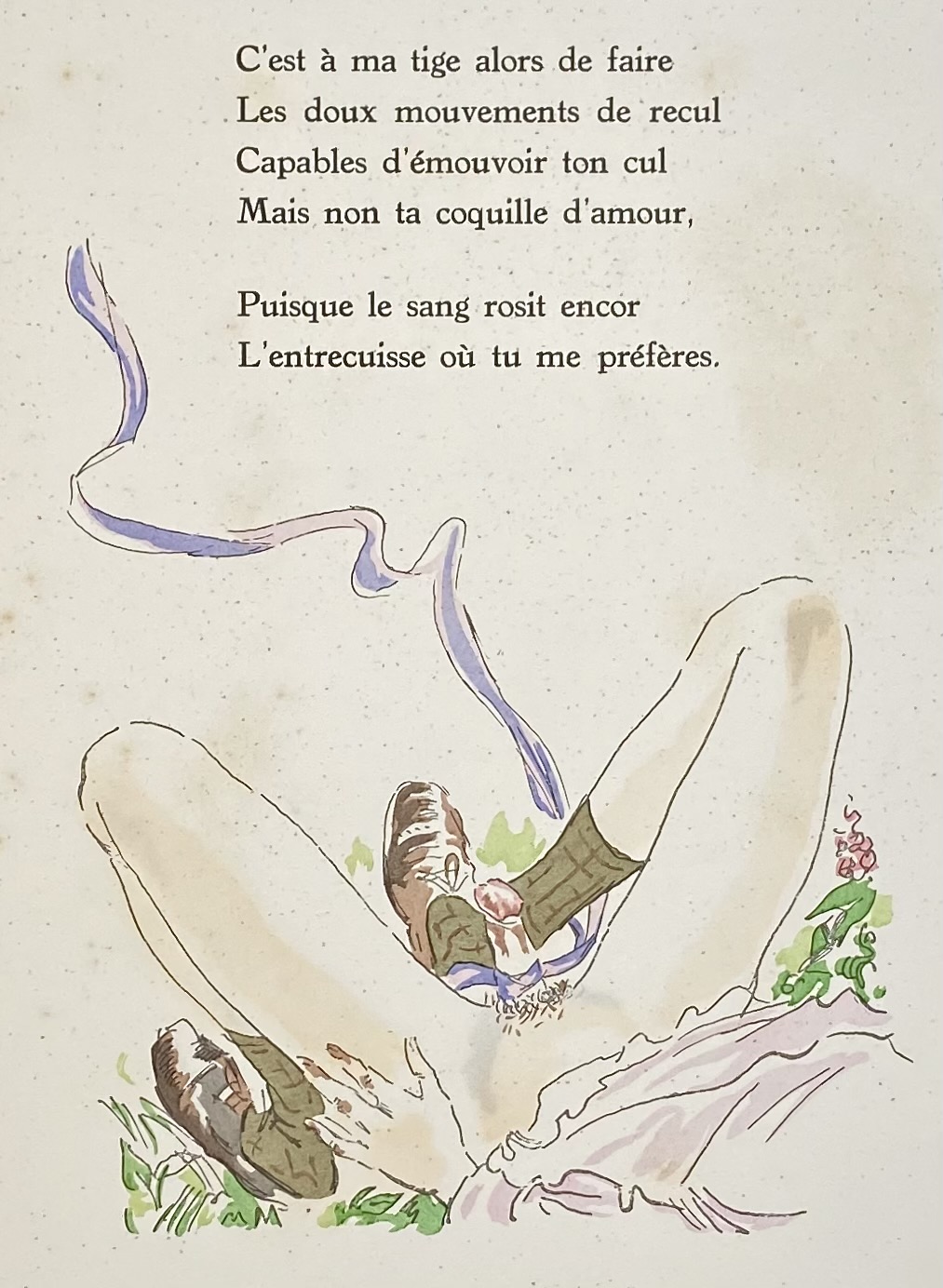
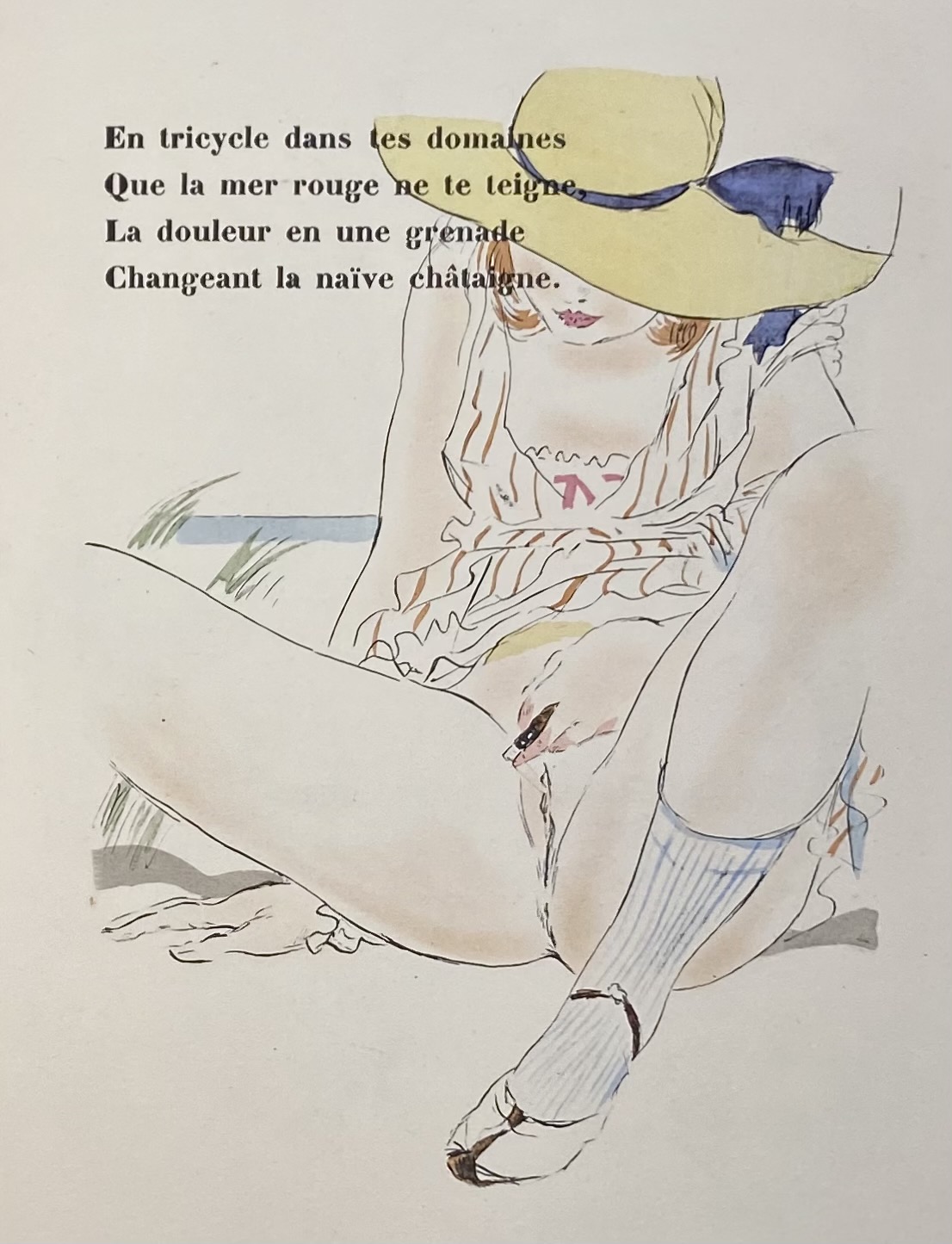
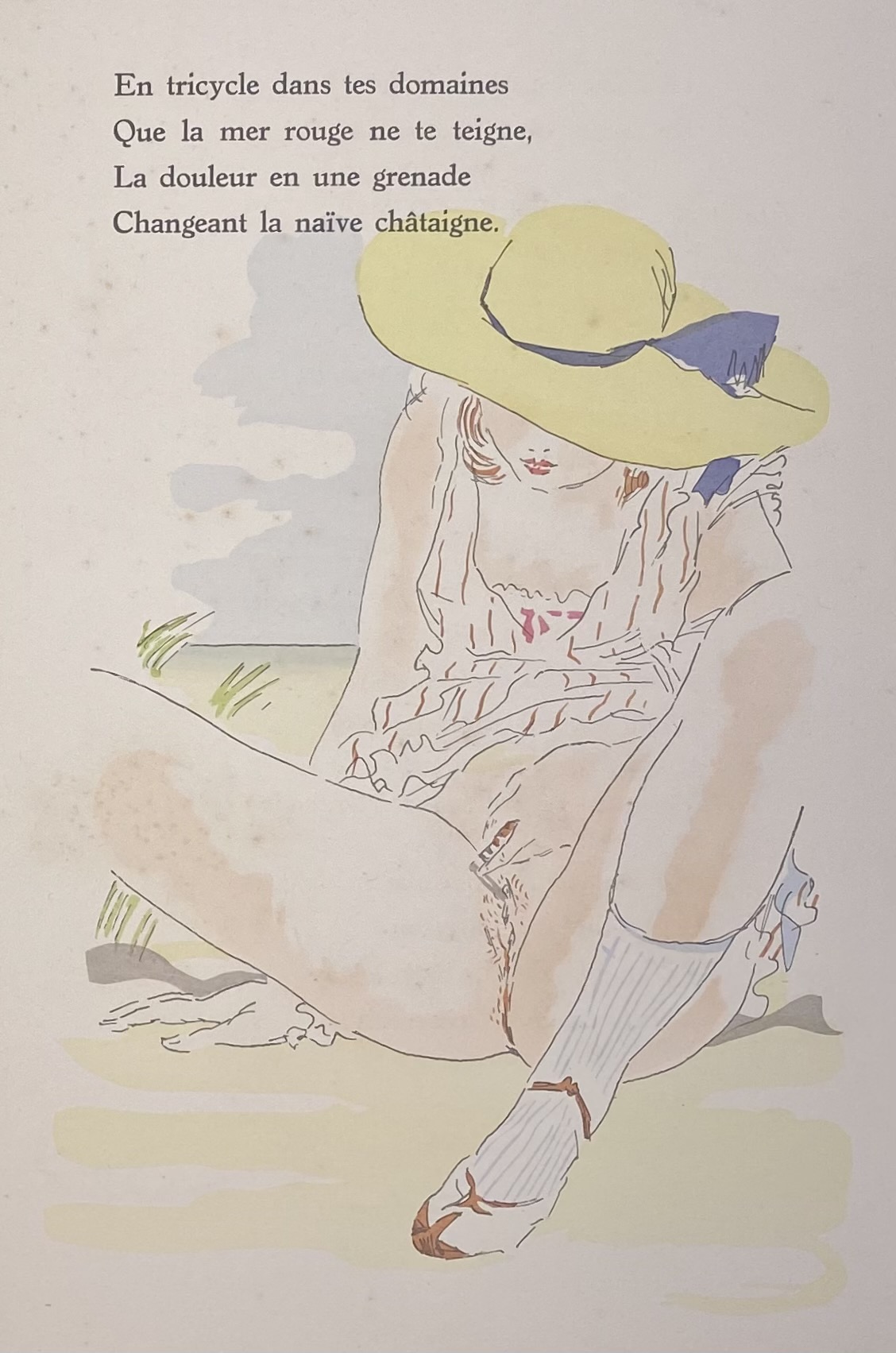
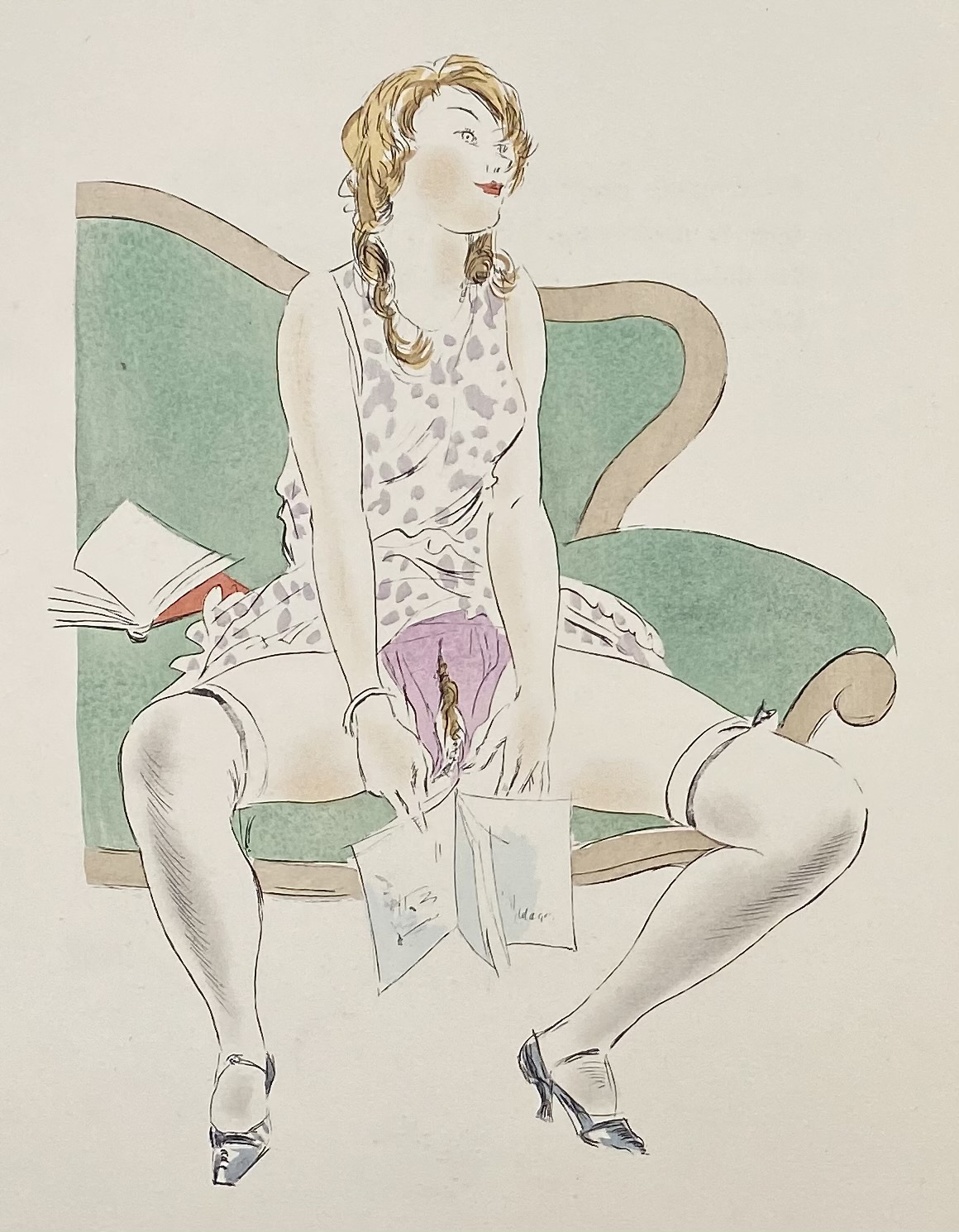
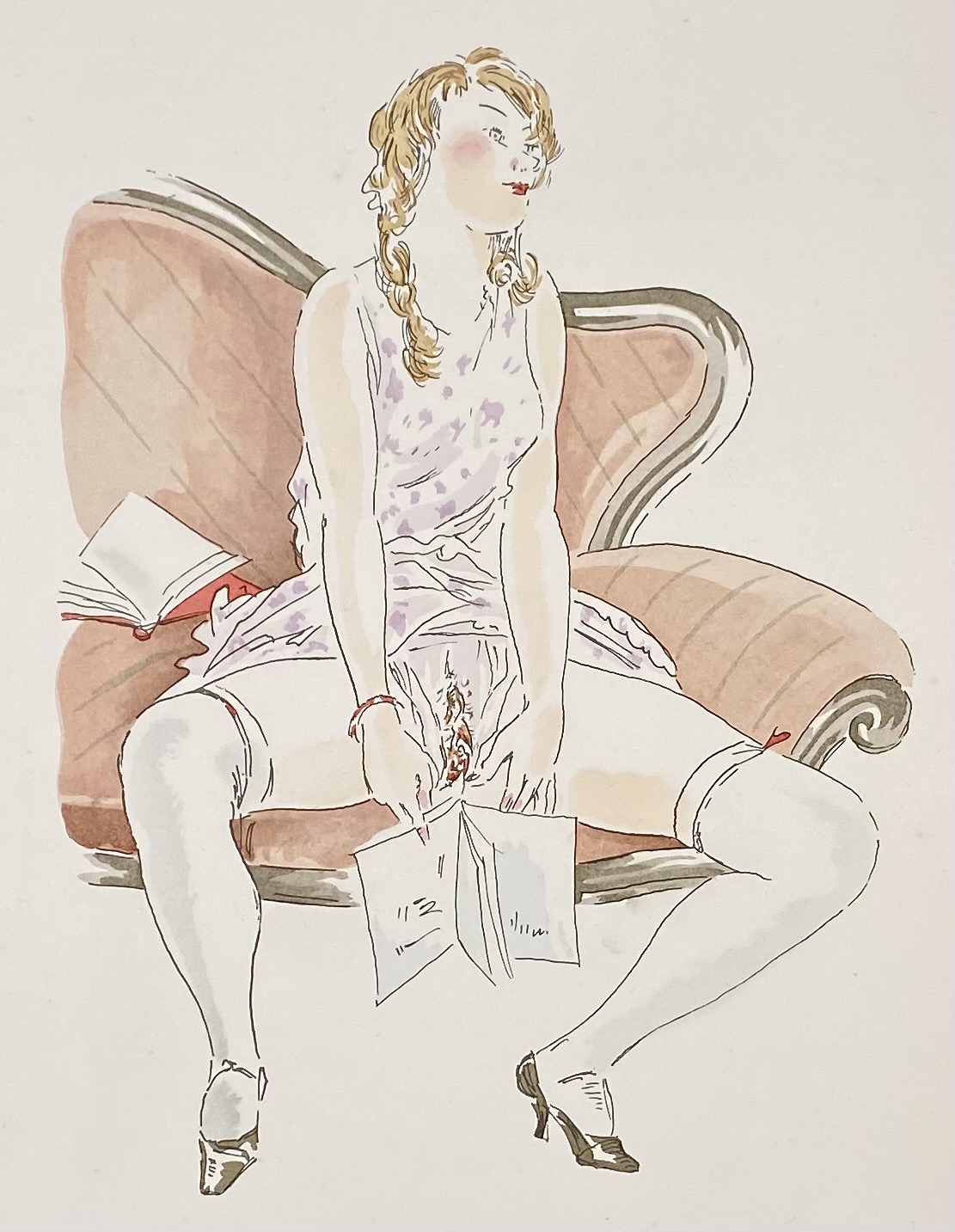
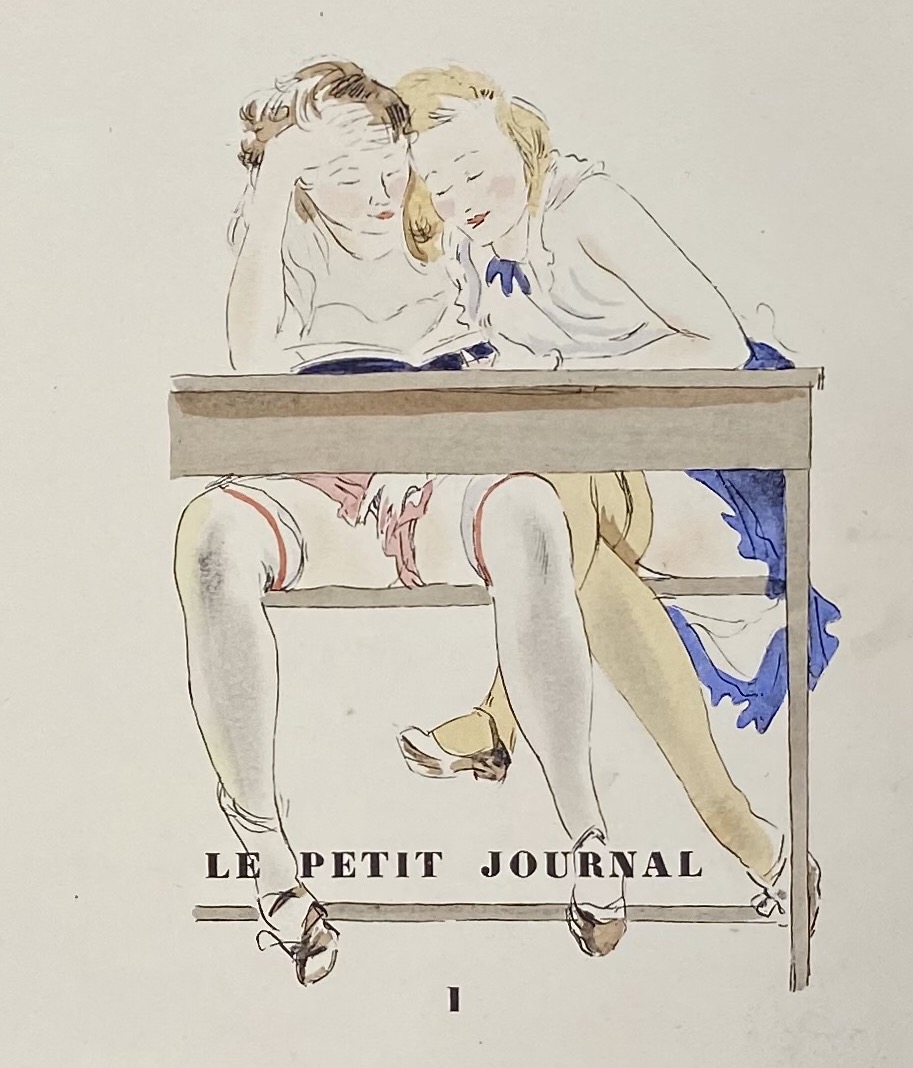
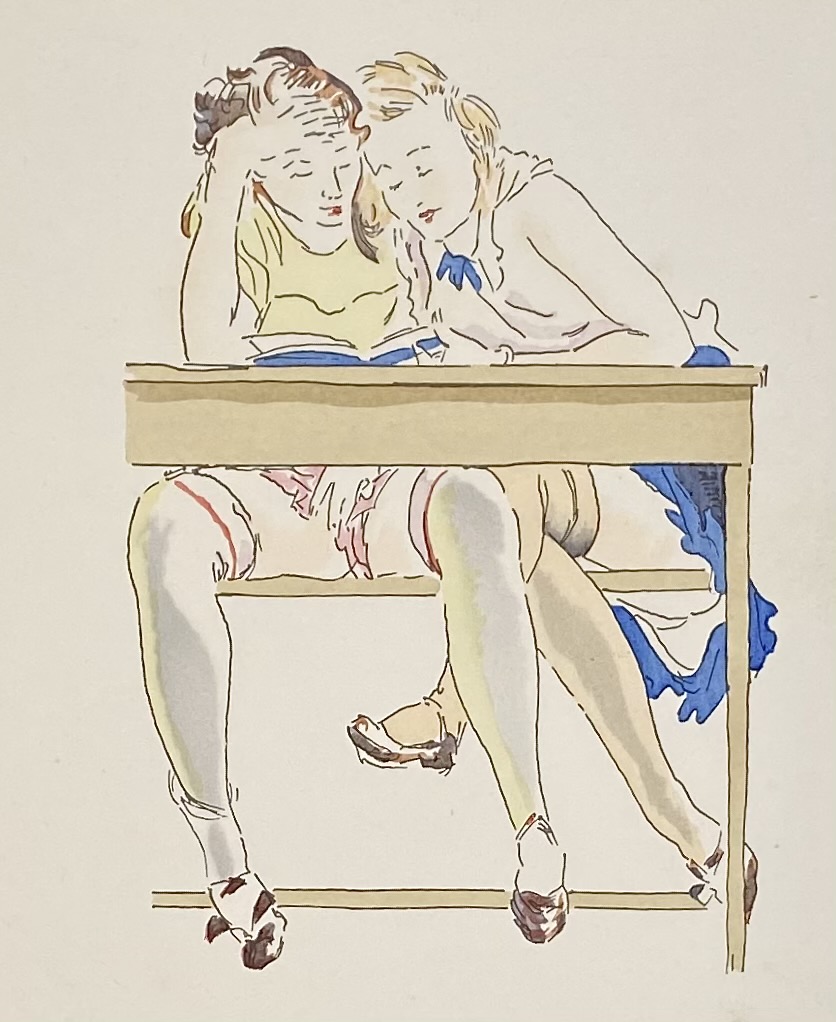
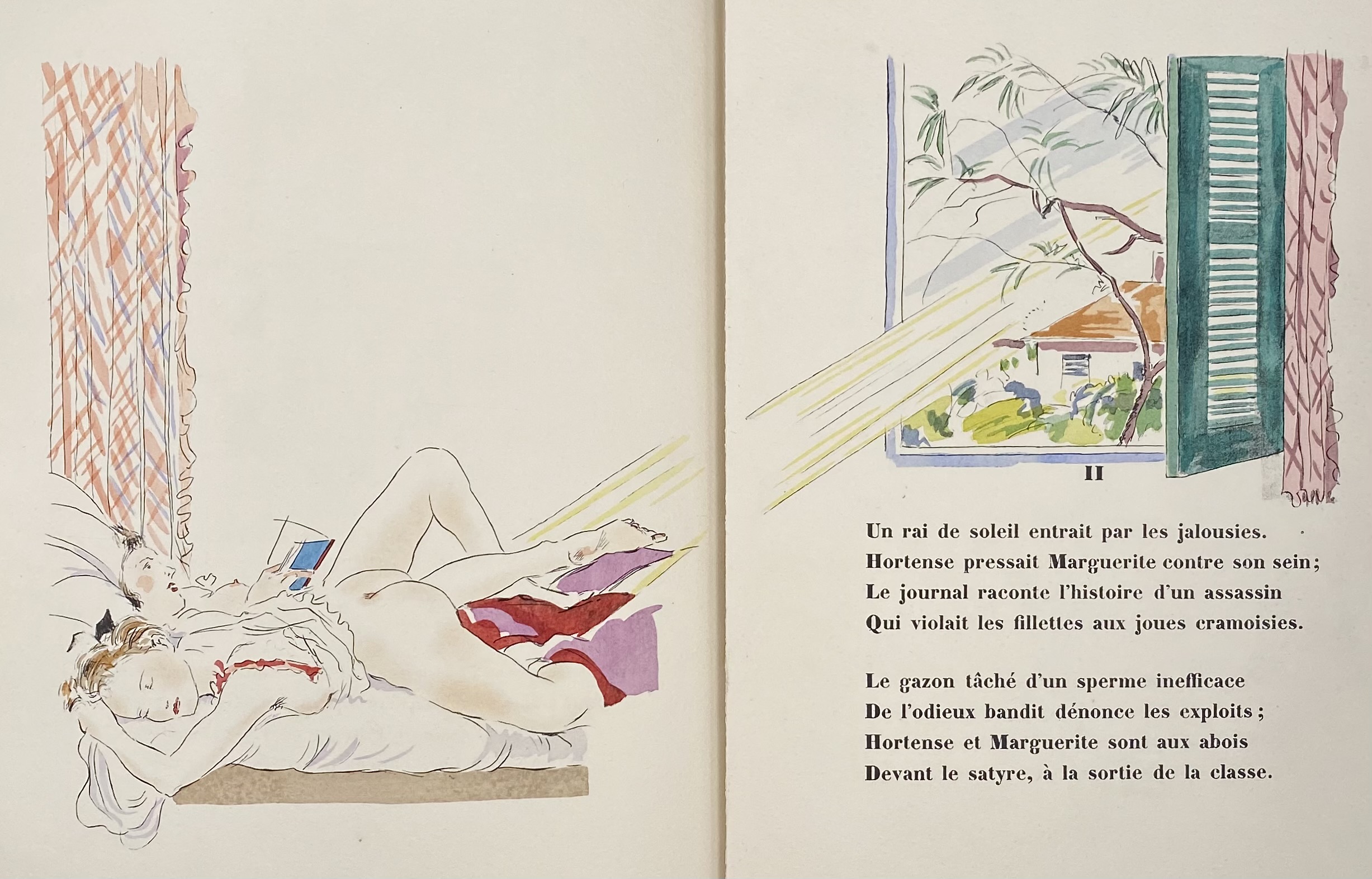
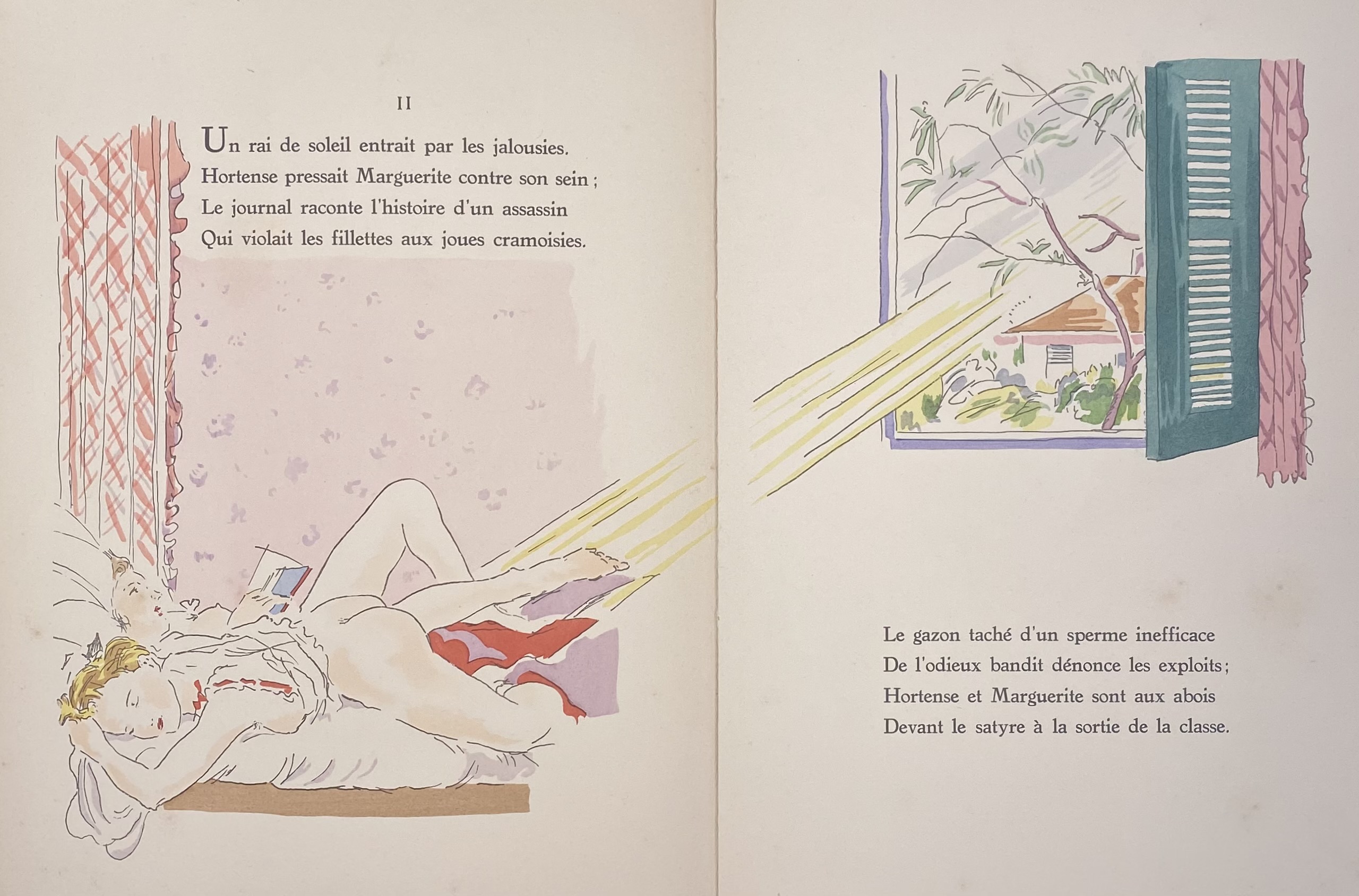
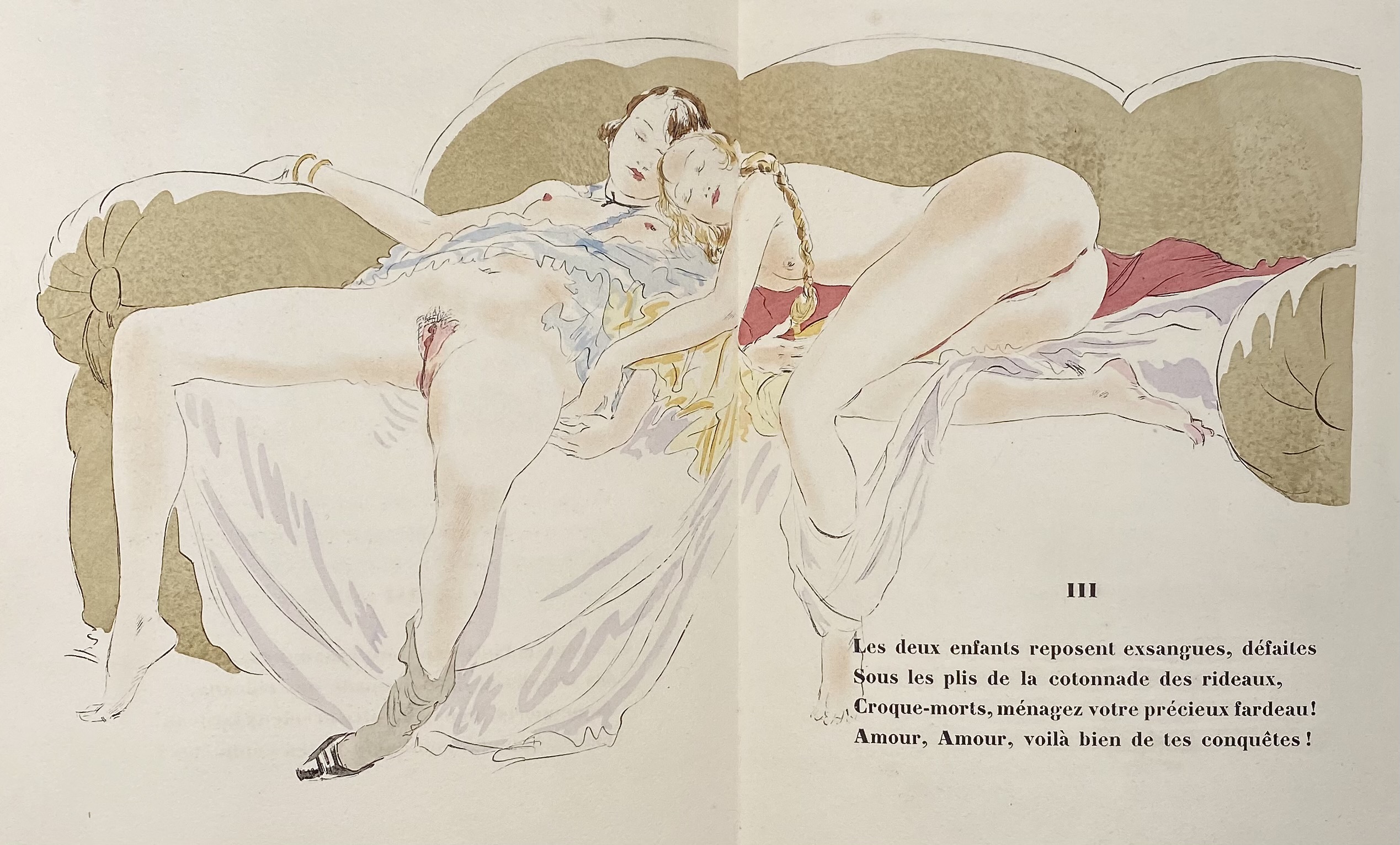
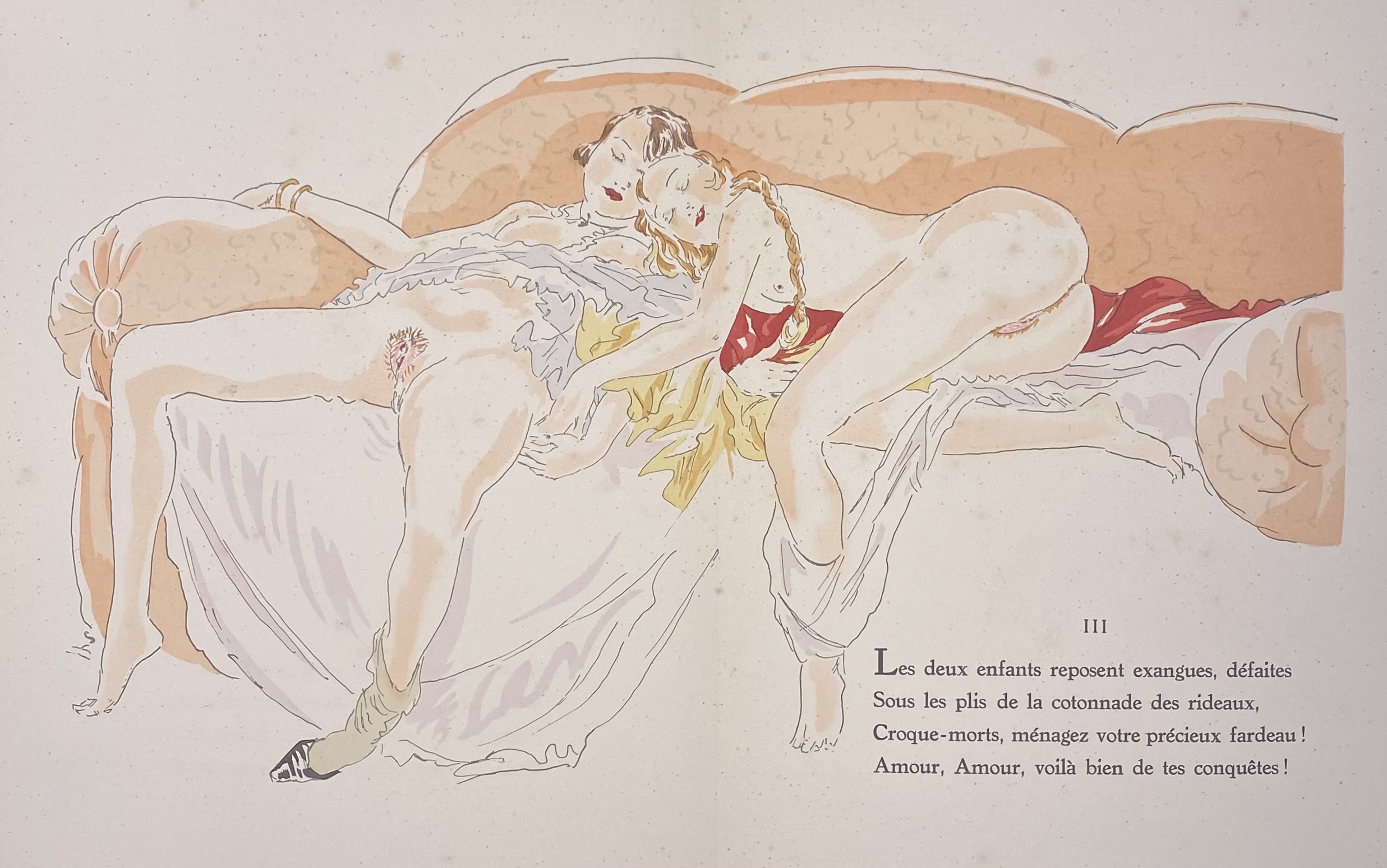
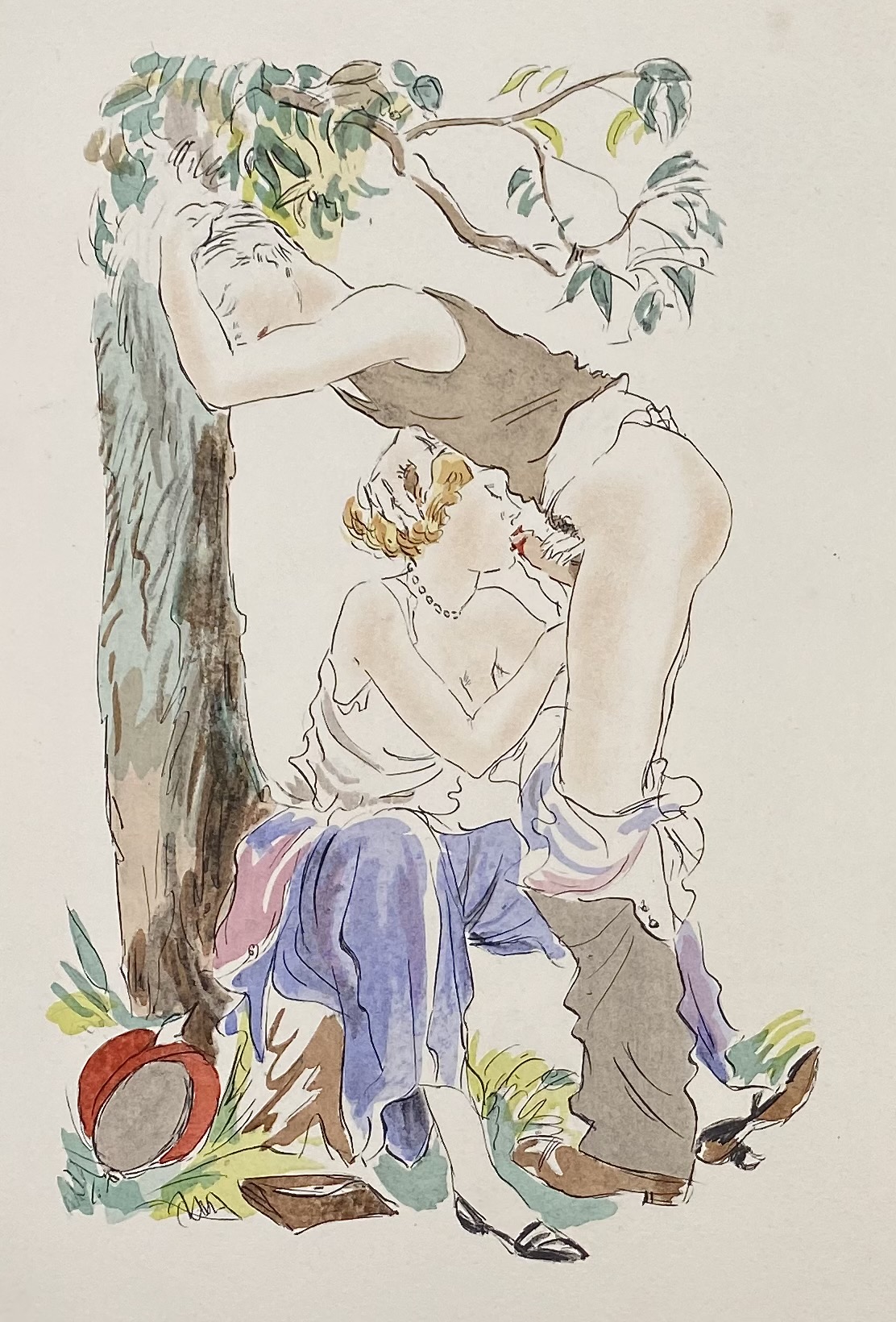
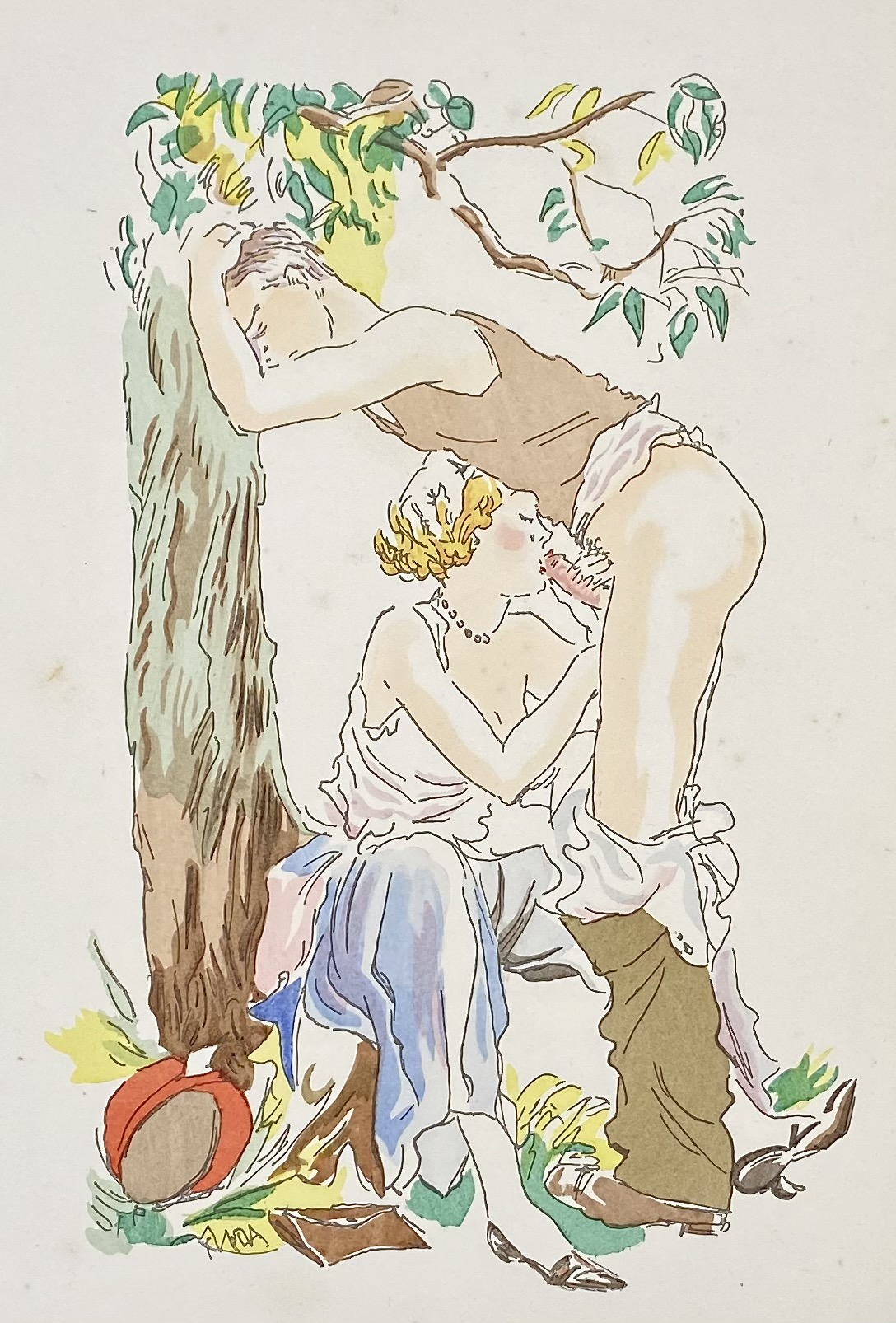
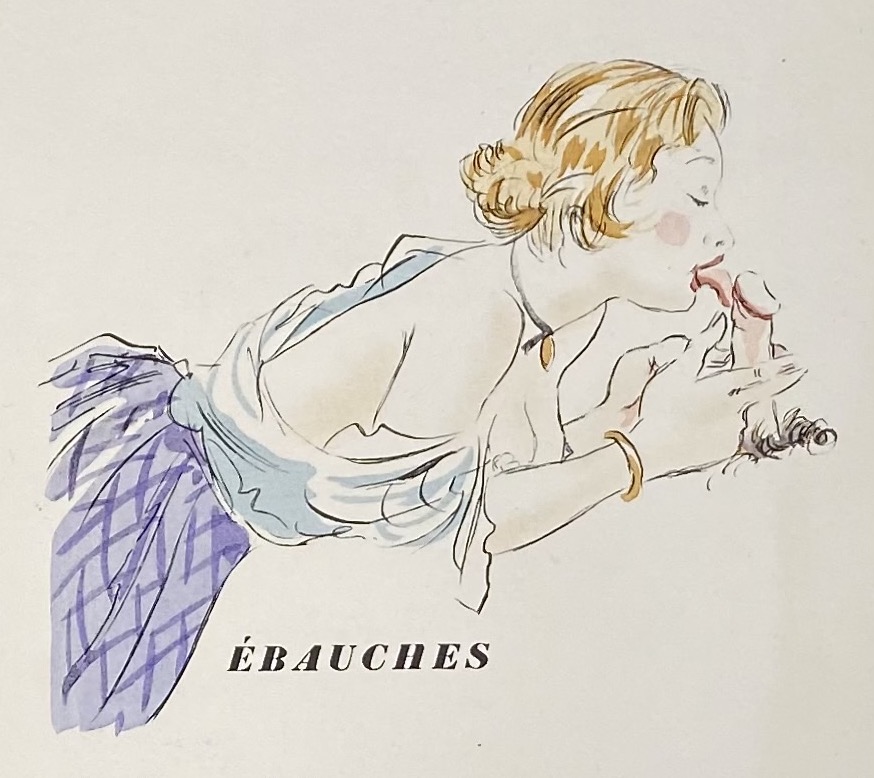
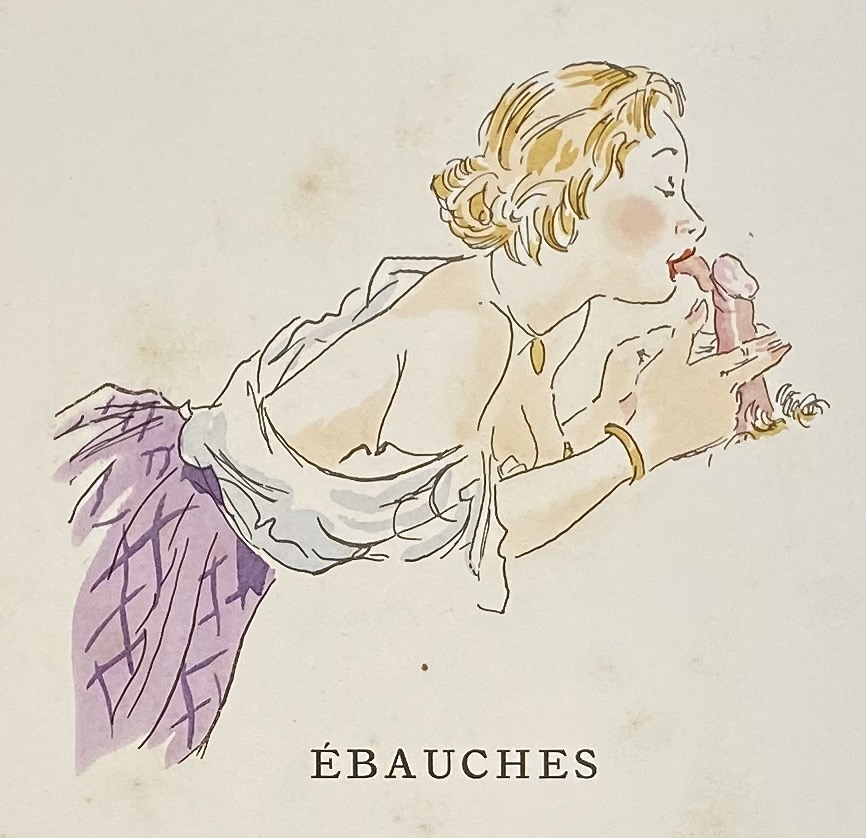
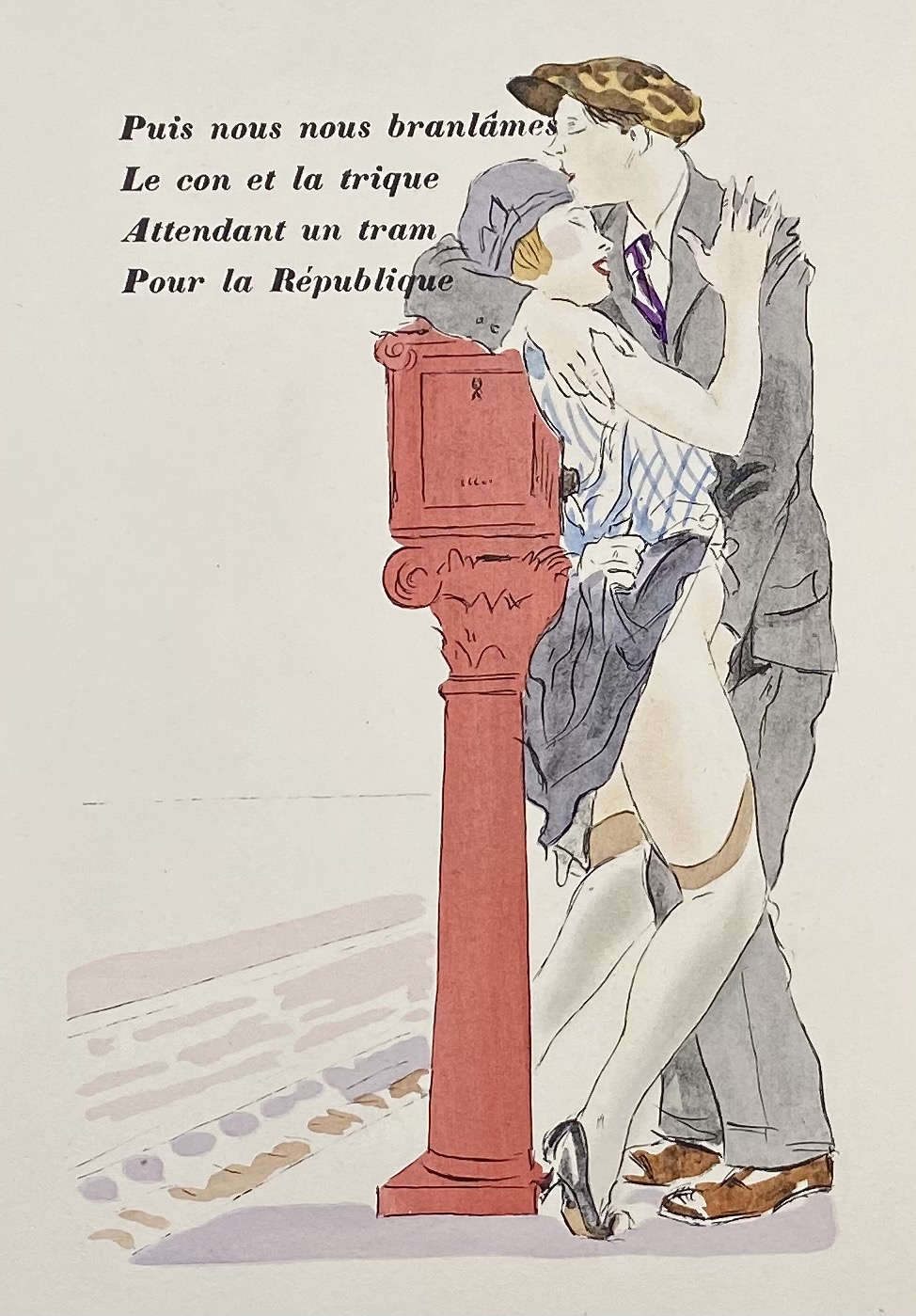
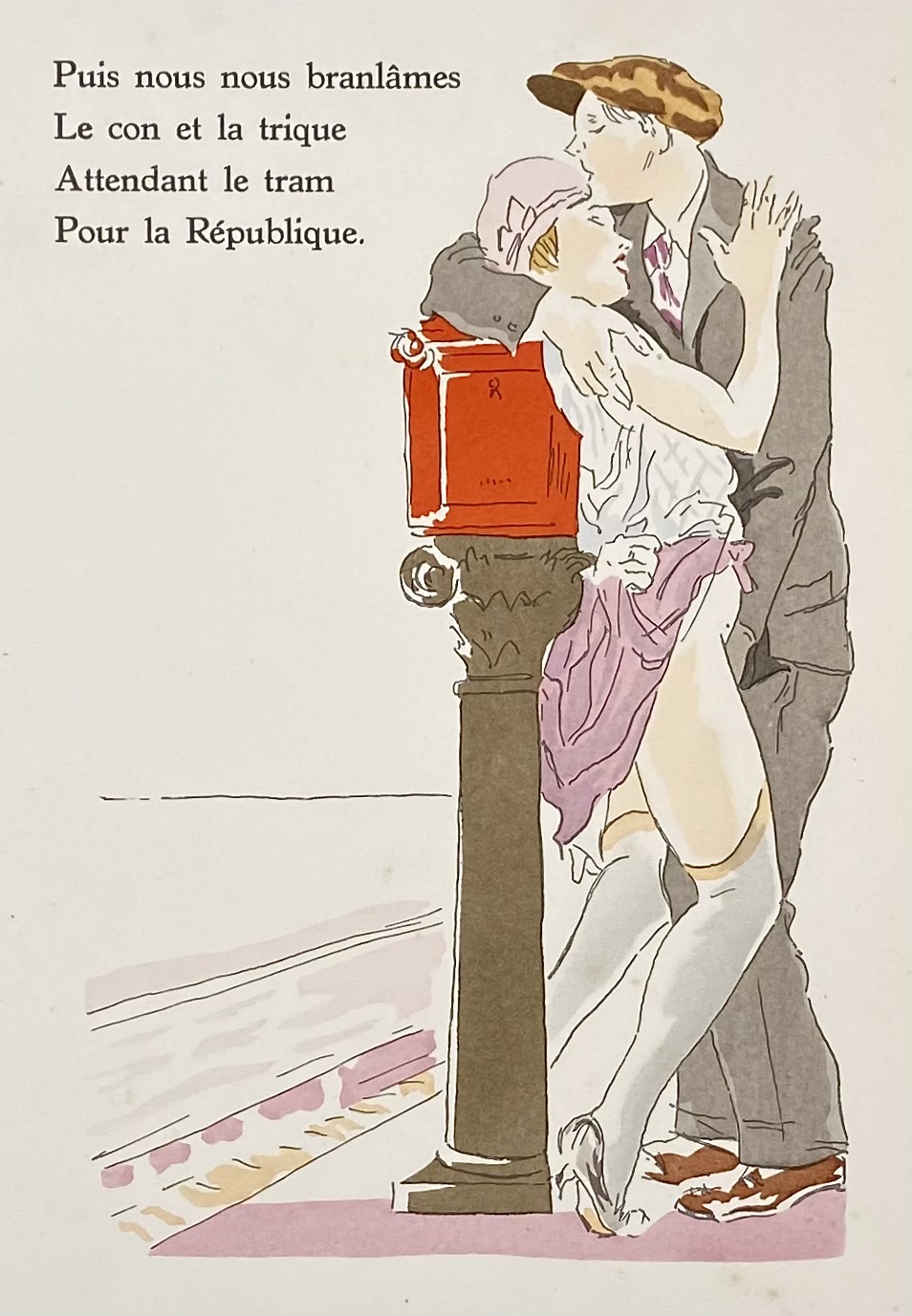
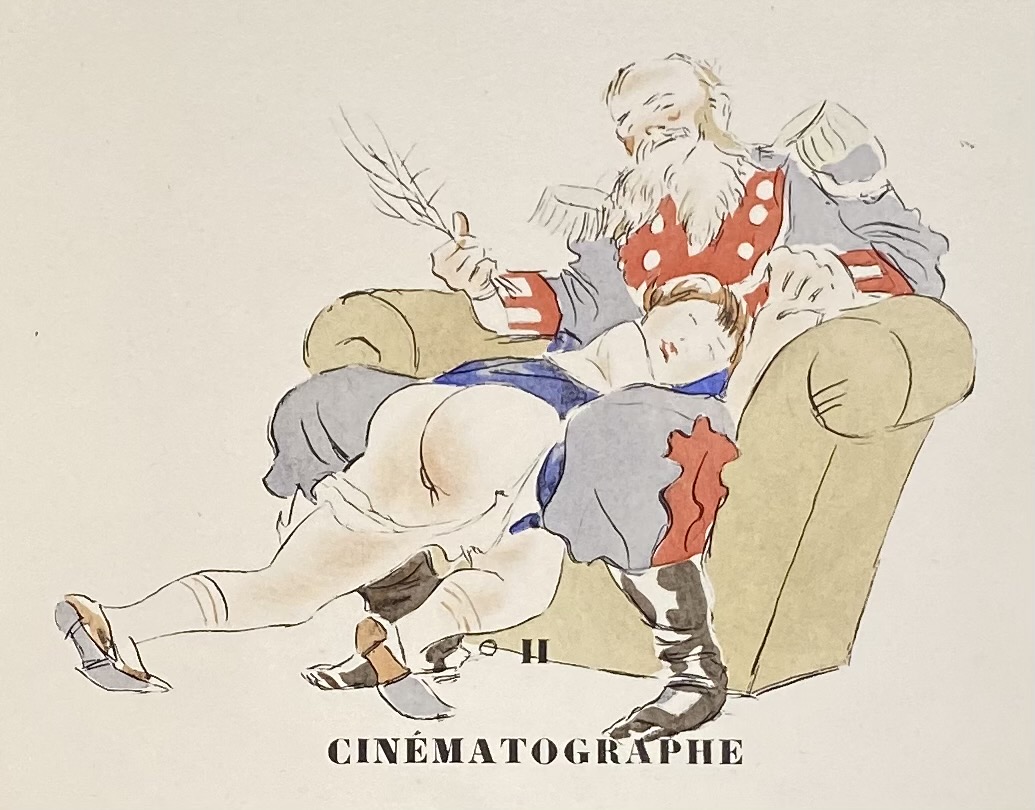
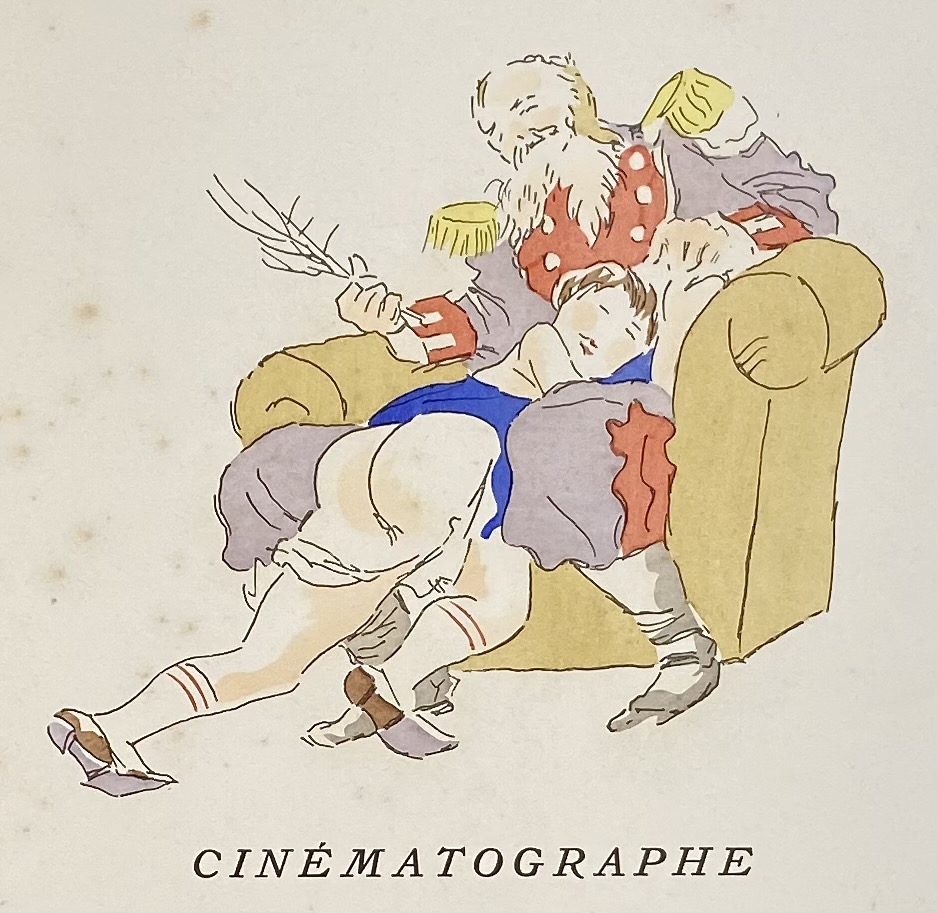
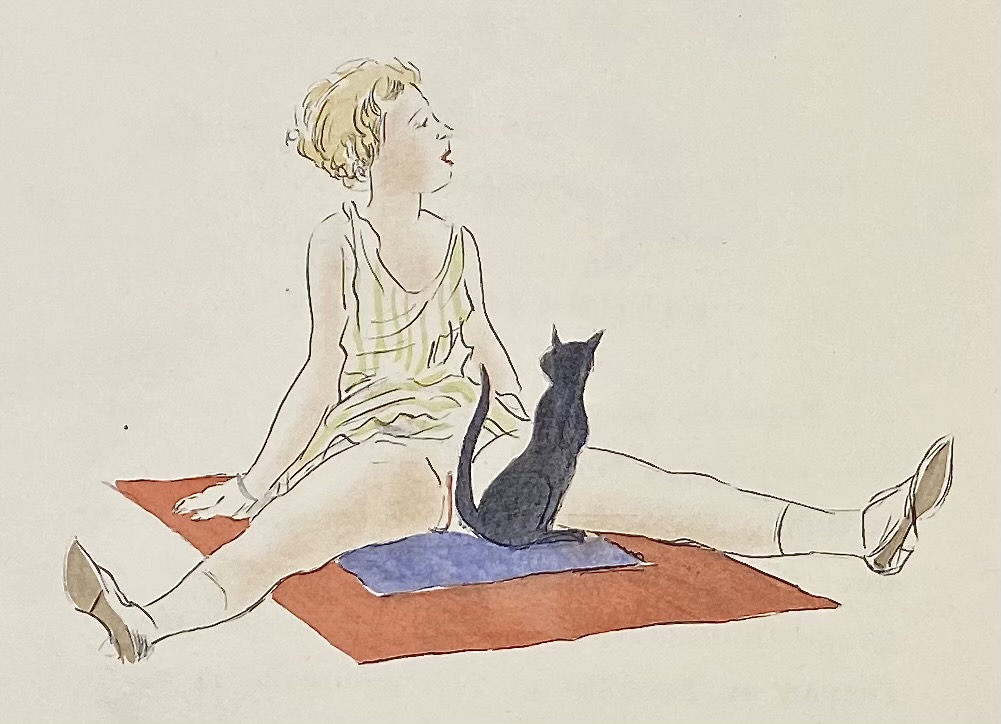
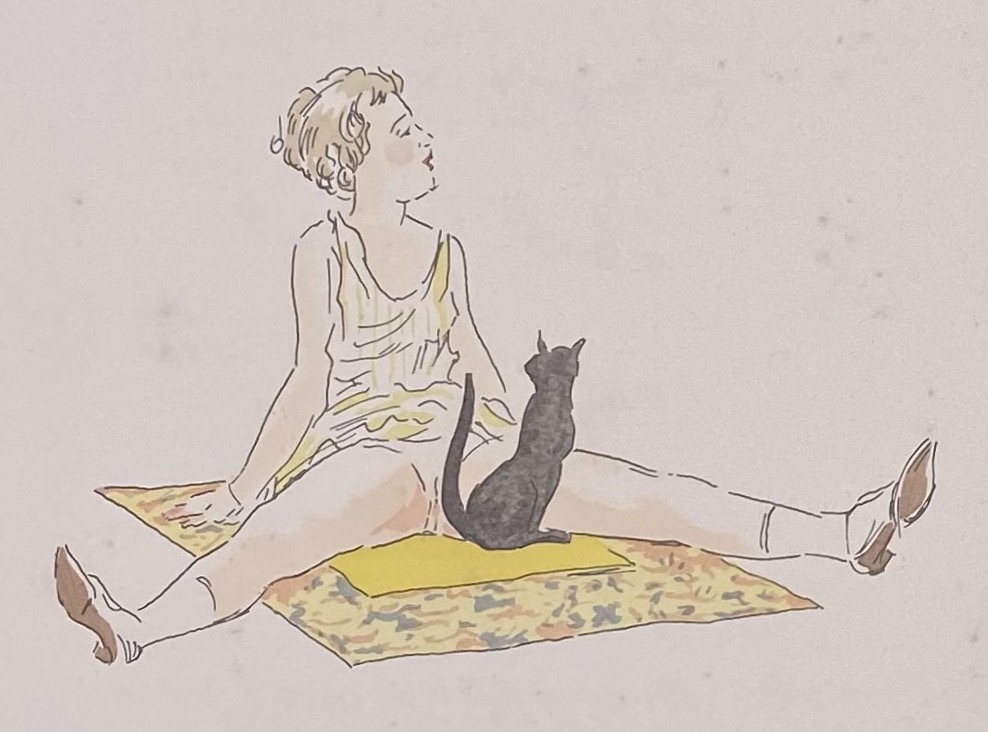
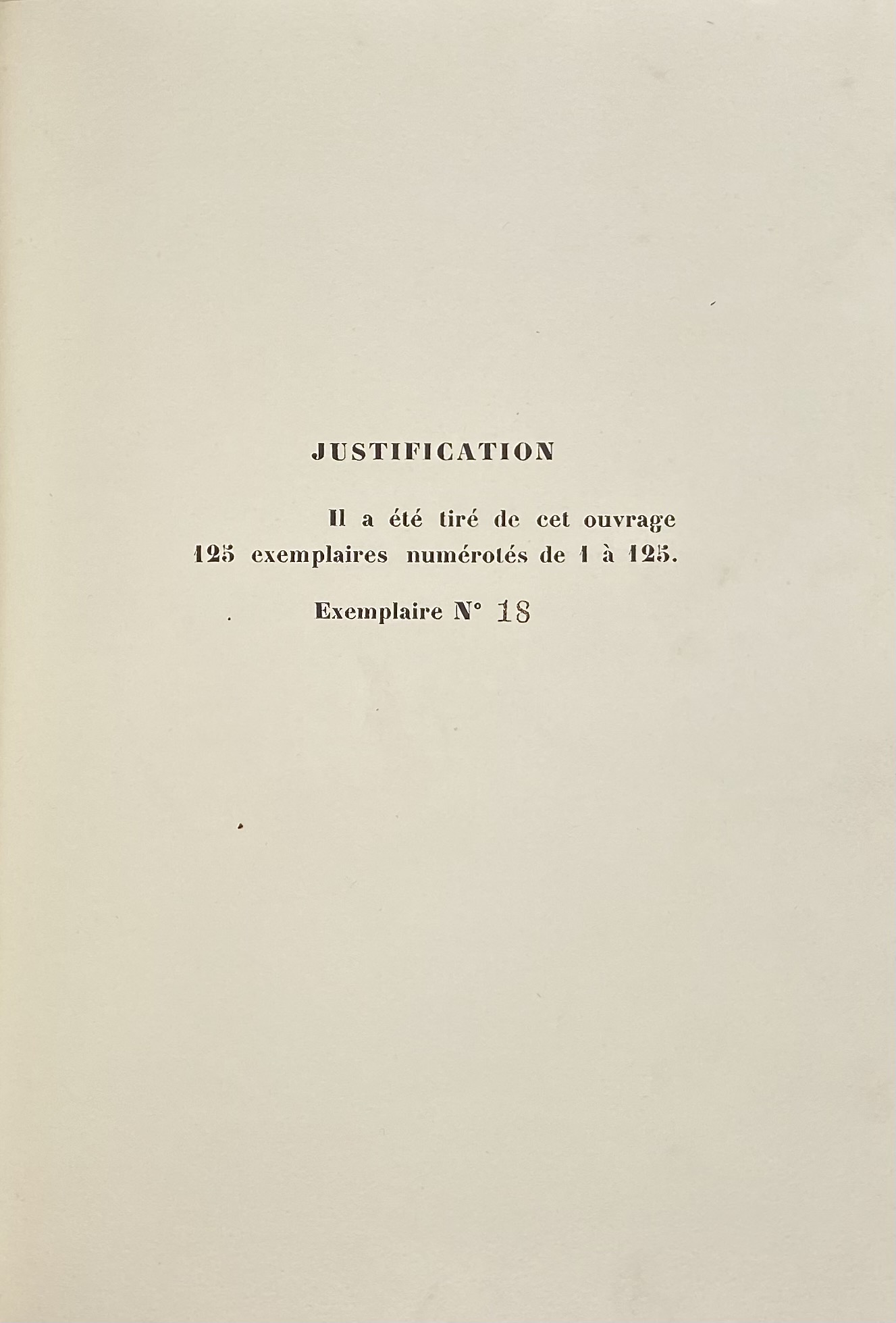
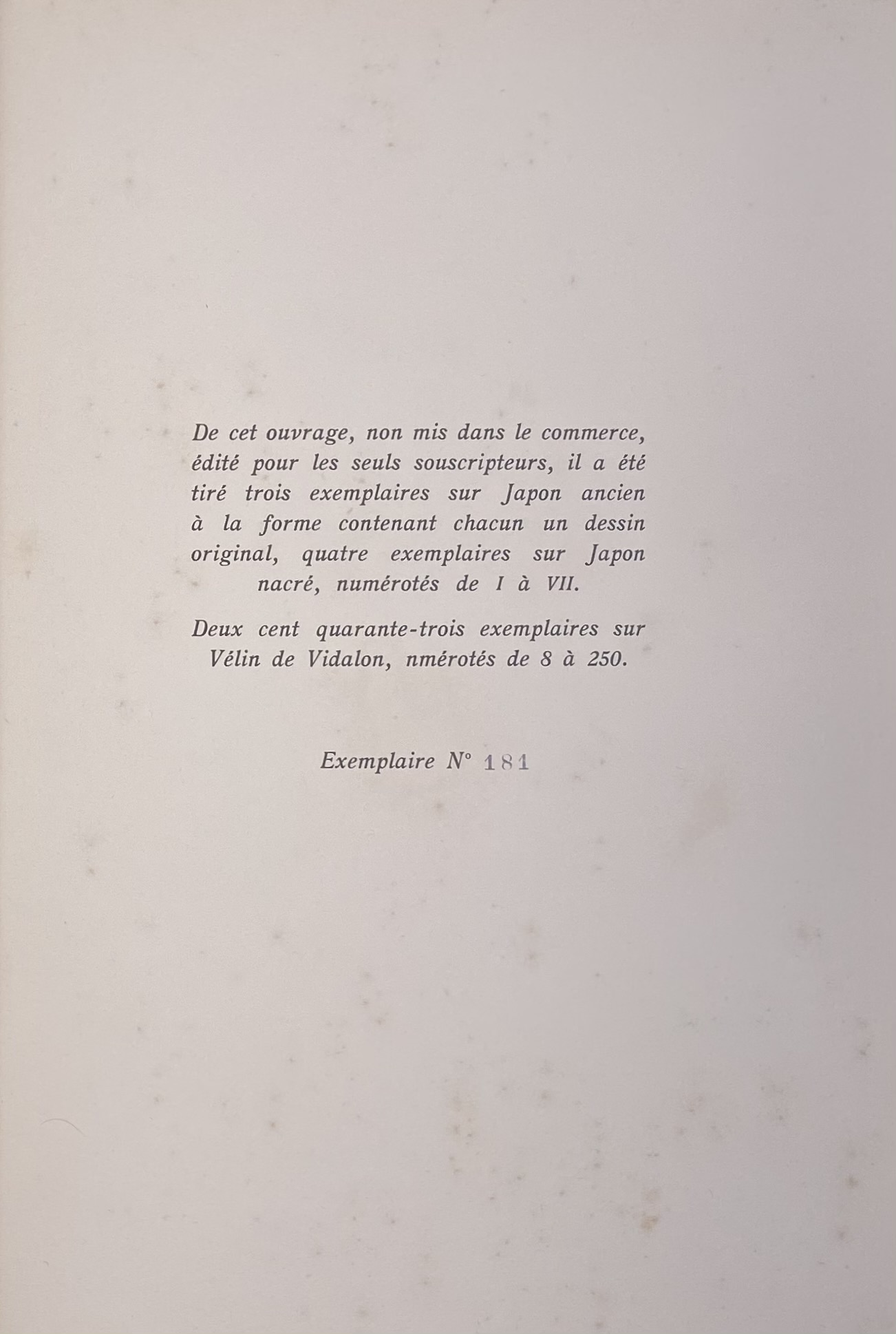
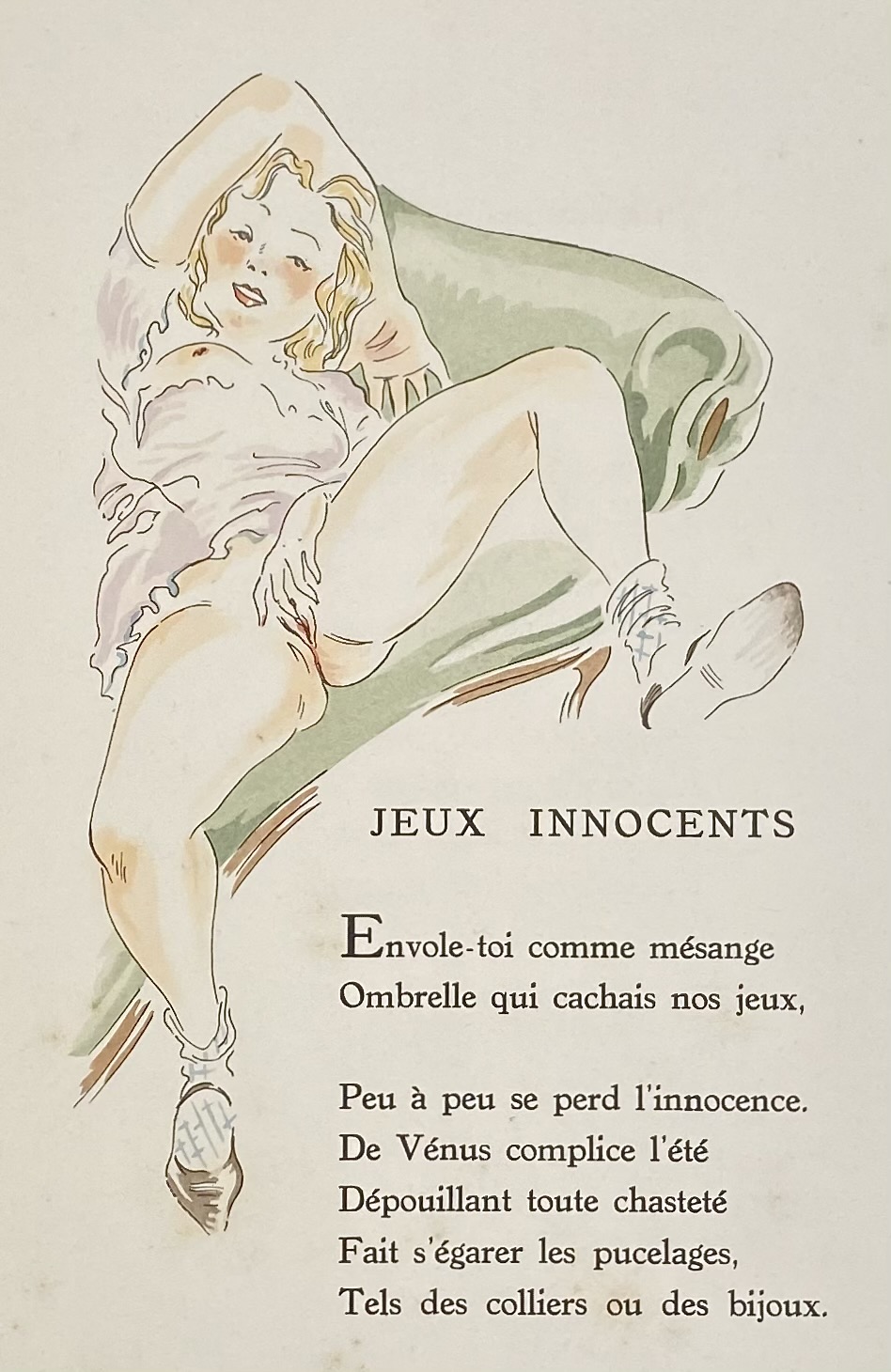
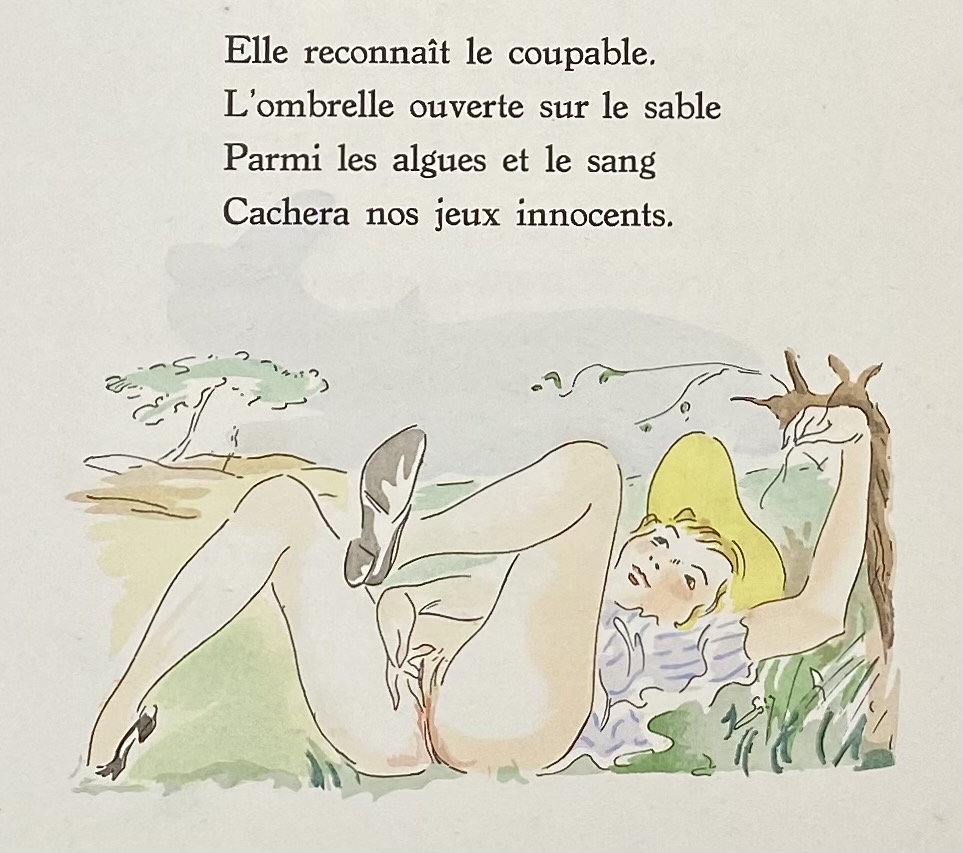
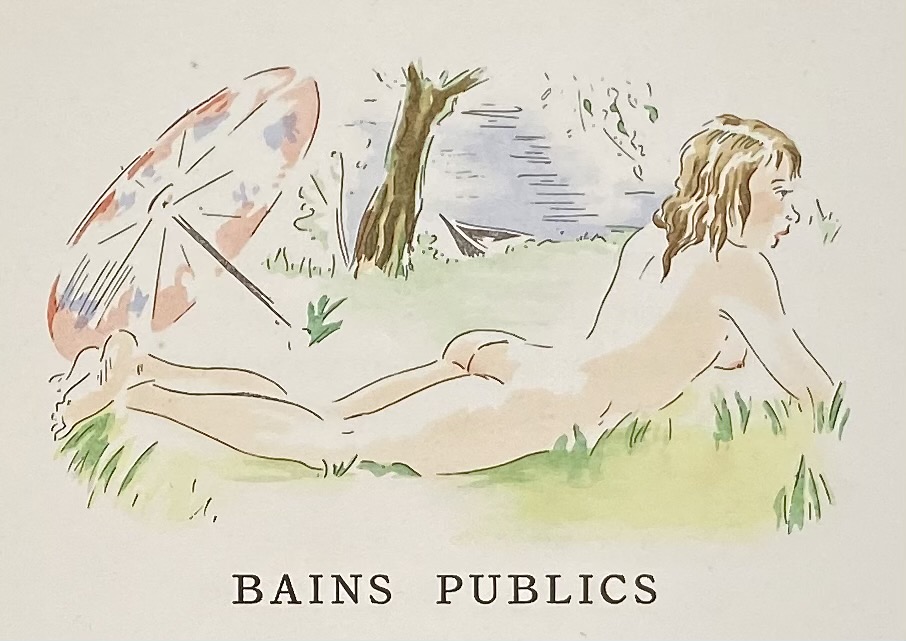
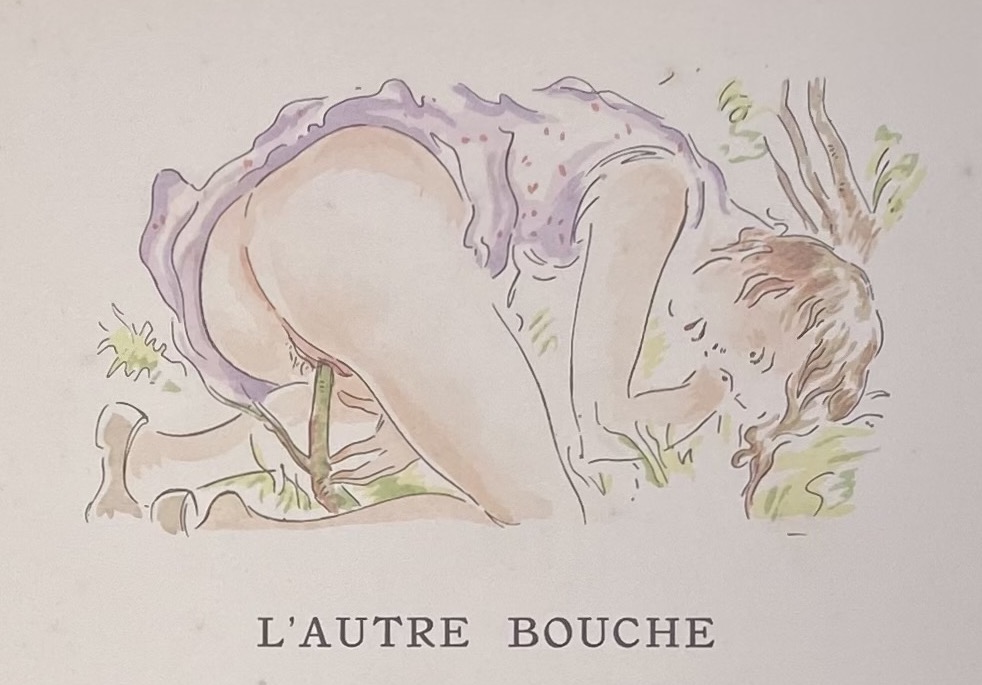
-
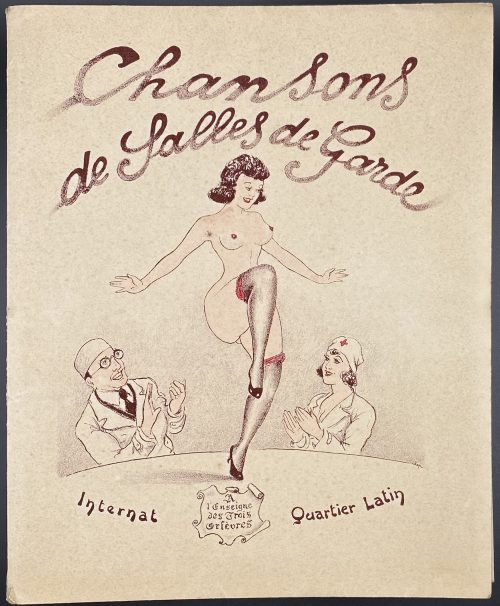 Title: Chansons | de Salles de Garde | {vignette} | Internat { À l’Enseigne des Trois Orfèvres } Quartier Latin || Collation: 21 leaves folded in half (84 pages), unpaginated, unbound, plus 40 plates (two-tone lithography) for 40 songs, in a flapped paper folder, in a green cardstock folder (slipcase without top and bottom?) with gilt diaper ornament. Text, music score, and drawings printed in brick red. Size: 28 x 22.5 cm. Edition: limited to 700 copies of which 100 (№ 1-100) on Vélin Arches, 650 (№ 101-650) on Vélin Spécial, and 50 without numbering marked “Exemplaire d’interne” on Vélin Supérieur. This copy is № 27. Catalogue raisonné: Dutel 1920 – 1970: 1192.
Title: Chansons | de Salles de Garde | {vignette} | Internat { À l’Enseigne des Trois Orfèvres } Quartier Latin || Collation: 21 leaves folded in half (84 pages), unpaginated, unbound, plus 40 plates (two-tone lithography) for 40 songs, in a flapped paper folder, in a green cardstock folder (slipcase without top and bottom?) with gilt diaper ornament. Text, music score, and drawings printed in brick red. Size: 28 x 22.5 cm. Edition: limited to 700 copies of which 100 (№ 1-100) on Vélin Arches, 650 (№ 101-650) on Vélin Spécial, and 50 without numbering marked “Exemplaire d’interne” on Vélin Supérieur. This copy is № 27. Catalogue raisonné: Dutel 1920 – 1970: 1192. -
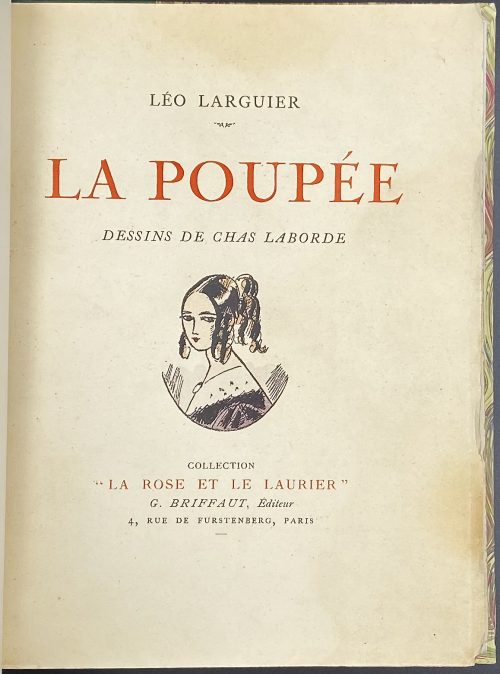 Description: owner’s quarter green morocco over marbled boards, 21.5 x 16.5 cm, collated 8vo, illustrated with numerous in-text and 5 full-page coloured etchings after drawings by Chas Laborde. Original publisher’s wrappers preserved, enriched with a set of 17 plates in black and white (bound in). Front wrapper (black and red): LÉO LARGUIER | LA POUPÉE | DESSINS DE CHAS LABORDE | {vignette} | COLLECTION | “LA ROSE ET LE LAURIER” | G. BRIFFAUT, Éditeur | 4, RUE DE FURSTENBERG, PARIS || Title-page: LÉO LARGUIER | — | LA POUPÉE | DESSINS DE | CHAS LABORDE | {vignette} | COLLECTION DE | “LA ROSE ET LE LAURIER” | G. BRIFFAUT, Éditeur | 4, RUE DE FURSTENBERG, PARIS (VIe) | M CM XXV || Collation: Three binder’s blanks, 1 front wrapper, 1 blank, 1 h.t./limit., 1 t.p., 1 epigraph, 1-68 74 (last blank), plates within collation, 1 back wrapper, three binder’s blanks, plus 17 leaves of b/w plates. Pagination: not counting wrappers, [6] (h.t., t.p., epigraph) 1-99 [100] [4], ils. Limitation: A print run of 770 copies on April 25, 1925, by Coulouma (Argenteuil) under the direction of H. Barthélemy , of which 10 copies on Japon Impérial (№ 1-10) + one drawing + one b/w suite, 10 copies on Japon Impérial (№ 11-20) + one drawing, 750 copies on Vélin (№ 21-770). This is copy № 1 (on Japon Impérial with b/w suite of plates but without the drawing). Contributors: Léo Larguier (French, 1878 – 1950) – author. Chas Laborde [Charles Laborde] (French, 1886 – 1941) – artist. Georges Briffaut (French, 1886 – 1973) – publisher.
Description: owner’s quarter green morocco over marbled boards, 21.5 x 16.5 cm, collated 8vo, illustrated with numerous in-text and 5 full-page coloured etchings after drawings by Chas Laborde. Original publisher’s wrappers preserved, enriched with a set of 17 plates in black and white (bound in). Front wrapper (black and red): LÉO LARGUIER | LA POUPÉE | DESSINS DE CHAS LABORDE | {vignette} | COLLECTION | “LA ROSE ET LE LAURIER” | G. BRIFFAUT, Éditeur | 4, RUE DE FURSTENBERG, PARIS || Title-page: LÉO LARGUIER | — | LA POUPÉE | DESSINS DE | CHAS LABORDE | {vignette} | COLLECTION DE | “LA ROSE ET LE LAURIER” | G. BRIFFAUT, Éditeur | 4, RUE DE FURSTENBERG, PARIS (VIe) | M CM XXV || Collation: Three binder’s blanks, 1 front wrapper, 1 blank, 1 h.t./limit., 1 t.p., 1 epigraph, 1-68 74 (last blank), plates within collation, 1 back wrapper, three binder’s blanks, plus 17 leaves of b/w plates. Pagination: not counting wrappers, [6] (h.t., t.p., epigraph) 1-99 [100] [4], ils. Limitation: A print run of 770 copies on April 25, 1925, by Coulouma (Argenteuil) under the direction of H. Barthélemy , of which 10 copies on Japon Impérial (№ 1-10) + one drawing + one b/w suite, 10 copies on Japon Impérial (№ 11-20) + one drawing, 750 copies on Vélin (№ 21-770). This is copy № 1 (on Japon Impérial with b/w suite of plates but without the drawing). Contributors: Léo Larguier (French, 1878 – 1950) – author. Chas Laborde [Charles Laborde] (French, 1886 – 1941) – artist. Georges Briffaut (French, 1886 – 1973) – publisher. -
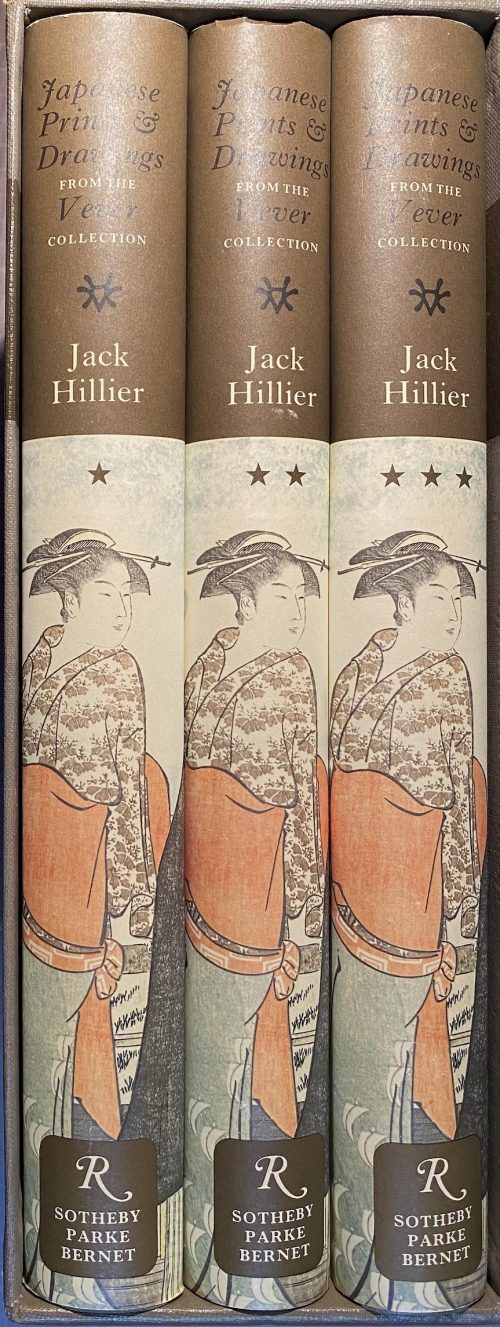 Description: Three volumes, in brown cloth, gilt-lettered to front and spine, in pictorial dust jacket, 34 x 25 cm each, T.E.G., in a slipcase 35 x 25.5 x 13.5 cm. Pagination: Vol. 1: [i-vi] vii-xix [xx] 1-349 [1 blank], ils. №№ 1-382; Vol. 2: [7] 350-673 [1], ils. №№ 383-667 ; Vol. 3: [7] 674-1034, ils. №№ 668-973. Edition: Limited edition of 2,000 copies of which this is copy № 935. Title-page: JACK HILLIER | Japanese Prints | & Drawings from | the Vever Collection | Volume One (Two; Three) | Rizzoli International | Sotheby Parke Bernet | 1976 || Contributors: Jack Ronald Hillier (British, 1912 – 1995) Henri Vever (French, 1854 – 1942)
Description: Three volumes, in brown cloth, gilt-lettered to front and spine, in pictorial dust jacket, 34 x 25 cm each, T.E.G., in a slipcase 35 x 25.5 x 13.5 cm. Pagination: Vol. 1: [i-vi] vii-xix [xx] 1-349 [1 blank], ils. №№ 1-382; Vol. 2: [7] 350-673 [1], ils. №№ 383-667 ; Vol. 3: [7] 674-1034, ils. №№ 668-973. Edition: Limited edition of 2,000 copies of which this is copy № 935. Title-page: JACK HILLIER | Japanese Prints | & Drawings from | the Vever Collection | Volume One (Two; Three) | Rizzoli International | Sotheby Parke Bernet | 1976 || Contributors: Jack Ronald Hillier (British, 1912 – 1995) Henri Vever (French, 1854 – 1942) -
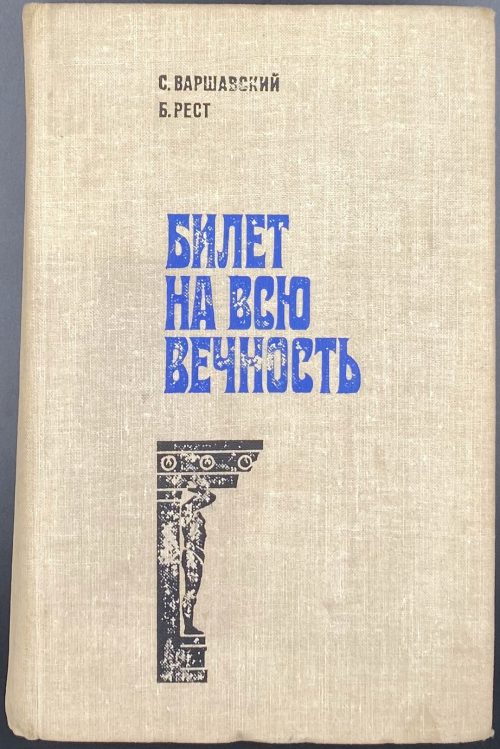 A book about the history and collections of The Hermitage museum in St. Petersburg during the October revolution of 1917. Hardcover, collated 16mo, 20,7 x 13.5 cm, grey cloth, black and blue lettering to front, blue lettering to spine, blue endpapers; collation: [1]8 2-1616 (total 248 leaves); pp.: [2] 3-493 [3] (total 496 pages) plus frontispiece. 1st edition (lifetime). Title-page: С. ВАРШАВСКИЙ | Б. РЕСТ | БИЛЕТ | НА ВСЮ | ВЕЧНОСТЬ | ПОВЕСТЬ | ОБ ЭРМИТАЖЕ | ЛЕНИЗДАТ • 1978 || Sergei Petrovich Varshavsky [Сергей Петрович Варшавский] (Jewish-Russian, 1906 – 1980). B. Rest [Б. Рест; Юлий Исаакович Шапиро] (Jewish-Russian, fl. 1940 – 1980). Борис Борисович Пиотровский (Russian, 1908 – 1990).
A book about the history and collections of The Hermitage museum in St. Petersburg during the October revolution of 1917. Hardcover, collated 16mo, 20,7 x 13.5 cm, grey cloth, black and blue lettering to front, blue lettering to spine, blue endpapers; collation: [1]8 2-1616 (total 248 leaves); pp.: [2] 3-493 [3] (total 496 pages) plus frontispiece. 1st edition (lifetime). Title-page: С. ВАРШАВСКИЙ | Б. РЕСТ | БИЛЕТ | НА ВСЮ | ВЕЧНОСТЬ | ПОВЕСТЬ | ОБ ЭРМИТАЖЕ | ЛЕНИЗДАТ • 1978 || Sergei Petrovich Varshavsky [Сергей Петрович Варшавский] (Jewish-Russian, 1906 – 1980). B. Rest [Б. Рест; Юлий Исаакович Шапиро] (Jewish-Russian, fl. 1940 – 1980). Борис Борисович Пиотровский (Russian, 1908 – 1990). -
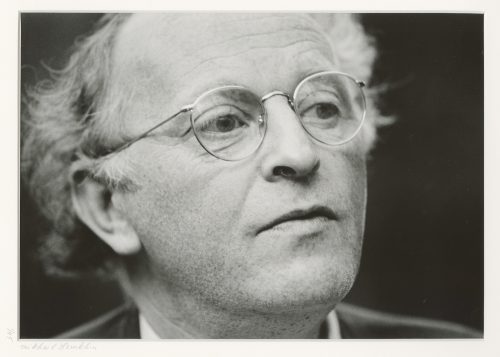 Photographic portrait of poet Joseph Brodsky, head and shoulders, three-quarters to the right, wearing glasses. Pencil-signed on the mat: 1/45 • Mikhail Lemkhin; same inscription on the back of the print, and ink stamp ©Mikhail Lemkhin. Sitter: Joseph Brodsky [Иосиф Александрович Бродский ] (Russian-American-Jewish, 1940 – 1996). Size: mat: 40.5 x 51 cm; window: 24.5 x 35 cm; print: 27.7 x 35.4 cm.
Photographic portrait of poet Joseph Brodsky, head and shoulders, three-quarters to the right, wearing glasses. Pencil-signed on the mat: 1/45 • Mikhail Lemkhin; same inscription on the back of the print, and ink stamp ©Mikhail Lemkhin. Sitter: Joseph Brodsky [Иосиф Александрович Бродский ] (Russian-American-Jewish, 1940 – 1996). Size: mat: 40.5 x 51 cm; window: 24.5 x 35 cm; print: 27.7 x 35.4 cm. -
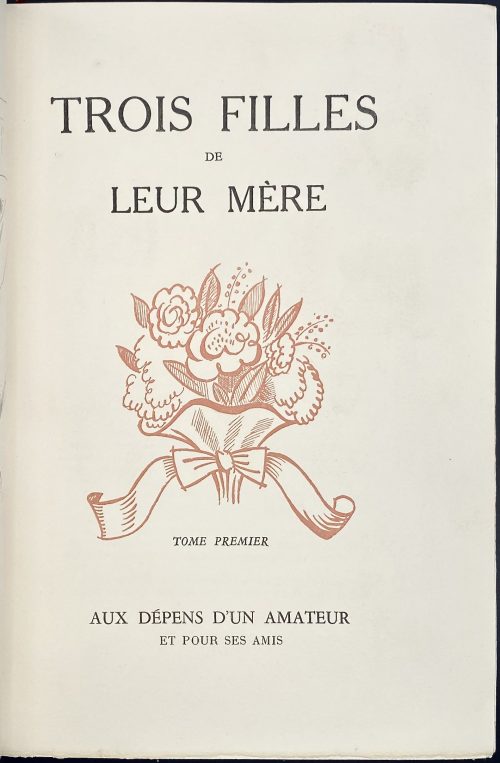 Two softcover volumes bound in one, 28.7 x 20.5 cm, quarter blue morocco over marbled boards, raised bands and gilt lettering to spine, top margin gilt, other untrimmed, marbled endpapers, original covers and spines preserved; 20 full-page etchings by Louis Berthommé Saint-André, incl. 2 frontispieces; vignettes, initials, head- and tailpieces in pink after André Collot. Title-page: TROIS FILLES | DE | LEUR MÈRE | {vignette} | TOME PREMIER (SECOND) | AUX DÉPENS D'UN AMATEUR | ET POUR SES AMIS || Collation: v.1 2ffl, front cover, [1-8] 2 blanks, h.t., t.p., pp. 9-94 [95, 96]; v.2 back cover, spine, front cover, 2 blanks, h.t., t.p., 97-201 [202-4] back cover, spine, 2ffl; plus 20 plates extraneous to collation. Limitation: A print run of 150 copies, of which this is copy № 76. Catalogue raisonné: Dutel III № 2521. As per Dutel, pp: 96+106 (conforms), and the year of 2 vol. publication 1933; however, the etchings are dated to 1926 by many. Contributors: Pierre Louÿs (French, 1870 – 1925) – author. Louis Berthommé Saint-André (French, 1905 – 1977) – artist. André Collot (French, 1897 – 1976) – artist.
Two softcover volumes bound in one, 28.7 x 20.5 cm, quarter blue morocco over marbled boards, raised bands and gilt lettering to spine, top margin gilt, other untrimmed, marbled endpapers, original covers and spines preserved; 20 full-page etchings by Louis Berthommé Saint-André, incl. 2 frontispieces; vignettes, initials, head- and tailpieces in pink after André Collot. Title-page: TROIS FILLES | DE | LEUR MÈRE | {vignette} | TOME PREMIER (SECOND) | AUX DÉPENS D'UN AMATEUR | ET POUR SES AMIS || Collation: v.1 2ffl, front cover, [1-8] 2 blanks, h.t., t.p., pp. 9-94 [95, 96]; v.2 back cover, spine, front cover, 2 blanks, h.t., t.p., 97-201 [202-4] back cover, spine, 2ffl; plus 20 plates extraneous to collation. Limitation: A print run of 150 copies, of which this is copy № 76. Catalogue raisonné: Dutel III № 2521. As per Dutel, pp: 96+106 (conforms), and the year of 2 vol. publication 1933; however, the etchings are dated to 1926 by many. Contributors: Pierre Louÿs (French, 1870 – 1925) – author. Louis Berthommé Saint-André (French, 1905 – 1977) – artist. André Collot (French, 1897 – 1976) – artist. -
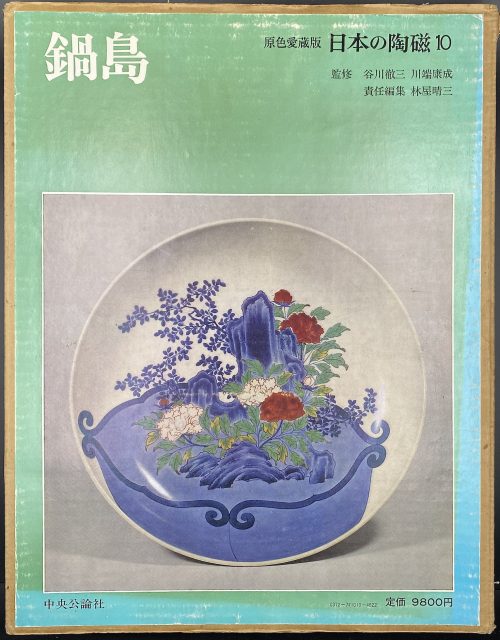 Hardcover volume, 35 x 26.8 cm, bound in grey cloth, blind stamped characters to front, brown characters to spine, in a double slipcase, the outer case pictorial paper over cardboard, 36 x 28.2 cm, pp.: [4] [1] 2-144 (plates with photographs of 332 items), [2] 147-182 [4]. 鍋島 – Nabeshima – book title. 日本の陶磁 – Japanese ceramics, series title. Contributors: Yasunari Kawabata [川端 康成] (Japanese, 1924 – 1972) – author. Tetsuzo Tanikawa [谷川 徹三] (Japanese, 1895 – 1989) – author. Seizo Hayashiya [林屋晴三] (Japanese, 1928 – 2017) – editor. Chūōkōron-sha [中央公論社] – publisher.
Hardcover volume, 35 x 26.8 cm, bound in grey cloth, blind stamped characters to front, brown characters to spine, in a double slipcase, the outer case pictorial paper over cardboard, 36 x 28.2 cm, pp.: [4] [1] 2-144 (plates with photographs of 332 items), [2] 147-182 [4]. 鍋島 – Nabeshima – book title. 日本の陶磁 – Japanese ceramics, series title. Contributors: Yasunari Kawabata [川端 康成] (Japanese, 1924 – 1972) – author. Tetsuzo Tanikawa [谷川 徹三] (Japanese, 1895 – 1989) – author. Seizo Hayashiya [林屋晴三] (Japanese, 1928 – 2017) – editor. Chūōkōron-sha [中央公論社] – publisher. -
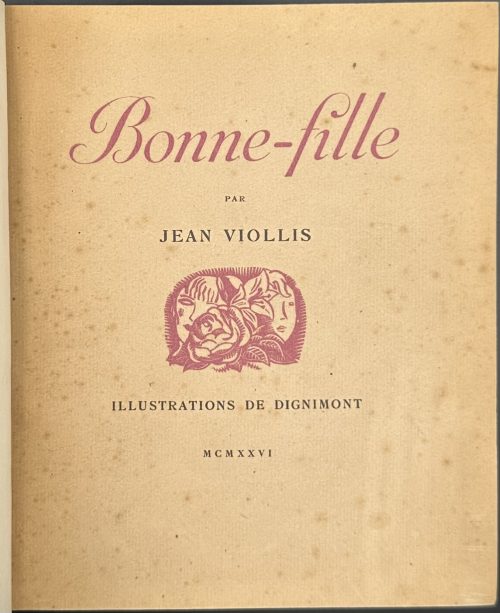 Hardcover volume, 22.5 x 19.5 cm, collated 4to, owner’s terracotta cloth with gilt-lettered black label to spine, publisher’s wrappers preserved, pp.:3 ffl, front wrapper, 3 ffl, [2] h.t./limit, [2] t.p./blank, 1-228 [2] 3 ffl, back wrapper, 3 ffl. Collation: π3 1-314 323. (130 leaves, incl. plates). Title-page (pink and black): Bonne-fille | PAR | JEAN VIOLLIS | Illustrations de | DIGNIMONT | {vignette} | A PARIS | La Collection Originale | ÉDITIONS MORNAY | 37, BOULEVARD DU MONTPARNASSE | MCMXXVI || Illustrations: 14 full-page colour plates, incl. frontispiece and endpiece, within collation but not within pagination, verso blank, and numerous head- and tailpieces and in-text stencil-coloured (au pochoir) lithography after André Dignimont. Limitation: A print run of 628 copies for sale, of which 18 on Japon Ancien, 30 on Japon Impérial, 90 on Hollande, 490 on Rives (139-628), plus 50 copies not for sale. Printed on May 12, 1926, at l’Imprimerie Kapp (Vanves), this copy is № 380. Provenance: Feodor Rojankovsky, pictorial bookplate “ИЗ КНИГ РОЖАНКОВСКАГО” to front pastedown, ms inscription to front ffl2 top “TH. ROJANKOWSKY | 14 VIII 30” in block letters. One of the possible transliterations of Feodor Rojankovsky's name is Theodor Rojankowsky. Contributors: Jean-Henri d'Ardenne deTizac [JeanViollis] (French, 1877 – 1932) – author. André Dignimont (French, 1891 – 1965) – artist. Frédéric Emile Kapp (French, 1851-193?) – printer. Georges Mornay (French, 1876 – 1935) et Antoinette Mornay – pubishers. Feodor Rojankovsky [Rojan; Фёдор Степанович Рожанковский] (Russian-American, 1891 – 1970) – provenance.
Hardcover volume, 22.5 x 19.5 cm, collated 4to, owner’s terracotta cloth with gilt-lettered black label to spine, publisher’s wrappers preserved, pp.:3 ffl, front wrapper, 3 ffl, [2] h.t./limit, [2] t.p./blank, 1-228 [2] 3 ffl, back wrapper, 3 ffl. Collation: π3 1-314 323. (130 leaves, incl. plates). Title-page (pink and black): Bonne-fille | PAR | JEAN VIOLLIS | Illustrations de | DIGNIMONT | {vignette} | A PARIS | La Collection Originale | ÉDITIONS MORNAY | 37, BOULEVARD DU MONTPARNASSE | MCMXXVI || Illustrations: 14 full-page colour plates, incl. frontispiece and endpiece, within collation but not within pagination, verso blank, and numerous head- and tailpieces and in-text stencil-coloured (au pochoir) lithography after André Dignimont. Limitation: A print run of 628 copies for sale, of which 18 on Japon Ancien, 30 on Japon Impérial, 90 on Hollande, 490 on Rives (139-628), plus 50 copies not for sale. Printed on May 12, 1926, at l’Imprimerie Kapp (Vanves), this copy is № 380. Provenance: Feodor Rojankovsky, pictorial bookplate “ИЗ КНИГ РОЖАНКОВСКАГО” to front pastedown, ms inscription to front ffl2 top “TH. ROJANKOWSKY | 14 VIII 30” in block letters. One of the possible transliterations of Feodor Rojankovsky's name is Theodor Rojankowsky. Contributors: Jean-Henri d'Ardenne deTizac [JeanViollis] (French, 1877 – 1932) – author. André Dignimont (French, 1891 – 1965) – artist. Frédéric Emile Kapp (French, 1851-193?) – printer. Georges Mornay (French, 1876 – 1935) et Antoinette Mornay – pubishers. Feodor Rojankovsky [Rojan; Фёдор Степанович Рожанковский] (Russian-American, 1891 – 1970) – provenance. -
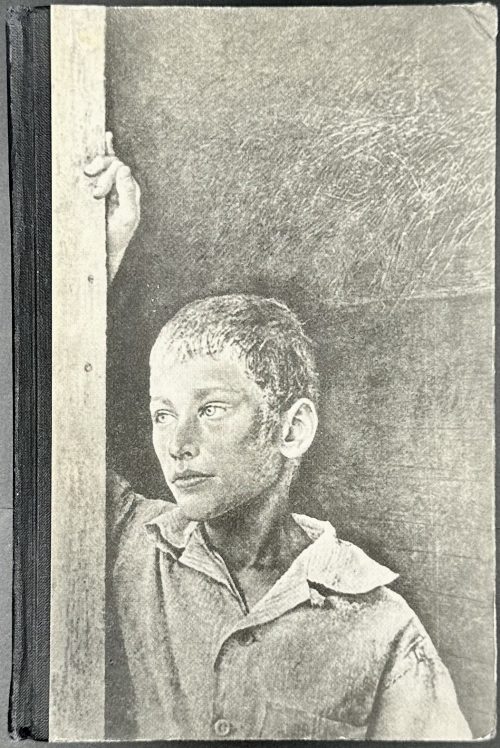 Hardcover, 22.2 x 14.6 cm, quarter black cloth, pictorial boards, lettering to spine; pp.: [2] 3-253 [3], collated 8vo: 1-168, total 128 leaves plus portrait frontispiece. Title-page: Дж. Д. СЭЛИНДЖЕР | ПОВЕСТИ | НАД ПРОПАСТЬЮ | ВО РЖИ | ВЫШЕ СТРОПИЛА, | ПЛОТНИКИ | РАССКАЗЫ | ХОРОШО ЛОВИТСЯ | РЫБКА-БАНАНКА | ЧЕЛОВЕК, КОТОРЫЙ | СМЕЯЛСЯ | ГОЛУБОЙ ПЕРИОД | ДЕ ДОМЬЕ-СМИТА | ЛАПА-РАСТЯПА | ПЕРЕВОД С АНГЛИЙСКОГО | И ПРЕДИСЛОВИЕ | Р. РАЙТ-КОВАЛЕВОЙ | ИЗДАТЕЛЬСТВО ЦК ВЛКСМ | «МОЛОДАЯ ГВАРДИЯ», 1965 || T.p. verso: […] J. D. Salinger | The Catcher in the Rye | Raise high the Roof Beam, Carpenters | A Perfect Day for Bananafish | The Laughing Man | De Daumier — Smith’s Blue Period | Uncle Wiggly in Connecticut | Художник Б. Жутовский | (В оформлении использован фрагмент картины | американского художника Э. Уайеса) || Print run: 115,000 copies. Contributors: [Джером Дэвид Сэлинджер] Jerome David Salinger (American, 1919 – 2010) Райт-Ковалёва, Рита [Черномордик, Раиса Яковлевна] (Russian, 1898 – 1988) Жутовский, Борис Иосифович (Russian, 1932 – 2023) «Э. Уайес» – [Эндрю Уайет] Andrew Wyeth (American, 1917 – 2009)
Hardcover, 22.2 x 14.6 cm, quarter black cloth, pictorial boards, lettering to spine; pp.: [2] 3-253 [3], collated 8vo: 1-168, total 128 leaves plus portrait frontispiece. Title-page: Дж. Д. СЭЛИНДЖЕР | ПОВЕСТИ | НАД ПРОПАСТЬЮ | ВО РЖИ | ВЫШЕ СТРОПИЛА, | ПЛОТНИКИ | РАССКАЗЫ | ХОРОШО ЛОВИТСЯ | РЫБКА-БАНАНКА | ЧЕЛОВЕК, КОТОРЫЙ | СМЕЯЛСЯ | ГОЛУБОЙ ПЕРИОД | ДЕ ДОМЬЕ-СМИТА | ЛАПА-РАСТЯПА | ПЕРЕВОД С АНГЛИЙСКОГО | И ПРЕДИСЛОВИЕ | Р. РАЙТ-КОВАЛЕВОЙ | ИЗДАТЕЛЬСТВО ЦК ВЛКСМ | «МОЛОДАЯ ГВАРДИЯ», 1965 || T.p. verso: […] J. D. Salinger | The Catcher in the Rye | Raise high the Roof Beam, Carpenters | A Perfect Day for Bananafish | The Laughing Man | De Daumier — Smith’s Blue Period | Uncle Wiggly in Connecticut | Художник Б. Жутовский | (В оформлении использован фрагмент картины | американского художника Э. Уайеса) || Print run: 115,000 copies. Contributors: [Джером Дэвид Сэлинджер] Jerome David Salinger (American, 1919 – 2010) Райт-Ковалёва, Рита [Черномордик, Раиса Яковлевна] (Russian, 1898 – 1988) Жутовский, Борис Иосифович (Russian, 1932 – 2023) «Э. Уайес» – [Эндрю Уайет] Andrew Wyeth (American, 1917 – 2009) -
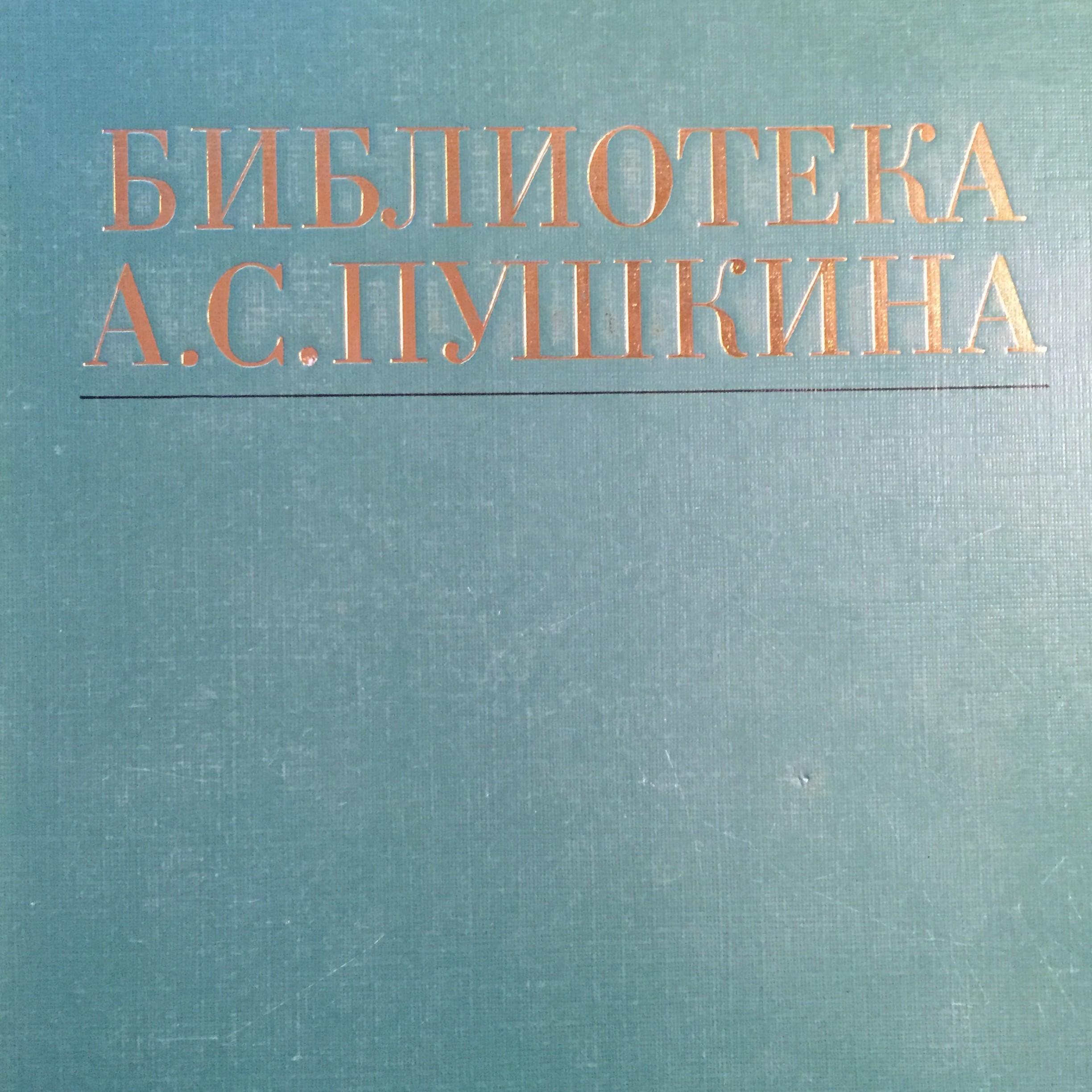
Б. Л. Модзалевский. Библиотека А.С.Пушкина. Библиографическое описание. Отдѣльный оттискъ из изданiя "Пушкинъ и его современники", вып. IX-X. -- СПб.: Тип. Императорской Академiи Наук, 1910. - 442 стр. [РЕПРИНТ 1988 года.]
Библиотека А. С. Пушкина. Б. Л. Модзалевский. Приложение к репринтному изданию. -- М.: Книга, 1988. - 115 стр. Тираж 10 000 экз.
Л. Б. Модзалевский. Библиотека Пушкина. Новые материалы.
Список условных сокращений.
Л. С. Сидяков. Библиотека Пушкина и ее описание.
Примечание к работам Б. Л. и Л. Б. Модзалевских.
-
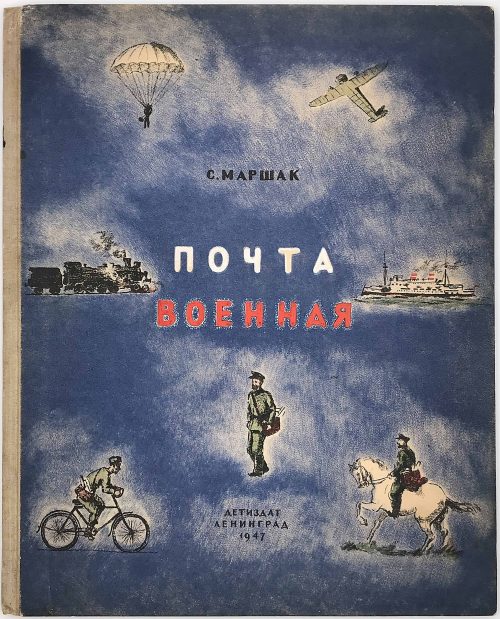 С. Маршак. Почта военная. Детиздат : Ленинград, 1947.
С. Маршак. Почта военная. Детиздат : Ленинград, 1947.Hard-bound Quatro (304 x 246 mm) printed in lithography with hand-colored details on cover.
The name of artist hardly legible on a stamp on frontispiece: скворцов.
The text repeats itself on multiple pages. Most probably the book is a pilot run, never went to mass printing and distribution. -
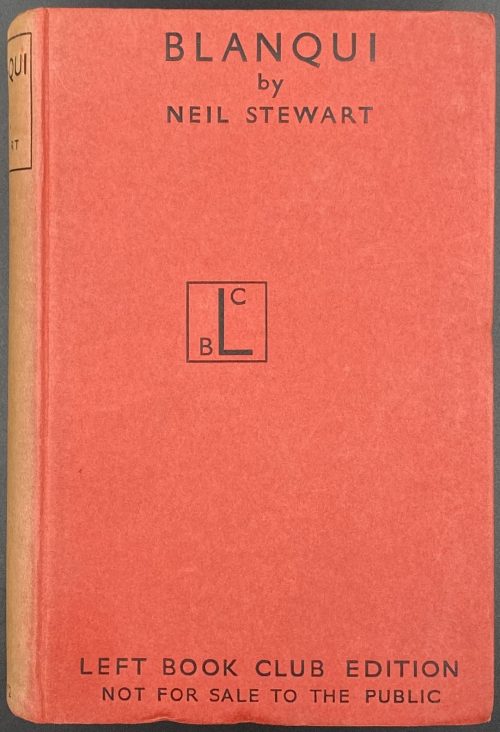 Title: BLANQUI | by | NEIL STEWART | [blank] | LONDON | VICTOR GOLLANCZ LTD | 1939 || Pagination: [1-7] 8-352. Binding: 20 x 13.5 cm; Red cardstock boards with black lettering, the front board: BLANQUI | by | NEIL STEWART | {BCL device} | LEFT BOOK CLUB EDITION | NOT FOR SALE TO THE PUBLIC ||; Spine with black lettering in the frame, sunned.
Title: BLANQUI | by | NEIL STEWART | [blank] | LONDON | VICTOR GOLLANCZ LTD | 1939 || Pagination: [1-7] 8-352. Binding: 20 x 13.5 cm; Red cardstock boards with black lettering, the front board: BLANQUI | by | NEIL STEWART | {BCL device} | LEFT BOOK CLUB EDITION | NOT FOR SALE TO THE PUBLIC ||; Spine with black lettering in the frame, sunned. -
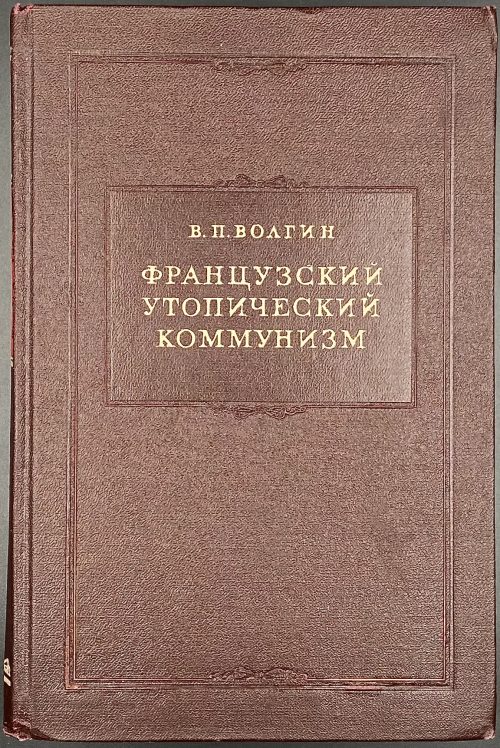 Title page: АКАДЕМИЯ НАУК СССР | В. П. ВОЛГИН. | ФРАНЦУЗСКИЙ | УТОПИЧЕСКИЙ | КОММУНИЗМ | ИЗДАТЕЛЬСТВО АКАДЕМИИ НАУК СССР | МОСКВА 1960 || Pagination: [1-5] 6-375 [376], errata slip. Collation: 8vo; [1]-228, 234, 248 (total 188 leaves) + errata slip; 171 unsigned. Print run: 4200 copies. Binding: Burgundy buckram, lettering in blind-stamped frame: В. П. Волгин. Французский утопический коммунизм. Contributor: Волгин, Вячеслав Петрович (Russian, 1879 – 1962) – author.
Title page: АКАДЕМИЯ НАУК СССР | В. П. ВОЛГИН. | ФРАНЦУЗСКИЙ | УТОПИЧЕСКИЙ | КОММУНИЗМ | ИЗДАТЕЛЬСТВО АКАДЕМИИ НАУК СССР | МОСКВА 1960 || Pagination: [1-5] 6-375 [376], errata slip. Collation: 8vo; [1]-228, 234, 248 (total 188 leaves) + errata slip; 171 unsigned. Print run: 4200 copies. Binding: Burgundy buckram, lettering in blind-stamped frame: В. П. Волгин. Французский утопический коммунизм. Contributor: Волгин, Вячеслав Петрович (Russian, 1879 – 1962) – author. -
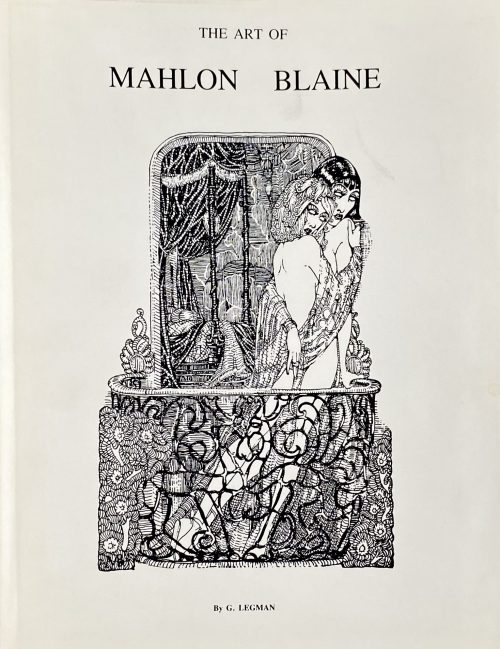 Title page: THE ART OF | MAHLON BLAINE | A Reminiscence | by G. Legman | with a Mahlon Blaine bibliography | compiled by Roland Trenary | {Blaine’s fac-simile} | Peregrine Books | 1982 || Pagination: [1-4] 5-26 + 84 pp. of illustrations, unpaginated. Collation: 13 leaves of text, 40 leaves of b/w plates, and 2 leaves of colour plates, 55 leaves total. Binding: 29 x 22.5 cm; publisher’s black cloth, silver lettering to spine, pictorial endpapers, pictorial dust jacket. Edition: Limited edition of 100 copies (this is №100), signed by Gelman, Trenary, and Arrington. Contributors: Blaine, Mahlon (American, 1894 – 1969) – illustrator. Legman, Gershon (American, 1917 – 1999) – author. Arrington, Robert L. (American, 1984 – 2015) – author, introduction. Trenary, Roland (American) – author, compiler. Peregrine Books (East Lansing, MI) – publisher.
Title page: THE ART OF | MAHLON BLAINE | A Reminiscence | by G. Legman | with a Mahlon Blaine bibliography | compiled by Roland Trenary | {Blaine’s fac-simile} | Peregrine Books | 1982 || Pagination: [1-4] 5-26 + 84 pp. of illustrations, unpaginated. Collation: 13 leaves of text, 40 leaves of b/w plates, and 2 leaves of colour plates, 55 leaves total. Binding: 29 x 22.5 cm; publisher’s black cloth, silver lettering to spine, pictorial endpapers, pictorial dust jacket. Edition: Limited edition of 100 copies (this is №100), signed by Gelman, Trenary, and Arrington. Contributors: Blaine, Mahlon (American, 1894 – 1969) – illustrator. Legman, Gershon (American, 1917 – 1999) – author. Arrington, Robert L. (American, 1984 – 2015) – author, introduction. Trenary, Roland (American) – author, compiler. Peregrine Books (East Lansing, MI) – publisher. -
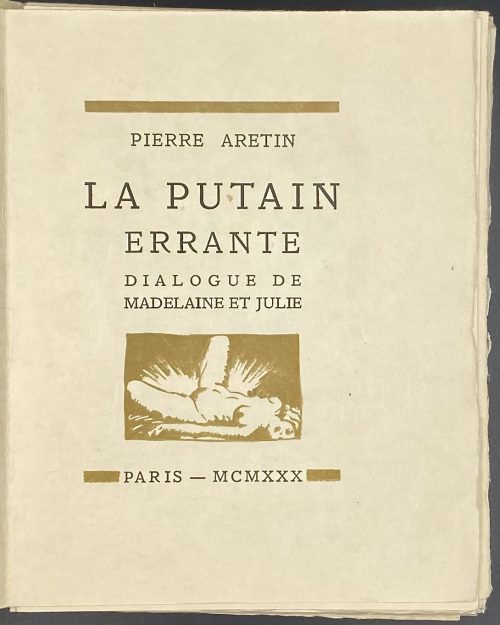 Title page (black lettering, gold elements of design): PIERRE ARETIN | LA PUTAIN | ERRANTE | DIALOGUE DE | MADELINE ET JULIE | {woodcut vignette} | PARIS — MCMXXX || Pagination: Red and gilt faux-marbled slipcase (19.5 x 15.5 cm), similar folder (18.7 x 15.1 cm), cream wove paper wrapper (18.5 x 14.7 cm) with gilt lettering “LA PUTAIN | ERRANTE”, with loosely inserted leaves printed on Japanese "mother-of-pearl" paper (japon nacré): [4] – blanks, [2] – h.t. / blank, [2] – t.p. / blank, 1-62, [2] – colophon / blank [4 blanks], gilt woodcut to p. 1; 76 pages total, plus 12 hand-coloured etchings (17.2 x 14.7 cm) by André Collot, extraneous to collation. Collation: 4to; π4, 1-84 χ2, 38 leaves total. Edition: 1st edition, limited to 150 copies, this is copy № 000009 (stamped in black ink). Catalogue raisonné: Dutel (1920-1970): № 2275, p. 333; Honesterotica. Contributors: Pietro Aretino (Italian, 1492 – 1556) – author (attributed). André Collot (French, 1897 – 1976) – artist.
Title page (black lettering, gold elements of design): PIERRE ARETIN | LA PUTAIN | ERRANTE | DIALOGUE DE | MADELINE ET JULIE | {woodcut vignette} | PARIS — MCMXXX || Pagination: Red and gilt faux-marbled slipcase (19.5 x 15.5 cm), similar folder (18.7 x 15.1 cm), cream wove paper wrapper (18.5 x 14.7 cm) with gilt lettering “LA PUTAIN | ERRANTE”, with loosely inserted leaves printed on Japanese "mother-of-pearl" paper (japon nacré): [4] – blanks, [2] – h.t. / blank, [2] – t.p. / blank, 1-62, [2] – colophon / blank [4 blanks], gilt woodcut to p. 1; 76 pages total, plus 12 hand-coloured etchings (17.2 x 14.7 cm) by André Collot, extraneous to collation. Collation: 4to; π4, 1-84 χ2, 38 leaves total. Edition: 1st edition, limited to 150 copies, this is copy № 000009 (stamped in black ink). Catalogue raisonné: Dutel (1920-1970): № 2275, p. 333; Honesterotica. Contributors: Pietro Aretino (Italian, 1492 – 1556) – author (attributed). André Collot (French, 1897 – 1976) – artist. -
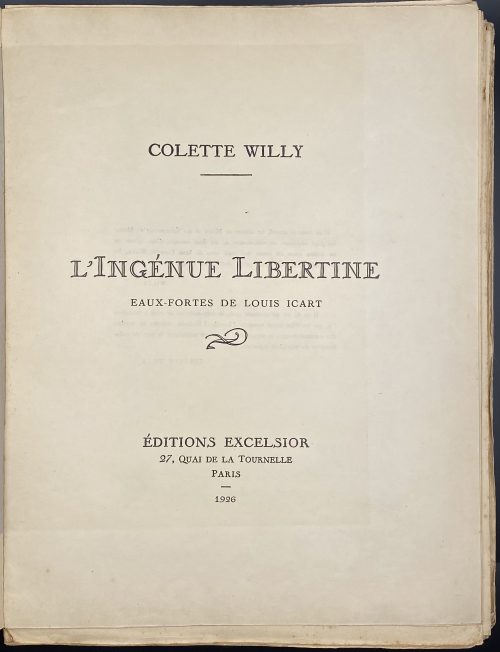 Title-page: COLETTE WILLY | — | L'ingénue libertine | EAUX-FORTES DE LOUIS ICART | ❧ | ÉDITIONS EXCELSIOR | 27, Quai de la Tournelle | Paris | 1926 || Description: French cream flapped wrappers 33.5 x 26 cm with gilt lettering to front and spine, printed on wove paper (Japon Impérial), [2] blank, [1-4] h.t. / limitation, t.p. / citations, 5-191 [3] colophon, plus 20 plates of coloured etchings and 20 plates of b/w etchings, incl. frontispiece. Edition enriched with an autograph letter signed by Colette tipped in after limitation. Edition: limited to 546 copies of which one (№ UN) is unique, printed on Papier de Chine with original colour drawings, 55 (№ 1-50 + 5 H.C.) on Japon Impérial, 65 (№ 51-100 +15 H.C.) on Hollande van Gelder, and 425 (№ 101-500 + 25 H.C.) on vergé paper BFK Rives. This copy is № 48, enriched with Colette a.l.s. and an extra suite of plates. Printed on December 3, 1926, at Arrault et Cie in Tours. Transcript of a.l.s.: "De deux romans (Minne et Les égarements de Minne) qui ne portèrent pas ma signature, j’en ai fait un seul : l’Ingénue libertine. La première partie trouve encore grâce à mes yeux ; je suis plus sévère pour la deuxième et dernière, [mot rayé] superflue et qui sent le travail. Cette libertine aurait bien dû en rester à l’ingénuité. — Colette" Contributors: Sidonie-Gabrielle Colette [a.k.a. Colette] (French, 1873 – 1954) – author. Henry Gauthier-Villars [a.k.a. Willy] (French, 1859 – 1931) – author. Louis Icart (French, 1888 – 1950) – artist.
Title-page: COLETTE WILLY | — | L'ingénue libertine | EAUX-FORTES DE LOUIS ICART | ❧ | ÉDITIONS EXCELSIOR | 27, Quai de la Tournelle | Paris | 1926 || Description: French cream flapped wrappers 33.5 x 26 cm with gilt lettering to front and spine, printed on wove paper (Japon Impérial), [2] blank, [1-4] h.t. / limitation, t.p. / citations, 5-191 [3] colophon, plus 20 plates of coloured etchings and 20 plates of b/w etchings, incl. frontispiece. Edition enriched with an autograph letter signed by Colette tipped in after limitation. Edition: limited to 546 copies of which one (№ UN) is unique, printed on Papier de Chine with original colour drawings, 55 (№ 1-50 + 5 H.C.) on Japon Impérial, 65 (№ 51-100 +15 H.C.) on Hollande van Gelder, and 425 (№ 101-500 + 25 H.C.) on vergé paper BFK Rives. This copy is № 48, enriched with Colette a.l.s. and an extra suite of plates. Printed on December 3, 1926, at Arrault et Cie in Tours. Transcript of a.l.s.: "De deux romans (Minne et Les égarements de Minne) qui ne portèrent pas ma signature, j’en ai fait un seul : l’Ingénue libertine. La première partie trouve encore grâce à mes yeux ; je suis plus sévère pour la deuxième et dernière, [mot rayé] superflue et qui sent le travail. Cette libertine aurait bien dû en rester à l’ingénuité. — Colette" Contributors: Sidonie-Gabrielle Colette [a.k.a. Colette] (French, 1873 – 1954) – author. Henry Gauthier-Villars [a.k.a. Willy] (French, 1859 – 1931) – author. Louis Icart (French, 1888 – 1950) – artist. -
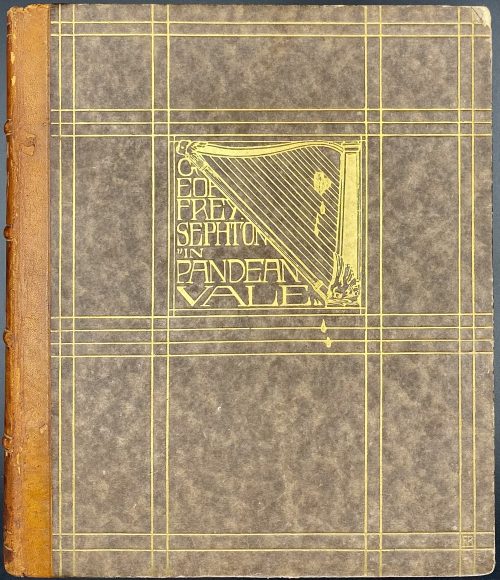 Description: one volume 25.5 x 22 cm, quarter calf with raised bands and gilt lettering over gilt-decorated boards, text within decorated borders printed on wove paper, with 8 mounted colour plates, 16 x 14 cm, photomechanical reproductions after Franz von Bayros, with lettered tissue guards, t.e.g. Title-page (in decorated border): INPANDEANVALE | PICTURED {} IN COLOUR | BY THE MAR {} QUIS F.BAYROS {vignette} | AMALTHEA PUBLISHING OFFICEZURICH || Pagination: [2 blank] [1-6] 7-156 [2 blank], total 80 leaves, incl. 8 colour plates with lettered tissue guards. Limitation: Copyright by Amalthea Publishing Office, Vienna. Printed by Adolf Holzhauzen in Vienna. Bound by Karl Scheibe, Vienna. Edition A: №№ I-V, full leather signed by von Bayros; Edition B: №№ 1-495 in half-leather. This copy is № 130, signed by the author. Contributors: Geoffrey Sephton – author, nothing is known. Franz von Bayros (Austrian, 1866 – 1924) – artist. Adolf Holzhausen the Younger (Austrian, 1868 – 1931) – printer. Karl Scheibe (Austrian) – bookbinder.
Description: one volume 25.5 x 22 cm, quarter calf with raised bands and gilt lettering over gilt-decorated boards, text within decorated borders printed on wove paper, with 8 mounted colour plates, 16 x 14 cm, photomechanical reproductions after Franz von Bayros, with lettered tissue guards, t.e.g. Title-page (in decorated border): INPANDEANVALE | PICTURED {} IN COLOUR | BY THE MAR {} QUIS F.BAYROS {vignette} | AMALTHEA PUBLISHING OFFICEZURICH || Pagination: [2 blank] [1-6] 7-156 [2 blank], total 80 leaves, incl. 8 colour plates with lettered tissue guards. Limitation: Copyright by Amalthea Publishing Office, Vienna. Printed by Adolf Holzhauzen in Vienna. Bound by Karl Scheibe, Vienna. Edition A: №№ I-V, full leather signed by von Bayros; Edition B: №№ 1-495 in half-leather. This copy is № 130, signed by the author. Contributors: Geoffrey Sephton – author, nothing is known. Franz von Bayros (Austrian, 1866 – 1924) – artist. Adolf Holzhausen the Younger (Austrian, 1868 – 1931) – printer. Karl Scheibe (Austrian) – bookbinder. -
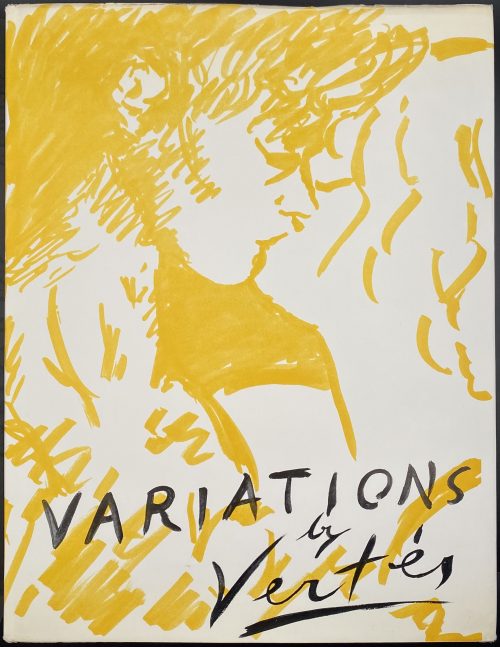 Description: Hardcover volume, 33 x 25.5 cm, bound in grey cloth, vignette and Vertès signature fac-simile to front cover, unclipped ($ 17.50) pictorial dust jacket with black lettering, polyester jacket cover, pp.: [2] [1-4] 5-150 [2], 77 leaves total, 151 ils. Title-page: VARIATIONS | Drawings, water colors, etchings and lithographs | by | VERTÈS | Text by | CLAUDE ROGER-MARX | { publisher’s device} | NEW YORK GRAPHIC SOCIETY | GREENWICH, CONNECTICUT || Limitation: limited edition of 1,000 copies of which 5 copies (A-E) enriched with one original drawing; 100 copies (№ 1-100) enriched with one original signed lithograph; and 895 copies (№ 101-1000). This is copy № 984. Contributors: Marcel Vertès [Marcell Vértes] (Jewish-Hungarian-French, 1895 – 1961) – artist. Claude Roger-Marx (Jewish-French, 1888 – 1977) – author.
Description: Hardcover volume, 33 x 25.5 cm, bound in grey cloth, vignette and Vertès signature fac-simile to front cover, unclipped ($ 17.50) pictorial dust jacket with black lettering, polyester jacket cover, pp.: [2] [1-4] 5-150 [2], 77 leaves total, 151 ils. Title-page: VARIATIONS | Drawings, water colors, etchings and lithographs | by | VERTÈS | Text by | CLAUDE ROGER-MARX | { publisher’s device} | NEW YORK GRAPHIC SOCIETY | GREENWICH, CONNECTICUT || Limitation: limited edition of 1,000 copies of which 5 copies (A-E) enriched with one original drawing; 100 copies (№ 1-100) enriched with one original signed lithograph; and 895 copies (№ 101-1000). This is copy № 984. Contributors: Marcel Vertès [Marcell Vértes] (Jewish-Hungarian-French, 1895 – 1961) – artist. Claude Roger-Marx (Jewish-French, 1888 – 1977) – author. -
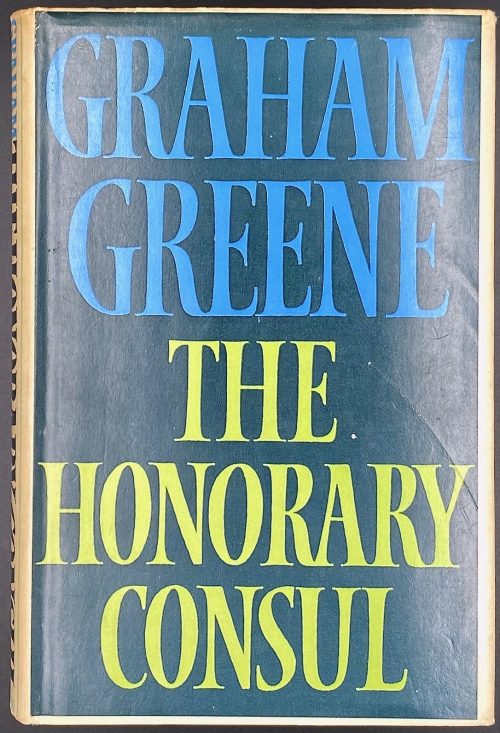 Hardcover, 20.2 x 13.6 cm, green cloth, gilt lettering to spine, in unclipped dust jacket, pp.: [1-8] 9-334 [2]. Title-page: THE HONORARY CONSUL | GRAHAM GREENE | {4 line citation} | {publisher’s device} | THE BODLEY HEAD | LONDON SYDNEY | TORONTO || © Graham Greene 1973. Printed by: William Clowes & Sons Ltd. (Beccles). Graham Greene (British, 1904 – 1991).
Hardcover, 20.2 x 13.6 cm, green cloth, gilt lettering to spine, in unclipped dust jacket, pp.: [1-8] 9-334 [2]. Title-page: THE HONORARY CONSUL | GRAHAM GREENE | {4 line citation} | {publisher’s device} | THE BODLEY HEAD | LONDON SYDNEY | TORONTO || © Graham Greene 1973. Printed by: William Clowes & Sons Ltd. (Beccles). Graham Greene (British, 1904 – 1991). -
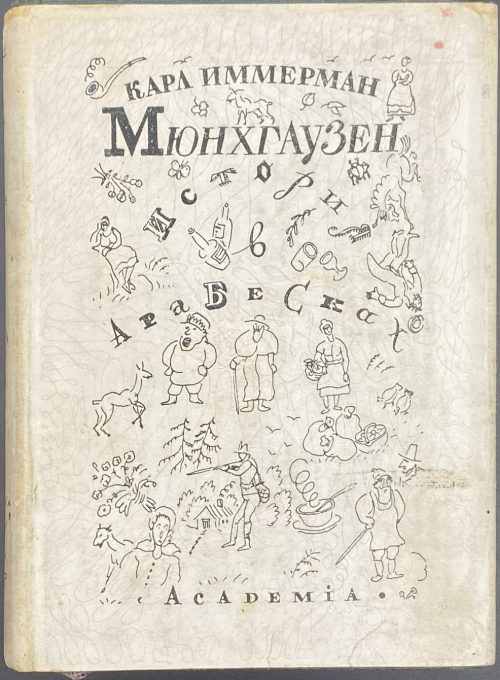
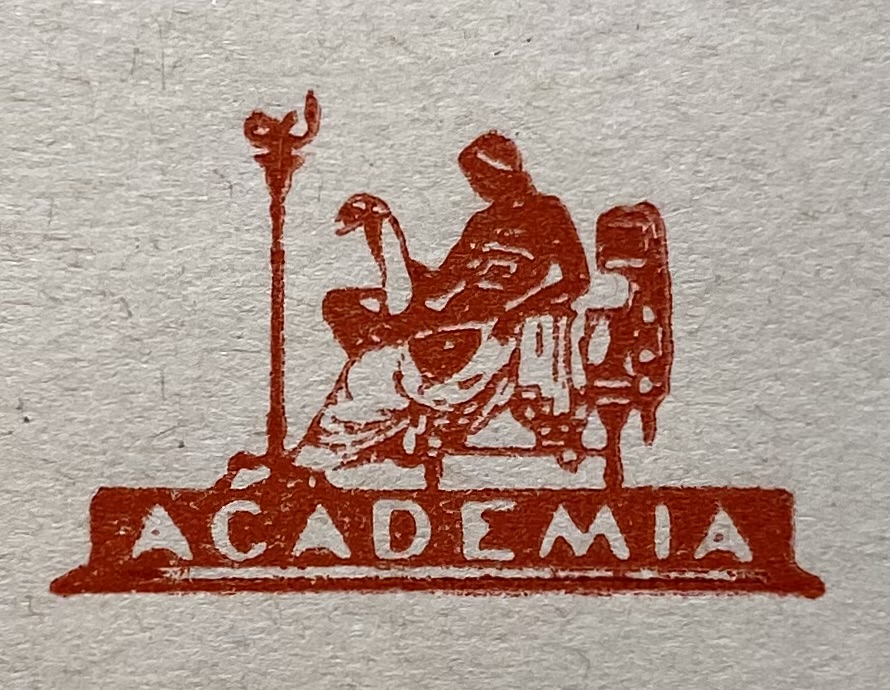 The book Münchhausen: eine Geschichte in Arabesken by Karl Leberecht Immermann was published in Düsseldorf by J. E. Shaub in 1838-1839. Its Russian translation by the Yarkho brothers was published in 1931 and 1932 by Academia publishing in two volumes uniformly bound in full green cloth with embossed and gilt pictorial design to front cover and spine, 17.3 x 12.5 cm, pictorial endpapers, top margin red, and pictorial dust jacket.
Vol. I: 8vo, [1]-398 (312 leaves, 10 plates within collation); pp.: [1-7] 8-624. Print run 5,000 copies.
Title-page (red and black): КАРЛ ИММЕРМАН | Мюнхгаузен | История | в арабесках | перевод и примечания | Г. И. и Б. И. Ярхо | ПРЕДИСЛОВИЕ | П. С. КОГАНА | I | {vignette} | ~ ACADEMIA ~ | МОСКВА ~ ЛЕНИНГРАД | 1931 ||
Frontispiece (red and black): СОКРОВИЩА | МИРОВОЙ ЛИТЕРАТУРЫ | КАРЛ ИММЕРМАН | МЮНХГАУЗЕН | {fleuron} | * | ~ ACADEMIA ~ | МОСКВА ~ ЛЕНИНГРАД | 1931 ||
Reverse title: KARL IMMERMANN | MÜNCHHAUSEN | Eine Geschichte in Arabesken | {…} | ИЛЛЮСТРАЦИИ, ТИТУЛ, | ТИСНЕНИЕ НА ПЕРЕПЛЕТЕ | И СУПЕРОБЛОЖКА ПО РИС. | ХУД. Д. И. МИТРОХИНА | {…} | Ленинградский Областлит № 64832. | Тир. 5.000—39 листов. Зак. 7167. | Государственная типография | “Ленинградская Правда”, | Ленинград. | Соц. 14. ||
Vol. 2: 8vo, [1] 398 ( 312 leaves, 14 plates within collation), pp.: [1-7] 8-622 [2 colophon/blank]. Print run 5,250 copies.
Title-page (red and black): КАРЛ ИММЕРМАН | Мюнхгаузен | История | в арабесках | перевод и примечания | Б. И. и Г. И. Ярхо | II | {vignette} | ~ ACADEMIA ~ | МОСКВА ~ ЛЕНИНГРАД | 1932 ||
Frontispiece: СОКРОВИЩА | МИРОВОЙ ЛИТЕРАТУРЫ | КАРЛ ИММЕРМАН | МЮНХГАУЗЕН | {fleuron} | * | ~ ACADEMIA ~ | МОСКВА ~ ЛЕНИНГРАД | 1932 ||
Reverse title: KARL IMMERMANN | MUNCHHAUSEN | Eine Geschichte in Arabesken | {…} | Иллюстрации, титул, тиснение | на переплете | и суперобложка | по рис. худ. Д. И. Митрохина.
Illustrations: Plates, title pages, faux-titles, head- and endpieces, design of covers and dust jackets after Dmitry Mitrokhin (Д. И. Митрохин).
Catalogue raisonné: Крылов-Кичатова v.1: 451/2, v.2: 491. [LIB-2260.2019].
Contributors:
Karl Leberecht Immermann (German, 1796 – 1840) – author.
Григорий Исаакович Ярхо (Russian-Jewish, 1886 – 1954) – translator.
Борис Исаакович Ярхо (Russian-Jewish,1889 – 1942) – translator.
Пётр Семёнович Коган (Russian-Jewish, 1872 – 1932) – author/preface.
Dmitry Mitrokhin [Дмитрий Исидорович Митрохин] (Russian, 1883 – 1973) – artist.
The book Münchhausen: eine Geschichte in Arabesken by Karl Leberecht Immermann was published in Düsseldorf by J. E. Shaub in 1838-1839. Its Russian translation by the Yarkho brothers was published in 1931 and 1932 by Academia publishing in two volumes uniformly bound in full green cloth with embossed and gilt pictorial design to front cover and spine, 17.3 x 12.5 cm, pictorial endpapers, top margin red, and pictorial dust jacket.
Vol. I: 8vo, [1]-398 (312 leaves, 10 plates within collation); pp.: [1-7] 8-624. Print run 5,000 copies.
Title-page (red and black): КАРЛ ИММЕРМАН | Мюнхгаузен | История | в арабесках | перевод и примечания | Г. И. и Б. И. Ярхо | ПРЕДИСЛОВИЕ | П. С. КОГАНА | I | {vignette} | ~ ACADEMIA ~ | МОСКВА ~ ЛЕНИНГРАД | 1931 ||
Frontispiece (red and black): СОКРОВИЩА | МИРОВОЙ ЛИТЕРАТУРЫ | КАРЛ ИММЕРМАН | МЮНХГАУЗЕН | {fleuron} | * | ~ ACADEMIA ~ | МОСКВА ~ ЛЕНИНГРАД | 1931 ||
Reverse title: KARL IMMERMANN | MÜNCHHAUSEN | Eine Geschichte in Arabesken | {…} | ИЛЛЮСТРАЦИИ, ТИТУЛ, | ТИСНЕНИЕ НА ПЕРЕПЛЕТЕ | И СУПЕРОБЛОЖКА ПО РИС. | ХУД. Д. И. МИТРОХИНА | {…} | Ленинградский Областлит № 64832. | Тир. 5.000—39 листов. Зак. 7167. | Государственная типография | “Ленинградская Правда”, | Ленинград. | Соц. 14. ||
Vol. 2: 8vo, [1] 398 ( 312 leaves, 14 plates within collation), pp.: [1-7] 8-622 [2 colophon/blank]. Print run 5,250 copies.
Title-page (red and black): КАРЛ ИММЕРМАН | Мюнхгаузен | История | в арабесках | перевод и примечания | Б. И. и Г. И. Ярхо | II | {vignette} | ~ ACADEMIA ~ | МОСКВА ~ ЛЕНИНГРАД | 1932 ||
Frontispiece: СОКРОВИЩА | МИРОВОЙ ЛИТЕРАТУРЫ | КАРЛ ИММЕРМАН | МЮНХГАУЗЕН | {fleuron} | * | ~ ACADEMIA ~ | МОСКВА ~ ЛЕНИНГРАД | 1932 ||
Reverse title: KARL IMMERMANN | MUNCHHAUSEN | Eine Geschichte in Arabesken | {…} | Иллюстрации, титул, тиснение | на переплете | и суперобложка | по рис. худ. Д. И. Митрохина.
Illustrations: Plates, title pages, faux-titles, head- and endpieces, design of covers and dust jackets after Dmitry Mitrokhin (Д. И. Митрохин).
Catalogue raisonné: Крылов-Кичатова v.1: 451/2, v.2: 491. [LIB-2260.2019].
Contributors:
Karl Leberecht Immermann (German, 1796 – 1840) – author.
Григорий Исаакович Ярхо (Russian-Jewish, 1886 – 1954) – translator.
Борис Исаакович Ярхо (Russian-Jewish,1889 – 1942) – translator.
Пётр Семёнович Коган (Russian-Jewish, 1872 – 1932) – author/preface.
Dmitry Mitrokhin [Дмитрий Исидорович Митрохин] (Russian, 1883 – 1973) – artist.
-
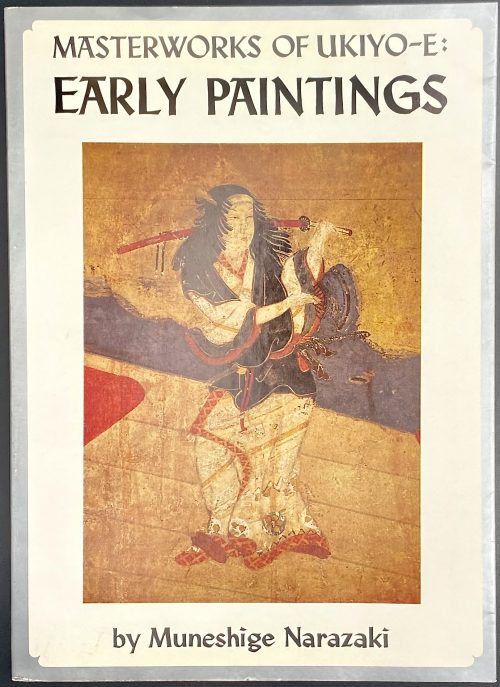 Paperback volume, 25.7 x 18.6 cm, brown embossed wrappers with framed Japanese characters along the outer margin, pictorial dust jacket with series design (black lettering and vignette in silver border to wrappers, black lettering on silver to spine); pp: [1-6]: h.t./frontis. (colour plate pasted in), t.p./imprint, contents/blank), 7-32 text, 33-96 (59 plates w/captions). Title-page (in frame): MASTERWORKS OF UKIYO-E | EARLY PAINTINGS | by Muneshige Narazaki | English adaptation by Charles A. Pomeroy | {publisher’s device} | KODANSHA INTERNATIONAL LTD. | Tokyo, Japan & Palo-Alto, Calif., U.S.A | {vertical between rules 初期 浮世絵} || Series: Masterworks of ukiyo-e, № 1. Contributors: Muneshige Narazaki [楢崎 宗重] (Japanese, 1904 – 2001) – author. Charles A. Pomeroy (American, b. 1930) – adaptation.
Paperback volume, 25.7 x 18.6 cm, brown embossed wrappers with framed Japanese characters along the outer margin, pictorial dust jacket with series design (black lettering and vignette in silver border to wrappers, black lettering on silver to spine); pp: [1-6]: h.t./frontis. (colour plate pasted in), t.p./imprint, contents/blank), 7-32 text, 33-96 (59 plates w/captions). Title-page (in frame): MASTERWORKS OF UKIYO-E | EARLY PAINTINGS | by Muneshige Narazaki | English adaptation by Charles A. Pomeroy | {publisher’s device} | KODANSHA INTERNATIONAL LTD. | Tokyo, Japan & Palo-Alto, Calif., U.S.A | {vertical between rules 初期 浮世絵} || Series: Masterworks of ukiyo-e, № 1. Contributors: Muneshige Narazaki [楢崎 宗重] (Japanese, 1904 – 2001) – author. Charles A. Pomeroy (American, b. 1930) – adaptation. -
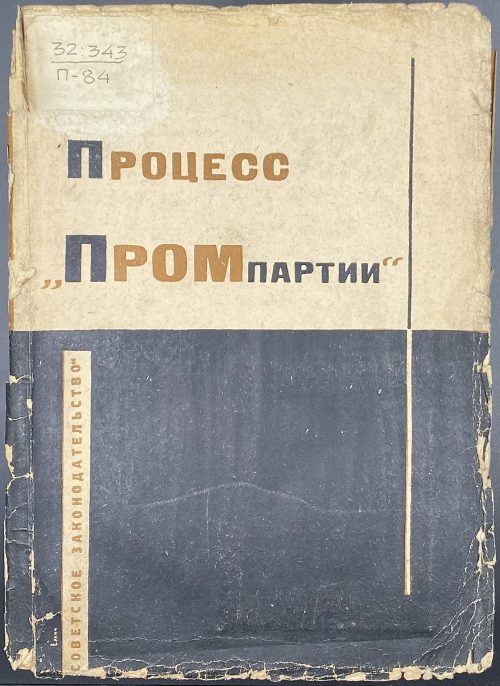 Softcover, 24 x 18 cm, black and white original wrappers, lettering; pp. [1-6] 7-541 [3]; purple ink library stamps and numbers. Title-page: ПРОЦЕСС “ПРОМПАРТИИ” | (25 ноября – 7 декабря 1930 г.) | СТЕНОГРАММА | СУДЕБНОГО ПРОЦЕССА | И МАТЕРИАЛЫ, | ПРИОБЩЕННЫЕ К ДЕЛУ | 1931 | ОГИЗ — “СОВЕТСКОЕ ЗАКОНОДАТЕЛЬСТВО” — МОСКВА || Процесс Промпартии [Industrial Party Trial] Андрей Януарьевич Вышинский [Andrey Vyshinsky] (Russian, 1883 – 1954) – chairman. Николай Васильевич Крыленко [Nikolai Krylenko] (Russian, 1885 – 1938) – public prosecutor.
Softcover, 24 x 18 cm, black and white original wrappers, lettering; pp. [1-6] 7-541 [3]; purple ink library stamps and numbers. Title-page: ПРОЦЕСС “ПРОМПАРТИИ” | (25 ноября – 7 декабря 1930 г.) | СТЕНОГРАММА | СУДЕБНОГО ПРОЦЕССА | И МАТЕРИАЛЫ, | ПРИОБЩЕННЫЕ К ДЕЛУ | 1931 | ОГИЗ — “СОВЕТСКОЕ ЗАКОНОДАТЕЛЬСТВО” — МОСКВА || Процесс Промпартии [Industrial Party Trial] Андрей Януарьевич Вышинский [Andrey Vyshinsky] (Russian, 1883 – 1954) – chairman. Николай Васильевич Крыленко [Nikolai Krylenko] (Russian, 1885 – 1938) – public prosecutor. -
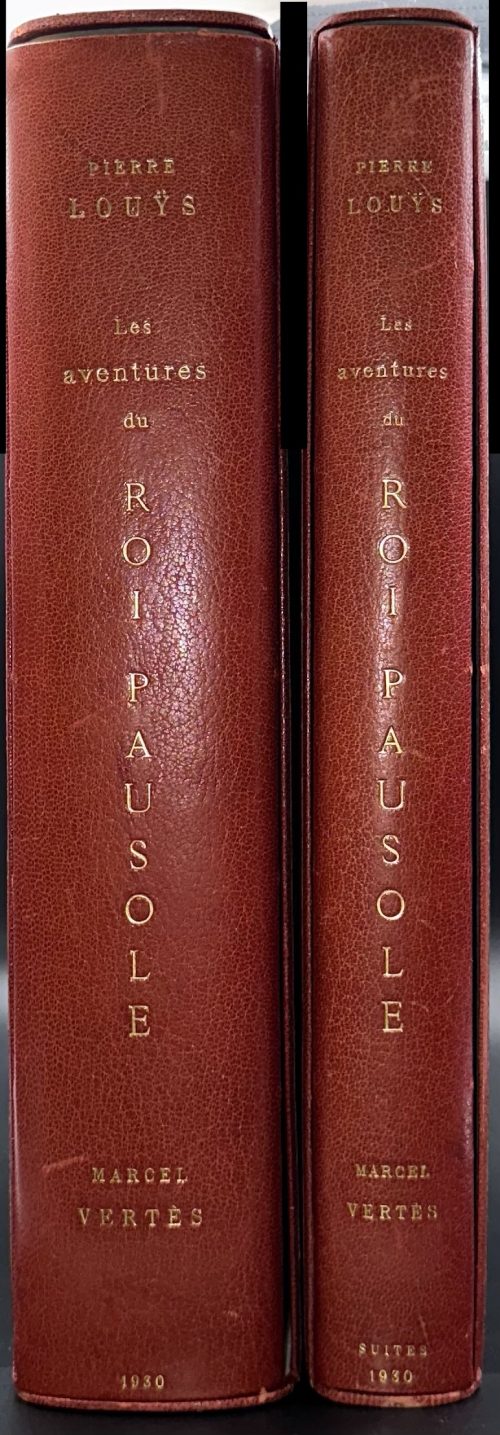 Two volumes in owner’s uniform so called Jansenist binding by someone Alix (signed in gilt inside), gilt lettering to spine, each in a slipcase. Vol. 1: full crimson morocco 32.5 x 26 x 6.5 cm in a 33.3 x 27 x 7 cm slipcase, cloth endpapers, all edges gilt, publisher’s wrappers preserved, autographed drawing by Vertès to h.t. “à monsieur Willard | bien sympathiquement | Vertès | Paris 1930”. Collation: 3 blanks, front wrapper, 2 blanks, [10] h.t./limit., t.p., art., dedic., person., [2] 3-487 [488 blank], [2] coloph., 3 blanks, spine, 3 blanks; 74 dry-point illustrations by Marcel Vertès within collation; printed on thick wove paper by ‘Arches’ watermarked “Pausole & Vertès”. Title-page (red and black): LES AVENTURES | DU | ROI PAUSOLE | de | PIERRE LOUŸS | {vignette} | AUX DÉPENS D'UN AMATEUR | PARIS, MCMXXX || Limitation: CETTE ÉDITION DU ROMAN | DE |PIERRE LOUŸS | LES AVENTURES DU ROI PAUSOLE | A ÉTE COMPOSE EN CARACTÈRE GARAMOND DU CORPS 18 | ET IMPRIMEE SUR VÉLIN A LA FORME DES PAPETERIES | D' ARCHES FILIGRANÉ | PAUSOLE & VERTÈS | ELLE EST ILLUSTRÉE DE SOIXANTE-QUATORZE | POINTES-SÈCHES ORIGINALES | DE | VERTÈS | SON TIRAGE A ÉTÉ STRICTEMENT LIMITÉ A | QUATRE-VINGT-DIX-NEUF EXEMPLAIRES NUMÉROTÉS | DE 1 A 99 ET CONTENANT : | 1° LA SUITE DES CUIVRES AVEC REMAROUES. | 2° UNE SUITE DES 15 PLANCHES REFUSÉES. | IL A ÉTÉ TIRÉ EN OUTRE, POUR L' ARTISTE ET LES COLLABORATEURS, | QUELQUES EXEMPLAIRES NOMINATIFS, DONT DEUX IMPRIMÉS SUR PAPIER | CHIFFE D'AUVERGNE A LA MAIN | EXEMPLAIRE | № 9 || Colophon: Cet ouvrage, établi aux dépens de m. L. Givaudan, a été achevé d'imprimer le quinze novembre mil neuf cent trente, pour le texte, sur les presses de R. Coulouma, maitre imprimeur a Argenteuil, H. Barthélemy, directeur, et pour les pointes-sèches, dans les ateliers de «La Tradition", a Paris. Limited edition of 99 copies, this is copy № 9. Vol. 2: Three-quarters crimson morocco over cloth outlined gilt, 32.7 x 27.8 x 4 cm in a 33.3 x 28.2 x 4.3 cm slipcase, cloth endpapers, all edges gilt, printed on thick wove paper by ‘Arches’ watermarked “Pausole & Vertès”. Collation: 3 blanks, 74 unpaginated leaves of plates (main suite avec remarque), blank, 15 leaves of plates (refusées), t.p./limit., blank, 30 leaves of plates (15 prints in two states each, with and without ‘remarks’) titled Au pays du Roi Pausole, 3 blanks. Title-page (red and black): AU PAYS | DU | ROI PAUSOLE | Quinze cuivres | gravés par un artiste | inconnu | de la suite | du Roi | ❦ | —| TRYPHÈME. MCMXXX. || Limitation: IL A ÉTÉ TIRÉDE CETTE SUITE | DE POINTES-SÈCHES VINGT- | CINQ EXEMPLAIRES SUR VÉ- | LIN A LA FORME DES PAPETE- | RIES ARCHES AU FILIGRANE | DE PAUSOLE. CES SUITES NON | MISES DANS LE COMMERCE | SONT RÉSERVÉES A SA MAJES- | TÉ, AUX REINES PRÉFÉRÉES | PARMI LL. AA. RR. ET A QUEL- | QUES FIDÈLES SERVITEURS. | № 13 || Limited edition of 25 copies, this is copy № 13; Enriched with an original copper plate with one of the illustrations. Marcel Willard (French, – provenance. Catalogue raisonné: Dutel (III) 1057; Nordmann (II) № 307; Vokaer 26. Ref.: honesterotica.com Contributors: Pierre Louÿs (French, 1870 – 1925) – author. Marcel Vertès [Marcell Vértes] (Jewish-Hungarian-French, 1895 – 1961) – artist. Léon Givaudan (French, 1875 – 1936) – publisher. Seller's description:Les Aventures du Roi Pausole. Paris, Aux dépens d'un amateur, 1930. 2 volumes in-4, maroquin rouge janséniste, tranches dorée, couverture et dos, emboîtage. Le volume de suites est relié en demi-maroquin rouge. (Alix). Ouvrage illustré de 74 pointes-sèches de Marcel Vertès. Tirage à 99 exemplaires sur vélin d'Arches, comportant la suite des cuivres avec remarque, ainsi qu'une suite des 15 planches refusées. Exemplaire enrichi d'une plaque de cuivre ayant servi à une des illustrations, d'un dessin avec envoi autographe signé de l'artiste sur la page de faux-titre et d'une double suite des 15 pointes-sèches par un artiste inconnu intitulée Au Pays du roi Pausole. Dos légèrement passés.
Two volumes in owner’s uniform so called Jansenist binding by someone Alix (signed in gilt inside), gilt lettering to spine, each in a slipcase. Vol. 1: full crimson morocco 32.5 x 26 x 6.5 cm in a 33.3 x 27 x 7 cm slipcase, cloth endpapers, all edges gilt, publisher’s wrappers preserved, autographed drawing by Vertès to h.t. “à monsieur Willard | bien sympathiquement | Vertès | Paris 1930”. Collation: 3 blanks, front wrapper, 2 blanks, [10] h.t./limit., t.p., art., dedic., person., [2] 3-487 [488 blank], [2] coloph., 3 blanks, spine, 3 blanks; 74 dry-point illustrations by Marcel Vertès within collation; printed on thick wove paper by ‘Arches’ watermarked “Pausole & Vertès”. Title-page (red and black): LES AVENTURES | DU | ROI PAUSOLE | de | PIERRE LOUŸS | {vignette} | AUX DÉPENS D'UN AMATEUR | PARIS, MCMXXX || Limitation: CETTE ÉDITION DU ROMAN | DE |PIERRE LOUŸS | LES AVENTURES DU ROI PAUSOLE | A ÉTE COMPOSE EN CARACTÈRE GARAMOND DU CORPS 18 | ET IMPRIMEE SUR VÉLIN A LA FORME DES PAPETERIES | D' ARCHES FILIGRANÉ | PAUSOLE & VERTÈS | ELLE EST ILLUSTRÉE DE SOIXANTE-QUATORZE | POINTES-SÈCHES ORIGINALES | DE | VERTÈS | SON TIRAGE A ÉTÉ STRICTEMENT LIMITÉ A | QUATRE-VINGT-DIX-NEUF EXEMPLAIRES NUMÉROTÉS | DE 1 A 99 ET CONTENANT : | 1° LA SUITE DES CUIVRES AVEC REMAROUES. | 2° UNE SUITE DES 15 PLANCHES REFUSÉES. | IL A ÉTÉ TIRÉ EN OUTRE, POUR L' ARTISTE ET LES COLLABORATEURS, | QUELQUES EXEMPLAIRES NOMINATIFS, DONT DEUX IMPRIMÉS SUR PAPIER | CHIFFE D'AUVERGNE A LA MAIN | EXEMPLAIRE | № 9 || Colophon: Cet ouvrage, établi aux dépens de m. L. Givaudan, a été achevé d'imprimer le quinze novembre mil neuf cent trente, pour le texte, sur les presses de R. Coulouma, maitre imprimeur a Argenteuil, H. Barthélemy, directeur, et pour les pointes-sèches, dans les ateliers de «La Tradition", a Paris. Limited edition of 99 copies, this is copy № 9. Vol. 2: Three-quarters crimson morocco over cloth outlined gilt, 32.7 x 27.8 x 4 cm in a 33.3 x 28.2 x 4.3 cm slipcase, cloth endpapers, all edges gilt, printed on thick wove paper by ‘Arches’ watermarked “Pausole & Vertès”. Collation: 3 blanks, 74 unpaginated leaves of plates (main suite avec remarque), blank, 15 leaves of plates (refusées), t.p./limit., blank, 30 leaves of plates (15 prints in two states each, with and without ‘remarks’) titled Au pays du Roi Pausole, 3 blanks. Title-page (red and black): AU PAYS | DU | ROI PAUSOLE | Quinze cuivres | gravés par un artiste | inconnu | de la suite | du Roi | ❦ | —| TRYPHÈME. MCMXXX. || Limitation: IL A ÉTÉ TIRÉDE CETTE SUITE | DE POINTES-SÈCHES VINGT- | CINQ EXEMPLAIRES SUR VÉ- | LIN A LA FORME DES PAPETE- | RIES ARCHES AU FILIGRANE | DE PAUSOLE. CES SUITES NON | MISES DANS LE COMMERCE | SONT RÉSERVÉES A SA MAJES- | TÉ, AUX REINES PRÉFÉRÉES | PARMI LL. AA. RR. ET A QUEL- | QUES FIDÈLES SERVITEURS. | № 13 || Limited edition of 25 copies, this is copy № 13; Enriched with an original copper plate with one of the illustrations. Marcel Willard (French, – provenance. Catalogue raisonné: Dutel (III) 1057; Nordmann (II) № 307; Vokaer 26. Ref.: honesterotica.com Contributors: Pierre Louÿs (French, 1870 – 1925) – author. Marcel Vertès [Marcell Vértes] (Jewish-Hungarian-French, 1895 – 1961) – artist. Léon Givaudan (French, 1875 – 1936) – publisher. Seller's description:Les Aventures du Roi Pausole. Paris, Aux dépens d'un amateur, 1930. 2 volumes in-4, maroquin rouge janséniste, tranches dorée, couverture et dos, emboîtage. Le volume de suites est relié en demi-maroquin rouge. (Alix). Ouvrage illustré de 74 pointes-sèches de Marcel Vertès. Tirage à 99 exemplaires sur vélin d'Arches, comportant la suite des cuivres avec remarque, ainsi qu'une suite des 15 planches refusées. Exemplaire enrichi d'une plaque de cuivre ayant servi à une des illustrations, d'un dessin avec envoi autographe signé de l'artiste sur la page de faux-titre et d'une double suite des 15 pointes-sèches par un artiste inconnu intitulée Au Pays du roi Pausole. Dos légèrement passés. -
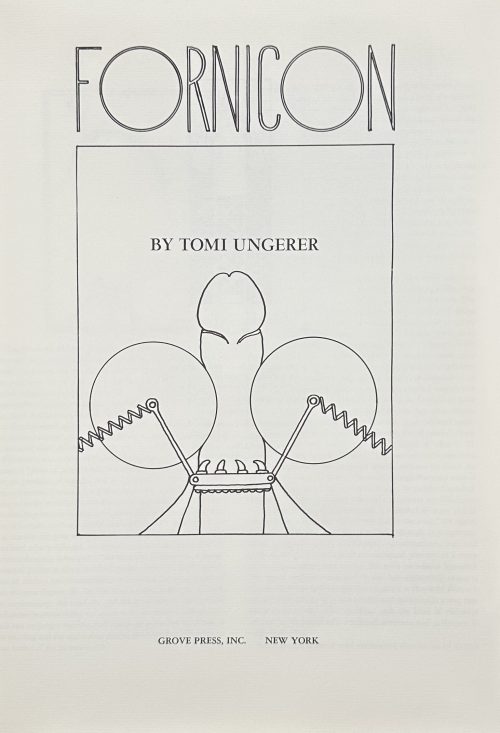 Hardcover, 333 x 247 mm, black cloth with gilt facsimile to front board and gilt lettering to spine, aubergine dust jacket with white lettering and red facsimile over black panel to front and back, crimson endpapers, laid paper, unpaginated; pp.: [4] h.t./blank, t.p./imprint, [2] text by John Hollander, 61 leaves of plates; originally published in 1969 by Rhinoceros Press, New York, as a limited-edition portfolio with slipcase. Title-page: Fornicon | (in frame) BY TOMI UNGERER | GROVE PRESS NEW YORK || Jean-Thomas [Tomi] Ungerer (French,1931 – 2019) John Hollander (American, 1929 – 2013)
Hardcover, 333 x 247 mm, black cloth with gilt facsimile to front board and gilt lettering to spine, aubergine dust jacket with white lettering and red facsimile over black panel to front and back, crimson endpapers, laid paper, unpaginated; pp.: [4] h.t./blank, t.p./imprint, [2] text by John Hollander, 61 leaves of plates; originally published in 1969 by Rhinoceros Press, New York, as a limited-edition portfolio with slipcase. Title-page: Fornicon | (in frame) BY TOMI UNGERER | GROVE PRESS NEW YORK || Jean-Thomas [Tomi] Ungerer (French,1931 – 2019) John Hollander (American, 1929 – 2013) -
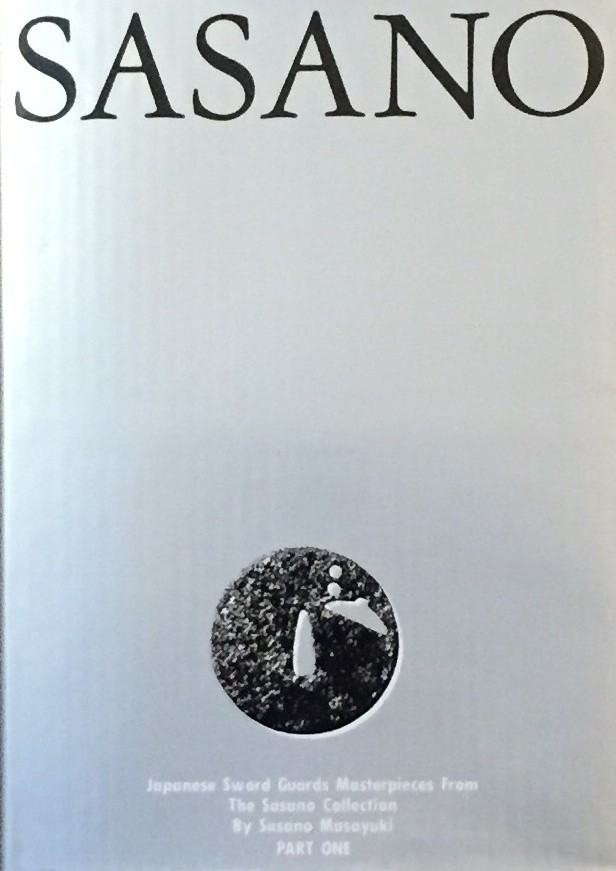
Sasano: Japanese Sword Guard Masterpieces from the Sasano Collection. By Sasano Masayuki. Part One. Published in Japan in 1994 by Daisuke Saito, Mega Co., Ltd. Translated by Tomoko Saro. Printed by Mitsumura Printing Co., Ltd. 304 x 217 x 30 mm
-
 Magazine article by Edgar Jepson: The Iron Tsuba of Japan (Section: Oriental Art), published in volume Vol. 70 (September–December) of The Connoisseur: An Illustrated Magazine for Collectors, Vol. 70 (September–December); pp. 143-152 / C. Reginald Grundy [ed.] — London: Published by the Proprietor, W. CLAUSE JOHNSON, at the Editorial and Advertisement Offices of The Connoisseur, 1924. Owner's half black morocco, gilt lettering to spine, blue cloth boards. Two volumes bound together without original covers. Size 28.5 x 22 cm. Vol. 1: The Connoisseur | An Illustrated Magazine | For Collectors | Edited by C. Reginald Grundy | Vol. LXIX. | (MAY—AUGUST, 1924) | LONDON | Published by the Proprietor, W. CLAUSE JOHNSON, at the | Editorial and Advertisement Offices of The Connoisseur, | at 1, Duke Street, St. James's, S.W. 1 | 1924 || Pp.: [i-ii] iii-xviii [xix] [1, 2 - plate] 3-249 [250]. Vol. 2: The Connoisseur | An Illustrated Magazine | For Collectors | Edited by C. Reginald Grundy | Vol. LXX. | (SEPTEMBER—DECEMBER, 1924) | LONDON | Published by the Proprietor, W. CLAUSE JOHNSON, at the | Editorial and Advertisement Offices of The Connoisseur, | at 1, Duke Street, St. James's, S.W. 1 | 1924 || Pp.: [i-ii] iii-xxii [2 blanks] [1, 2 - plate] 3-261 [262]. The Iron Tsuba of Japan by Edgar Jepson The heart of Japan was in the sword. However admirable may be the paintings, the prints, the netsuke, the lacquer, or the bronzes of the Japanese masters, the supreme artistic achievements of Japan were the blades of Masamune, Muramasa, Sadamune, and Rai Kunitsugu. But not a little of the heart of Japan went also in the tsuba, the guard which protected the hand that wielded the blade, into the iron tsuba of the fighting Samurai. Beside the forgers of the iron tsuba of Japan the ironsmiths of the rest of the world have been mere children. The earliest tsuba were of bronze or copper, often gilded. It is probable that they were replaced by iron tsuba during the Kamakura period, the great fighting era, which lasted from A.D. 1185 to 1333. During the later half of the twelfth century leather tsuba, strengthened by thin iron plates or a metal rim, also replaced the bronze and copper tsuba. It was at this time that a family of armourers of the name of Masuda, and in particular Masuda Munesuke, the founder of the Myochin family, began to forge iron tsuba — thin, round plates of great hardness and density. But it is probable that no tsuba perforated with a view to decorative effects were forged before the end of the fourteenth century. These fourteenth-century tsuba are exceedingly rare in England. I have seen none in the museums, none in the famous collections that have been sold during the last ten years. Those photographed in Herr Oeder's book might easily be the fifteenth century. No. 1 is a curious cup-shape tsuba decorated with a bronze and copper inlay. No. 2, with its edges curiously twisted in the forging, looks like Myochin work. But it is not of the Myochin iron. The Myochin family produced some of the greatest ironsmiths of Japan. Armourers first of all, tsubasmiths, forgers of sake-kettles, articulated reptiles, crustacea, and insects — everything that can be done with iron they did; they pushed their medium to its limit. They were forging iron tsuba in 1160, and they were still forging them in 1860. And it was their own iron, or rather their own steel. They discovered the secret of it early, and they kept that secret in the family for all those hundreds of years. There is no mistaking a Myochin tsuba: balance it on your finger and tap it with a piece of metal, always it gives forth a clear bell-like ring that you get from the work of no other ironsmith, Japanese or European. Always the Myochin tsuba is before everything a protection to the hand of the swordsman; to that everything is, as it should be, subordinated. No. 3 is a Myochin tsuba of the fifteenth century, and probably of the early fifteenth century. No. 4, by Myochin Munetaka, perforated with a grotesque figure, is an example of that twisting and twisting of the iron in the forging till it forms a pattern like the grain of wood. The Myochin smiths invented these wood-grain tsuba, and no other smiths equalled them in their forging. In the sixteenth century, the fighting tsuba was probably at its best. It was a century of great tsubasmiths. Then the first Nobuiye, whose tsuba fetched £100 apiece, circa 1800, in Japan, and the first Kaneiye flourished. No. 5 is a tsuba forged by a great smith, Iyesada of Sotome, in the manner of Nobuiye I, decorated with the karakusa tendrils that Nobuiye delighted in, with lightning and clouds. No. 6 is a guard of Sanada Tembo, the chief smith of the Tembo family, stamped, punning fashion, with the character Tembo. Akin to the Tembo tsuba were those of the Kiami and Hoan smiths. Then also the Heianjo smiths and the Owari smiths, especially those of Nagoya and the Yamakichi family, forged their strongest tsuba. Those of the Yamakichi were tested after the forging by being pounded in iron mortars — at least, so the legend runs. But they were a sternly utilitarian family, and I have never seen a Yamakichi tsuba of any beauty. In the later half of the fifteenth century arose the fashion of decorating tsuba with an inlay, zogan, of bronze. The Heianjo tsuba, forged at Kyoto in the latter half of the fifteenth and the beginning of the sixteenth century, were often thus inlaid. The earliest of them were called "Onin", of which No. 7 is an example. In addition to the bronze inlay around the edge, it is inlaid with a representation, some say, of snow; others say, of the duckweed on a pond. No. 8 is probably a Heianjo tsuba, but I am not quite sure about it. The inlaid acacia branches might be very early Shoami work. But to judge by the iron, it is a fifteenth-century tsuba; and the authorities place the beginning of the Shoami school not later than early in the sixteenth century. No. 10 is an example of the Fushimi-zogan, a flat inlay of a light-coloured bronze. These tsuba took their name from the fact that they were first forged at Fushimi, in Yamashiro, in the sixteenth century. It is of the type known as Mon-zukashi, perforated with crests (mon) à jour. The Yoshiro-zogan tsuba were also first forged at Fushimi by Yoshiro Naomasa. They were distinguished from the Fushimi-zogan by the fact that their inlay was generally a little raised-not always-for the inlay of No. 9, a tsuba forged by a later nineteenth-century Yoshiro, is quite flat. It is an interesting tsuba, for, with its decoration grown florid and excessive, it marks the intermediate stage between the simple and delightful designs of the genuine fighting tsuba and the elaborate pictures in gold and silver on the tsuba of the eighteenth-century smiths of Awa and Kyoto, which have become mere ornaments of the goldsmith. The Gomoku-zogan (No. 11) tsuba were probably first forged earlier than the Fushimi and Yoshiro-zogan tsuba. This inlay, in slight relief, is a representation in a light-coloured bronze and copper of twigs caught in the eddies of streams. The seventeenth century and early eighteenth century were the great periods of perforated tsuba. The designs, and they are often admirable, are for the most part in plain fretwork; but they are also chased. No. 12, a crane under an acacia, is a tsuba of a Higo smith, great forgers of fighting tsuba during this period. These smiths also excelled in nunome zogan, a very thin gold and silver inlay, with which they further decorated their perforated guards. The smiths of the Umetada and Shoami families also forged iron tsuba during this period; but their designs, though sometimes pleasing enough, are rarely fine. The best work of Myoju Umetada is in sentoku, not iron. The Choshu smiths, coming later, surpass the perforated guards of both the Umetada and Shoami smiths in beauty of design. No. 13, a lotus in the round, not only fretwork, but also engraved, is a good example of the admirable balance they so often attained in their designs. It is a sufficiently realistic lotus, but yet of a delightful simplicity. In considerable contrast is No. 14, the dragon by Soheishi Soten — one of the only two authentic tsuba of his forging known — the first forger of hikone-bori tsuba, which were in extraordinary favour in Japan during the eighteenth century, and illustrated every important event in Japanese history. It is on the elaborate side, but fine, strong work, and an excellent guard to the hand, for the lighter and more open part, which gives the design its admirable balance, is on the inside, and not exposed to the full swing of an opponent's blade. A few years ago there was a tendency to decry the Namban tsuba as having sprung too directly from foreign sources. But though the original suggestion may have been Chinese, or, as some say, Portuguese, the Japanese made it entirely their own, as characteristically Japanese as anything can well be, but, it must be admitted, of a decadent period. The school took its rise at the beginning of the seventeenth century, and the early tsuba were forged of a specially hard iron, the Wootz, imported from Southern India. No. 15, the signs of the Zodiac, is an excellent tsuba from the fighting point of view. Both it and No. 16 are of quite charming, if elaborate, design, and both of them, with their delicate scroll-work, so astonishingly undercut, are the very last word in the work of the ironsmith-veritable iron lace. To return to the simpler perforated tsuba, the smiths of Akasaka, a suburb of Tokyo, produced probably the most charming designs. Their style derives considerably from the Higo smiths, and their earlier fighting tsuba are very like the Higo tsuba. But always their work was just a little lighter than that of the Higo smiths, and in the end they moved right away from them and became the forgers of very light guards indeed. No. 17, is a representation of the Hiyokudori, the fabulous double bird, in which were reincarnated the souls of the two lovers, Gompachi and Komurasaki; and No. 18, “the tsuba of a hundred ducks "— there are about forty — are characteristic designs of the school. In the work of the Akasaka smiths the balance, which makes the design of a good tsuba so admirable and delightful, attains its height. This admirable balance seems often to be obtained by a deliberate sacrifice of symmetry. About nine hundred and ninety-nine European ironsmiths out of a thousand would have made the right and left sides of the Hiyoku-dori line by line, and perforation by perforation, exactly alike; he would have cut out exactly as many ducks on the one side of “the tsuba of a hundred ducks” as on the other, and made each duck on the right side correspond exactly in position and attitude with a duck on the left side. By variations the tsubasmith attained a finer balance, almost a higher symmetry. No. 19, often called by collectors the "rose-window" tsuba, but really a stylised chrysanthemum, is a favourite design of the Akasaka smiths, but Hizen work and inlaid in the Hizen manner with gold nunome. No. 20 is a Satsuma tsuba of the middle period. The Satsuma smiths of the nineteenth century produced probably the most ornate of all the iron guards, for the most part calibashes and beans with their leaves and tendrils realistic in the extreme, but of charming design. Few crafts have been carried further than that of the tsubasmith; few crafts working in a difficult medium have handled more subjects with greater feeling for beauty or greater liveliness of fancy. It is interesting to note again and again how school influences school, and smith influences smith. But, as in all the applied arts, the finest tsuba were forged by men who never lost sight of the purpose of a tsuba, that it is before everything a protection to the hand, and never subjected that purpose to a passion for virtuosity. Illustrations: No 1. FOURTEENTH-CENTURY TSUBA, WITH BRONZE AND COPPER INLAY No. 2. FOURTEENTH-CENTURY TSUBA, RESEMBLING MYOCHIN WORK No. 3. MYOCHIN TSUBA, FIFTEENTH CENTURY No. 4. MYOCHIN TSUBA, NINETEENTH CENTURY No. 5. SIXTEENTH-CENTURY TSUBA No. 6. SIXTEENTH-CENTURY TSUBA BY IYESADA OF SOTOME BY SANADA TEMBO No. 7. ONIN TSUBA No. 8. HEIANJO (?) TSUBA No. 9. YOSHIRO TSUBA, NINETEENTH CENTURY No. 10. FUSHIMI-ZOGAN, NINETEENTH CENTURY No. 11.- GOMOKU-ZOGAN, SIXTEENTH CENTURY No. 12. HIGO TSUBA, SEVENTEENTH CENTURY No. 13. CHOSHU TSUBA, SEVENTEENTH CENTURY No. 14. SOTEN TSUBA, SEVENTEENTH CENTURY No. 15. NAMBAN TSUBA, EIGHTEENTH CENTURY No. 16. NAMBAN TSUBA, NINETEENTH CENTURY Nos. 17. AND 18. AKASAKA TSUBA, EIGHTEENTH CENTURY No. 19. HIZEN TSUBA, EIGHTEENTH CENTURY No. 20. SATSUMA TSUBA, EIGHTEENTH CENTURY
Magazine article by Edgar Jepson: The Iron Tsuba of Japan (Section: Oriental Art), published in volume Vol. 70 (September–December) of The Connoisseur: An Illustrated Magazine for Collectors, Vol. 70 (September–December); pp. 143-152 / C. Reginald Grundy [ed.] — London: Published by the Proprietor, W. CLAUSE JOHNSON, at the Editorial and Advertisement Offices of The Connoisseur, 1924. Owner's half black morocco, gilt lettering to spine, blue cloth boards. Two volumes bound together without original covers. Size 28.5 x 22 cm. Vol. 1: The Connoisseur | An Illustrated Magazine | For Collectors | Edited by C. Reginald Grundy | Vol. LXIX. | (MAY—AUGUST, 1924) | LONDON | Published by the Proprietor, W. CLAUSE JOHNSON, at the | Editorial and Advertisement Offices of The Connoisseur, | at 1, Duke Street, St. James's, S.W. 1 | 1924 || Pp.: [i-ii] iii-xviii [xix] [1, 2 - plate] 3-249 [250]. Vol. 2: The Connoisseur | An Illustrated Magazine | For Collectors | Edited by C. Reginald Grundy | Vol. LXX. | (SEPTEMBER—DECEMBER, 1924) | LONDON | Published by the Proprietor, W. CLAUSE JOHNSON, at the | Editorial and Advertisement Offices of The Connoisseur, | at 1, Duke Street, St. James's, S.W. 1 | 1924 || Pp.: [i-ii] iii-xxii [2 blanks] [1, 2 - plate] 3-261 [262]. The Iron Tsuba of Japan by Edgar Jepson The heart of Japan was in the sword. However admirable may be the paintings, the prints, the netsuke, the lacquer, or the bronzes of the Japanese masters, the supreme artistic achievements of Japan were the blades of Masamune, Muramasa, Sadamune, and Rai Kunitsugu. But not a little of the heart of Japan went also in the tsuba, the guard which protected the hand that wielded the blade, into the iron tsuba of the fighting Samurai. Beside the forgers of the iron tsuba of Japan the ironsmiths of the rest of the world have been mere children. The earliest tsuba were of bronze or copper, often gilded. It is probable that they were replaced by iron tsuba during the Kamakura period, the great fighting era, which lasted from A.D. 1185 to 1333. During the later half of the twelfth century leather tsuba, strengthened by thin iron plates or a metal rim, also replaced the bronze and copper tsuba. It was at this time that a family of armourers of the name of Masuda, and in particular Masuda Munesuke, the founder of the Myochin family, began to forge iron tsuba — thin, round plates of great hardness and density. But it is probable that no tsuba perforated with a view to decorative effects were forged before the end of the fourteenth century. These fourteenth-century tsuba are exceedingly rare in England. I have seen none in the museums, none in the famous collections that have been sold during the last ten years. Those photographed in Herr Oeder's book might easily be the fifteenth century. No. 1 is a curious cup-shape tsuba decorated with a bronze and copper inlay. No. 2, with its edges curiously twisted in the forging, looks like Myochin work. But it is not of the Myochin iron. The Myochin family produced some of the greatest ironsmiths of Japan. Armourers first of all, tsubasmiths, forgers of sake-kettles, articulated reptiles, crustacea, and insects — everything that can be done with iron they did; they pushed their medium to its limit. They were forging iron tsuba in 1160, and they were still forging them in 1860. And it was their own iron, or rather their own steel. They discovered the secret of it early, and they kept that secret in the family for all those hundreds of years. There is no mistaking a Myochin tsuba: balance it on your finger and tap it with a piece of metal, always it gives forth a clear bell-like ring that you get from the work of no other ironsmith, Japanese or European. Always the Myochin tsuba is before everything a protection to the hand of the swordsman; to that everything is, as it should be, subordinated. No. 3 is a Myochin tsuba of the fifteenth century, and probably of the early fifteenth century. No. 4, by Myochin Munetaka, perforated with a grotesque figure, is an example of that twisting and twisting of the iron in the forging till it forms a pattern like the grain of wood. The Myochin smiths invented these wood-grain tsuba, and no other smiths equalled them in their forging. In the sixteenth century, the fighting tsuba was probably at its best. It was a century of great tsubasmiths. Then the first Nobuiye, whose tsuba fetched £100 apiece, circa 1800, in Japan, and the first Kaneiye flourished. No. 5 is a tsuba forged by a great smith, Iyesada of Sotome, in the manner of Nobuiye I, decorated with the karakusa tendrils that Nobuiye delighted in, with lightning and clouds. No. 6 is a guard of Sanada Tembo, the chief smith of the Tembo family, stamped, punning fashion, with the character Tembo. Akin to the Tembo tsuba were those of the Kiami and Hoan smiths. Then also the Heianjo smiths and the Owari smiths, especially those of Nagoya and the Yamakichi family, forged their strongest tsuba. Those of the Yamakichi were tested after the forging by being pounded in iron mortars — at least, so the legend runs. But they were a sternly utilitarian family, and I have never seen a Yamakichi tsuba of any beauty. In the later half of the fifteenth century arose the fashion of decorating tsuba with an inlay, zogan, of bronze. The Heianjo tsuba, forged at Kyoto in the latter half of the fifteenth and the beginning of the sixteenth century, were often thus inlaid. The earliest of them were called "Onin", of which No. 7 is an example. In addition to the bronze inlay around the edge, it is inlaid with a representation, some say, of snow; others say, of the duckweed on a pond. No. 8 is probably a Heianjo tsuba, but I am not quite sure about it. The inlaid acacia branches might be very early Shoami work. But to judge by the iron, it is a fifteenth-century tsuba; and the authorities place the beginning of the Shoami school not later than early in the sixteenth century. No. 10 is an example of the Fushimi-zogan, a flat inlay of a light-coloured bronze. These tsuba took their name from the fact that they were first forged at Fushimi, in Yamashiro, in the sixteenth century. It is of the type known as Mon-zukashi, perforated with crests (mon) à jour. The Yoshiro-zogan tsuba were also first forged at Fushimi by Yoshiro Naomasa. They were distinguished from the Fushimi-zogan by the fact that their inlay was generally a little raised-not always-for the inlay of No. 9, a tsuba forged by a later nineteenth-century Yoshiro, is quite flat. It is an interesting tsuba, for, with its decoration grown florid and excessive, it marks the intermediate stage between the simple and delightful designs of the genuine fighting tsuba and the elaborate pictures in gold and silver on the tsuba of the eighteenth-century smiths of Awa and Kyoto, which have become mere ornaments of the goldsmith. The Gomoku-zogan (No. 11) tsuba were probably first forged earlier than the Fushimi and Yoshiro-zogan tsuba. This inlay, in slight relief, is a representation in a light-coloured bronze and copper of twigs caught in the eddies of streams. The seventeenth century and early eighteenth century were the great periods of perforated tsuba. The designs, and they are often admirable, are for the most part in plain fretwork; but they are also chased. No. 12, a crane under an acacia, is a tsuba of a Higo smith, great forgers of fighting tsuba during this period. These smiths also excelled in nunome zogan, a very thin gold and silver inlay, with which they further decorated their perforated guards. The smiths of the Umetada and Shoami families also forged iron tsuba during this period; but their designs, though sometimes pleasing enough, are rarely fine. The best work of Myoju Umetada is in sentoku, not iron. The Choshu smiths, coming later, surpass the perforated guards of both the Umetada and Shoami smiths in beauty of design. No. 13, a lotus in the round, not only fretwork, but also engraved, is a good example of the admirable balance they so often attained in their designs. It is a sufficiently realistic lotus, but yet of a delightful simplicity. In considerable contrast is No. 14, the dragon by Soheishi Soten — one of the only two authentic tsuba of his forging known — the first forger of hikone-bori tsuba, which were in extraordinary favour in Japan during the eighteenth century, and illustrated every important event in Japanese history. It is on the elaborate side, but fine, strong work, and an excellent guard to the hand, for the lighter and more open part, which gives the design its admirable balance, is on the inside, and not exposed to the full swing of an opponent's blade. A few years ago there was a tendency to decry the Namban tsuba as having sprung too directly from foreign sources. But though the original suggestion may have been Chinese, or, as some say, Portuguese, the Japanese made it entirely their own, as characteristically Japanese as anything can well be, but, it must be admitted, of a decadent period. The school took its rise at the beginning of the seventeenth century, and the early tsuba were forged of a specially hard iron, the Wootz, imported from Southern India. No. 15, the signs of the Zodiac, is an excellent tsuba from the fighting point of view. Both it and No. 16 are of quite charming, if elaborate, design, and both of them, with their delicate scroll-work, so astonishingly undercut, are the very last word in the work of the ironsmith-veritable iron lace. To return to the simpler perforated tsuba, the smiths of Akasaka, a suburb of Tokyo, produced probably the most charming designs. Their style derives considerably from the Higo smiths, and their earlier fighting tsuba are very like the Higo tsuba. But always their work was just a little lighter than that of the Higo smiths, and in the end they moved right away from them and became the forgers of very light guards indeed. No. 17, is a representation of the Hiyokudori, the fabulous double bird, in which were reincarnated the souls of the two lovers, Gompachi and Komurasaki; and No. 18, “the tsuba of a hundred ducks "— there are about forty — are characteristic designs of the school. In the work of the Akasaka smiths the balance, which makes the design of a good tsuba so admirable and delightful, attains its height. This admirable balance seems often to be obtained by a deliberate sacrifice of symmetry. About nine hundred and ninety-nine European ironsmiths out of a thousand would have made the right and left sides of the Hiyoku-dori line by line, and perforation by perforation, exactly alike; he would have cut out exactly as many ducks on the one side of “the tsuba of a hundred ducks” as on the other, and made each duck on the right side correspond exactly in position and attitude with a duck on the left side. By variations the tsubasmith attained a finer balance, almost a higher symmetry. No. 19, often called by collectors the "rose-window" tsuba, but really a stylised chrysanthemum, is a favourite design of the Akasaka smiths, but Hizen work and inlaid in the Hizen manner with gold nunome. No. 20 is a Satsuma tsuba of the middle period. The Satsuma smiths of the nineteenth century produced probably the most ornate of all the iron guards, for the most part calibashes and beans with their leaves and tendrils realistic in the extreme, but of charming design. Few crafts have been carried further than that of the tsubasmith; few crafts working in a difficult medium have handled more subjects with greater feeling for beauty or greater liveliness of fancy. It is interesting to note again and again how school influences school, and smith influences smith. But, as in all the applied arts, the finest tsuba were forged by men who never lost sight of the purpose of a tsuba, that it is before everything a protection to the hand, and never subjected that purpose to a passion for virtuosity. Illustrations: No 1. FOURTEENTH-CENTURY TSUBA, WITH BRONZE AND COPPER INLAY No. 2. FOURTEENTH-CENTURY TSUBA, RESEMBLING MYOCHIN WORK No. 3. MYOCHIN TSUBA, FIFTEENTH CENTURY No. 4. MYOCHIN TSUBA, NINETEENTH CENTURY No. 5. SIXTEENTH-CENTURY TSUBA No. 6. SIXTEENTH-CENTURY TSUBA BY IYESADA OF SOTOME BY SANADA TEMBO No. 7. ONIN TSUBA No. 8. HEIANJO (?) TSUBA No. 9. YOSHIRO TSUBA, NINETEENTH CENTURY No. 10. FUSHIMI-ZOGAN, NINETEENTH CENTURY No. 11.- GOMOKU-ZOGAN, SIXTEENTH CENTURY No. 12. HIGO TSUBA, SEVENTEENTH CENTURY No. 13. CHOSHU TSUBA, SEVENTEENTH CENTURY No. 14. SOTEN TSUBA, SEVENTEENTH CENTURY No. 15. NAMBAN TSUBA, EIGHTEENTH CENTURY No. 16. NAMBAN TSUBA, NINETEENTH CENTURY Nos. 17. AND 18. AKASAKA TSUBA, EIGHTEENTH CENTURY No. 19. HIZEN TSUBA, EIGHTEENTH CENTURY No. 20. SATSUMA TSUBA, EIGHTEENTH CENTURY -
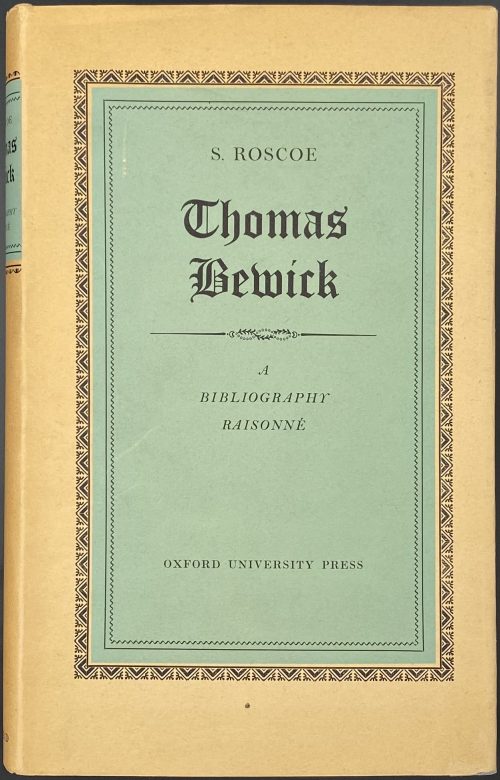 Title: S. ROSCOE | THOMAS BEWICK | A BIBLIOGRAPHY RAISONNÉ | OF EDITIONS OF THE | GENERAL HISTORY OF QUADRUPEDS | THE HISTORY OF BRITISH BIRDS | AND THE | FABLES OF AESOP | ISSUED IN HIS LIFETIME | GEOFFREY CUMBERLEGE | OXFORD UNIVERSITY PRESS | LONDON NEW YORK TORONTO | 1953 || Pagination: [2], [i-iv] v-xxx, 1-198 [2]; collation: 8vo, [a]-b8, B-N8, O4, all plates within collation. Binding: 25.5 x 16.5 cm, tan cloth, black babel with gilt lettering, letterpress dust jacket. Contributors: Roscoe, Sydney – author. Cumberlege, Geoffrey Fenwick Jocelyn (British, 1891 – 1979) – publisher. Batey, Charles – printer
Title: S. ROSCOE | THOMAS BEWICK | A BIBLIOGRAPHY RAISONNÉ | OF EDITIONS OF THE | GENERAL HISTORY OF QUADRUPEDS | THE HISTORY OF BRITISH BIRDS | AND THE | FABLES OF AESOP | ISSUED IN HIS LIFETIME | GEOFFREY CUMBERLEGE | OXFORD UNIVERSITY PRESS | LONDON NEW YORK TORONTO | 1953 || Pagination: [2], [i-iv] v-xxx, 1-198 [2]; collation: 8vo, [a]-b8, B-N8, O4, all plates within collation. Binding: 25.5 x 16.5 cm, tan cloth, black babel with gilt lettering, letterpress dust jacket. Contributors: Roscoe, Sydney – author. Cumberlege, Geoffrey Fenwick Jocelyn (British, 1891 – 1979) – publisher. Batey, Charles – printer -
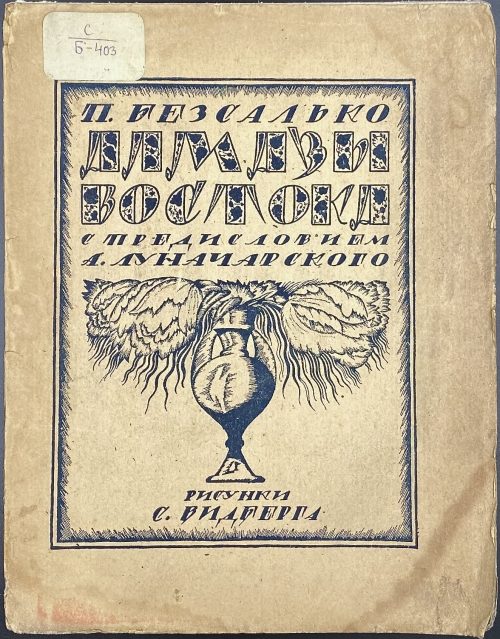 Publisher’s pictorial wrappers, to front wrapper in frame “П. БЕЗСАЛЬКО | АЛМАЗЫ | ВОСТОКА | С ПРЕДИСЛОВИЕМ | А. ЛУНАЧАРСКОГО | {vignette vase with flowers} | РИСУНКИ | С. ВИТБЕРГА || Ex-library book with stamps and stickers. Title page: П. БЕЗСАЛЬКО | АЛМАЗЫ | ВОСТОКА | {publisher’s device «КНИГОИЗДАТЕЛЬСТВО ПЕТРОГРАДСКОГО СОВДЕПА / КНИГА НАРОДУ» | Издание Петроградского Совета | Рабочих и Красн. Депутатов | 1919 || Pagination: [1-4] 5-85 [3], total 88 pages, 12 full-page black and white plates. Collation: 8vo; [1]-58 64, total 44 leaves, plates within collation. Contributors: Безсалько, Павел Карпович (Russian, 1887 – 1920) – author. Луначарский, Анатолий Васильевич (Russian, 1875 – 1933) – author if the foreword. Vidbergs, Sigismunds (Latvian-American, 1890 – 1970) – artist. Бельгова, Полина Борисовна (written "ПОЛИНА БОРИСОВНА ЬЕЛЬГОВА") – dedicatee, unidentified.
Publisher’s pictorial wrappers, to front wrapper in frame “П. БЕЗСАЛЬКО | АЛМАЗЫ | ВОСТОКА | С ПРЕДИСЛОВИЕМ | А. ЛУНАЧАРСКОГО | {vignette vase with flowers} | РИСУНКИ | С. ВИТБЕРГА || Ex-library book with stamps and stickers. Title page: П. БЕЗСАЛЬКО | АЛМАЗЫ | ВОСТОКА | {publisher’s device «КНИГОИЗДАТЕЛЬСТВО ПЕТРОГРАДСКОГО СОВДЕПА / КНИГА НАРОДУ» | Издание Петроградского Совета | Рабочих и Красн. Депутатов | 1919 || Pagination: [1-4] 5-85 [3], total 88 pages, 12 full-page black and white plates. Collation: 8vo; [1]-58 64, total 44 leaves, plates within collation. Contributors: Безсалько, Павел Карпович (Russian, 1887 – 1920) – author. Луначарский, Анатолий Васильевич (Russian, 1875 – 1933) – author if the foreword. Vidbergs, Sigismunds (Latvian-American, 1890 – 1970) – artist. Бельгова, Полина Борисовна (written "ПОЛИНА БОРИСОВНА ЬЕЛЬГОВА") – dedicatee, unidentified. -
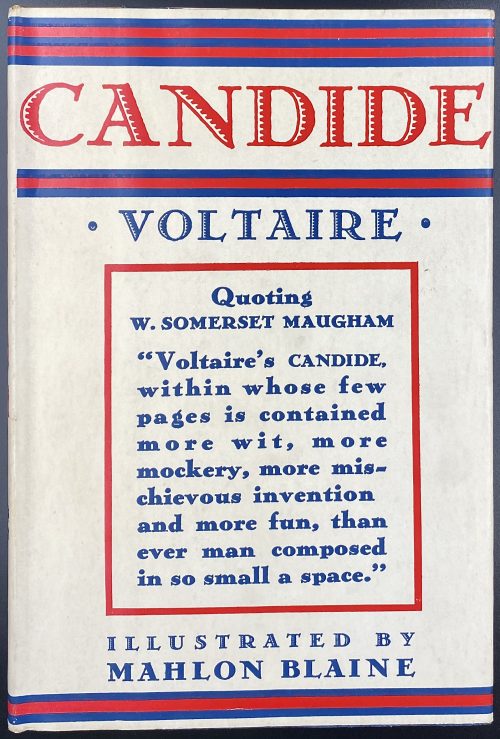 Title (chain border): CANDIDE | VOLTAIRE | ILLUSTRATIONS BY | MAHLON BLAINE | {vignette} | NEW YORK | Illustrated Editions Company | 220 FOURTH AVENUE || Title verso: (top) COPYRIGHT, 1930, BY WILLIAMS, BELASCO & MEYERS || (bottom) PRINTED IN THE UNITED STATES OF AMERICA | BY J. J. LITTLE & IVES COMPANY, NEW YORK || Pagination:[1-7] 8-144, headpiece, frontispiece and 5 plates after Blaine’s pen drawings, within the pagination; tailpieces by A. Zaidenberg. Binding: 21 x 14 cm; quarter beige buckram over blue cloth, stamped-gilt and red lettering and vignette to front board and spine. Binding in a way similar to Sterne's A sentimental journey published by Three Sirens Press in c. 1930 [LIB-2784.2021]. Not only that: tailpieces in this Illustrated Editions Company edition are the same as in Cameo Classic edition, with the only difference – here the name of the artist is stated, whether in the Cameo Classic it is not; see [LIB-2777.2021]. Bear in mind that Cameo Classic does not belong to Williams, Belasco and Meyers, it is a Grosset and Dunlap series; a cream dust-jacket lettered in red and blue, and with a citation from W. Somerset Maugham; all edges red. Compare with LIB-2791.2021. Illustrations in the current copy are exactly the same. Compare Williams, Belasco and Meyers Candide and Illustrated Editions Company Candide title pages:
Title (chain border): CANDIDE | VOLTAIRE | ILLUSTRATIONS BY | MAHLON BLAINE | {vignette} | NEW YORK | Illustrated Editions Company | 220 FOURTH AVENUE || Title verso: (top) COPYRIGHT, 1930, BY WILLIAMS, BELASCO & MEYERS || (bottom) PRINTED IN THE UNITED STATES OF AMERICA | BY J. J. LITTLE & IVES COMPANY, NEW YORK || Pagination:[1-7] 8-144, headpiece, frontispiece and 5 plates after Blaine’s pen drawings, within the pagination; tailpieces by A. Zaidenberg. Binding: 21 x 14 cm; quarter beige buckram over blue cloth, stamped-gilt and red lettering and vignette to front board and spine. Binding in a way similar to Sterne's A sentimental journey published by Three Sirens Press in c. 1930 [LIB-2784.2021]. Not only that: tailpieces in this Illustrated Editions Company edition are the same as in Cameo Classic edition, with the only difference – here the name of the artist is stated, whether in the Cameo Classic it is not; see [LIB-2777.2021]. Bear in mind that Cameo Classic does not belong to Williams, Belasco and Meyers, it is a Grosset and Dunlap series; a cream dust-jacket lettered in red and blue, and with a citation from W. Somerset Maugham; all edges red. Compare with LIB-2791.2021. Illustrations in the current copy are exactly the same. Compare Williams, Belasco and Meyers Candide and Illustrated Editions Company Candide title pages: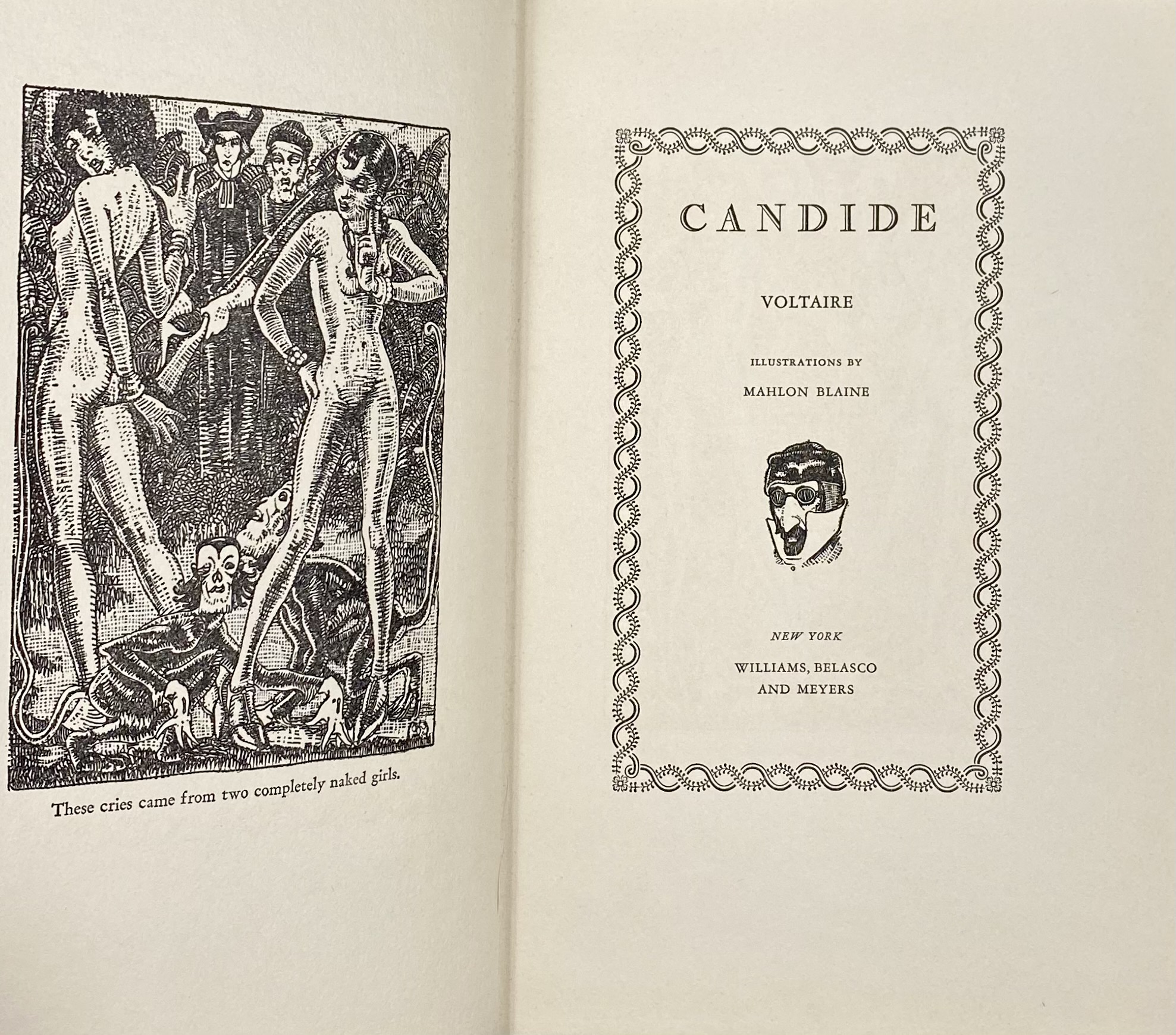
Williams, Belasco and Meyers
Arouet, François-Marie [Voltaire] (French, 1694 – 1778)– author. Woolf, Herman Irwell [Chambers, Dorset] (British, 1890 – 1958) – translator. Blaine, Mahlon [Hudson, G. Christopher] (American, 1894 – 1969) – illustrator. Zaidenberg, Arthur (American, 1902 – 1990) – illustrator. Williams, Belasco and Meyers (NY) – copyright holder. Illustrated Editions Company (1929-1942) – publisher. J. J. Little & Ives Company (NY) – printer. See the Cameo Classic reprint [LIB-2777.2021].
Illustrated Editions Company
-
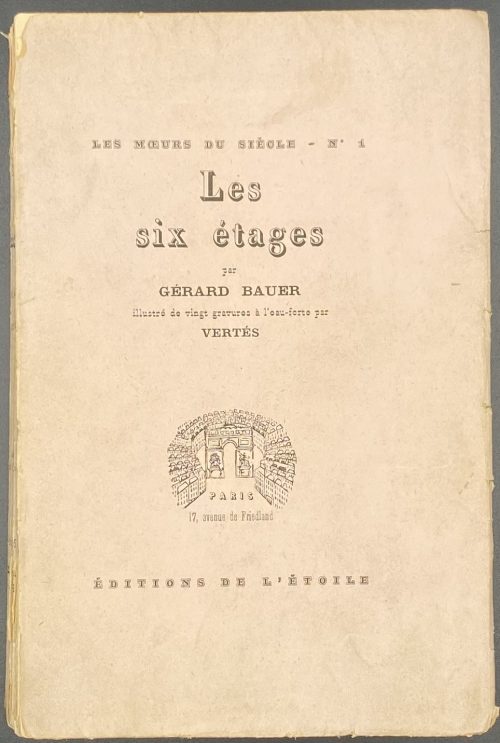 Front wrapper: LES MŒURS DU SIECLE - № 1 | Les | six étages | par | GERARD BAUER | illustré de vingt gravures à l’eau-forte | par VERTÈS | {publisher’s device, “PARIS | 17, avenue de Friedland”} | ÉDITIONS DE L’ÉTOILE || Title-page: essais pour servir a1 l’histoire contemporaine | de la galanterie et du plaisir | I | Les six étages | par | GERARD BAUER | illustré de vingt gravures à l’eau-forte | par VERTÈS | | {publisher’s device, “ÉDITIONS DE L’ÉTOILE | 17, avenue de Friedland”} | PARIS […] MCMXXV || Pagination: front wrapper with lettering, [1-8] incl. 1st bank leaf, h.t. / limitation, t.p. / blank, dedication to Abel Hermant / blank, 9-169 [170] [6] incl. table, colophon, and last blank leaf, 17 etchings by Vertès within pagination; advert. of the other books of the series to the back wrapper. Edition: 15 copies on Japon Impérial (№ 1-15), 35 on Hollande Van Gelder Zonen (№ 16-50), 400 on Vélin de Rives BFK (№ 51-450) and 3 on blue paper not for sale. This copy is № 369. Printed on November 10, 1925 by L. Petitbarat in Saint-Ouen-l’Aumône (text) and by Vernant in Paris (etchings). Edition directed by Roger Allard. Binding: 19 x 12.5 cm, French flapped pink wrappers, lettered to front, back, and spine. Contributors: Gérard Bauër (French, 1888 – 1967) – author. Marcel Vertès [Marcell Vértes] (Jewish-Hungarian-French, 1895 – 1961) – artist. Abel Hermant (French, 1862 – 1950) – dedicatee. Roger Allard (French, 1885 – 1961) – editor. L. Petitbarat (Saint-Ouen-l’Aumône) – printer. Éditions de l’Étoile (Paris) – publisher. Other names: Marcel Vertès, Marcel Vertes, Marcell Vértes
Front wrapper: LES MŒURS DU SIECLE - № 1 | Les | six étages | par | GERARD BAUER | illustré de vingt gravures à l’eau-forte | par VERTÈS | {publisher’s device, “PARIS | 17, avenue de Friedland”} | ÉDITIONS DE L’ÉTOILE || Title-page: essais pour servir a1 l’histoire contemporaine | de la galanterie et du plaisir | I | Les six étages | par | GERARD BAUER | illustré de vingt gravures à l’eau-forte | par VERTÈS | | {publisher’s device, “ÉDITIONS DE L’ÉTOILE | 17, avenue de Friedland”} | PARIS […] MCMXXV || Pagination: front wrapper with lettering, [1-8] incl. 1st bank leaf, h.t. / limitation, t.p. / blank, dedication to Abel Hermant / blank, 9-169 [170] [6] incl. table, colophon, and last blank leaf, 17 etchings by Vertès within pagination; advert. of the other books of the series to the back wrapper. Edition: 15 copies on Japon Impérial (№ 1-15), 35 on Hollande Van Gelder Zonen (№ 16-50), 400 on Vélin de Rives BFK (№ 51-450) and 3 on blue paper not for sale. This copy is № 369. Printed on November 10, 1925 by L. Petitbarat in Saint-Ouen-l’Aumône (text) and by Vernant in Paris (etchings). Edition directed by Roger Allard. Binding: 19 x 12.5 cm, French flapped pink wrappers, lettered to front, back, and spine. Contributors: Gérard Bauër (French, 1888 – 1967) – author. Marcel Vertès [Marcell Vértes] (Jewish-Hungarian-French, 1895 – 1961) – artist. Abel Hermant (French, 1862 – 1950) – dedicatee. Roger Allard (French, 1885 – 1961) – editor. L. Petitbarat (Saint-Ouen-l’Aumône) – printer. Éditions de l’Étoile (Paris) – publisher. Other names: Marcel Vertès, Marcel Vertes, Marcell Vértes -
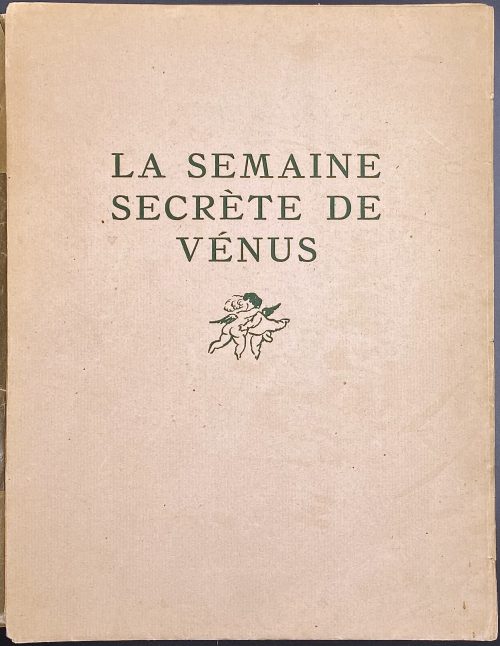 Description: Publisher’s tan French flapped wrappers, in glassine DJ, 25.4 x 19.4 cm, collated in-4to, lettered LA SEMAINE | SECRÈTE DE | VÉNUS | {fleuron} ||, outer margin uncut. Title-page: ≈ | LA SEMAINE | SECRÈTE | DE VÉNUS | Illustrée de huit Dessins | originaux reproduits en | lithographie et coloriés | {vignette} | LA CHRONIQUE CLANDESTINE | ≈ de 1919 à 1925 ≈ || Limitation: Unique copy on Vieux Japon enriched with original drawings and suites of plates, № 1-25 on Japon Imperial, enriched with 1 drawing and 3 suites of plates, № 26-275 on vélin d’Arches «avec les sept lithos en couleurs»; total print run – 275+1. This is copy № 70. Collation: π3 (blank, h.t./limit., t.p.), 1-154 χ1, total 64 leaves plus 7 plates, lithographs after drawings by Marcel Vertès, extraneous to collation. Note: Eight lithographs stated in the title are 7 plates AND a vignette on the title page. Vokaer attributes the printer/publisher as "Imprimerie Daragnès" and the year of publication as 1925. Pagination: [6] 2 blanks, 2 h.t. / limit., 2 t.p., [1-2] 3-115 [7] ; total 128 pages plus ils. Catalogue raisonné: Dutel (1920-1970): № 2386; Pia (Enfer) 1317; Nordmann (1): 246; Vokaer (1967): 8, Contributors : Pierre Mac-Orlan (French, 1882 – 1970) – author. Marcel Vertès [Marcell Vértes] (Jewish-Hungarian-French, 1895 – 1961) – artist. Paul Cotinaud – publisher (per Dutel) Coulouma (Argenteuil) – printer (per Dutel).
Description: Publisher’s tan French flapped wrappers, in glassine DJ, 25.4 x 19.4 cm, collated in-4to, lettered LA SEMAINE | SECRÈTE DE | VÉNUS | {fleuron} ||, outer margin uncut. Title-page: ≈ | LA SEMAINE | SECRÈTE | DE VÉNUS | Illustrée de huit Dessins | originaux reproduits en | lithographie et coloriés | {vignette} | LA CHRONIQUE CLANDESTINE | ≈ de 1919 à 1925 ≈ || Limitation: Unique copy on Vieux Japon enriched with original drawings and suites of plates, № 1-25 on Japon Imperial, enriched with 1 drawing and 3 suites of plates, № 26-275 on vélin d’Arches «avec les sept lithos en couleurs»; total print run – 275+1. This is copy № 70. Collation: π3 (blank, h.t./limit., t.p.), 1-154 χ1, total 64 leaves plus 7 plates, lithographs after drawings by Marcel Vertès, extraneous to collation. Note: Eight lithographs stated in the title are 7 plates AND a vignette on the title page. Vokaer attributes the printer/publisher as "Imprimerie Daragnès" and the year of publication as 1925. Pagination: [6] 2 blanks, 2 h.t. / limit., 2 t.p., [1-2] 3-115 [7] ; total 128 pages plus ils. Catalogue raisonné: Dutel (1920-1970): № 2386; Pia (Enfer) 1317; Nordmann (1): 246; Vokaer (1967): 8, Contributors : Pierre Mac-Orlan (French, 1882 – 1970) – author. Marcel Vertès [Marcell Vértes] (Jewish-Hungarian-French, 1895 – 1961) – artist. Paul Cotinaud – publisher (per Dutel) Coulouma (Argenteuil) – printer (per Dutel).


